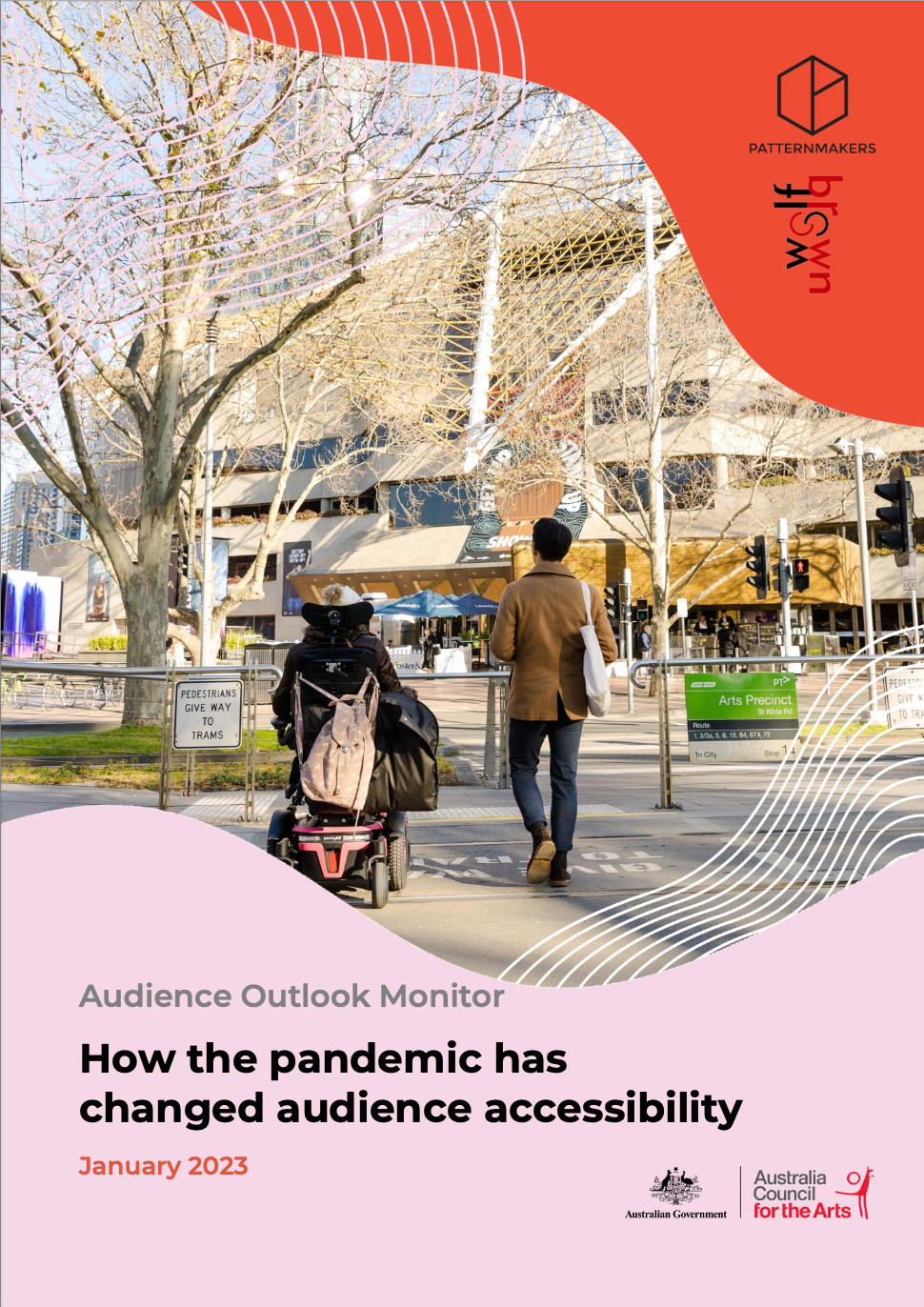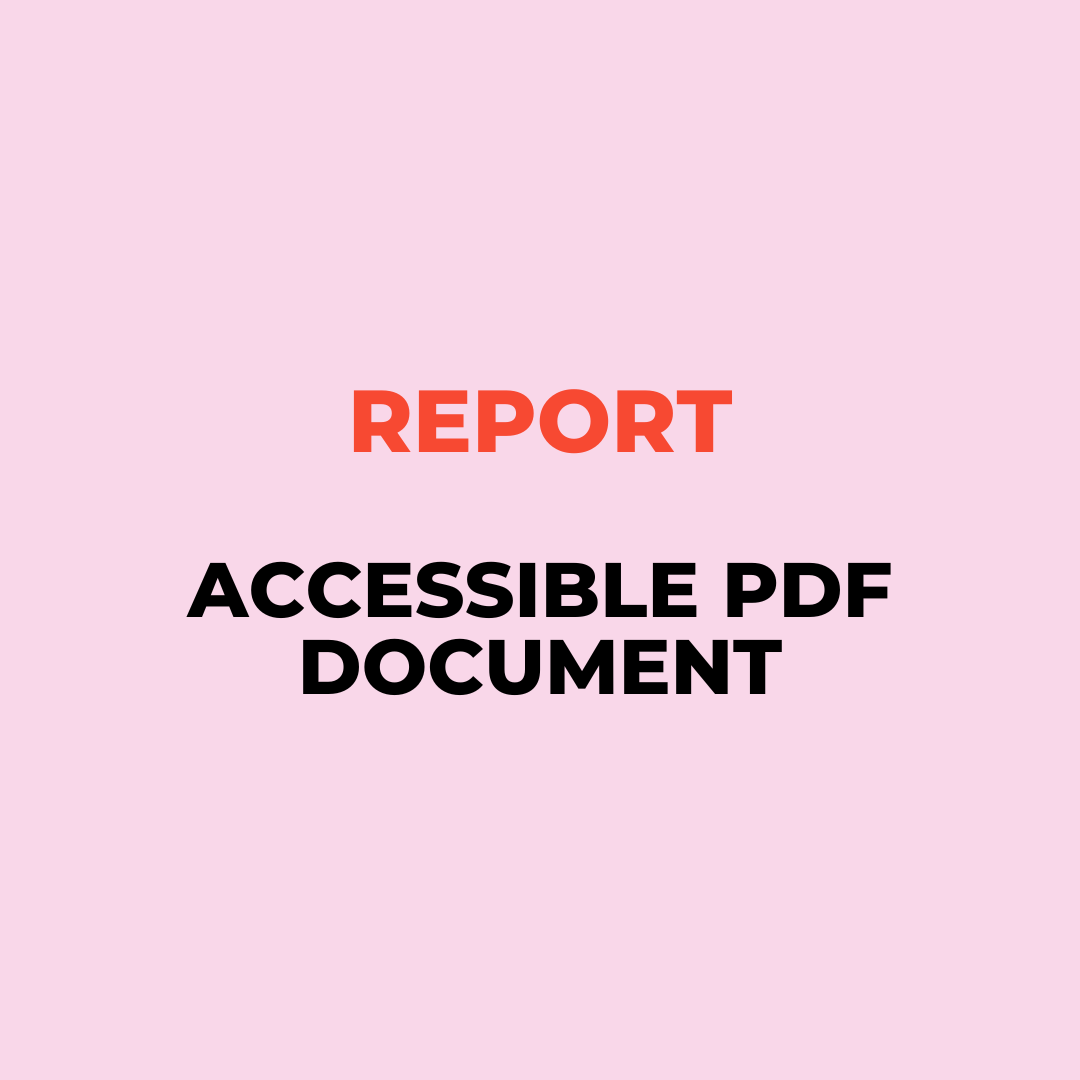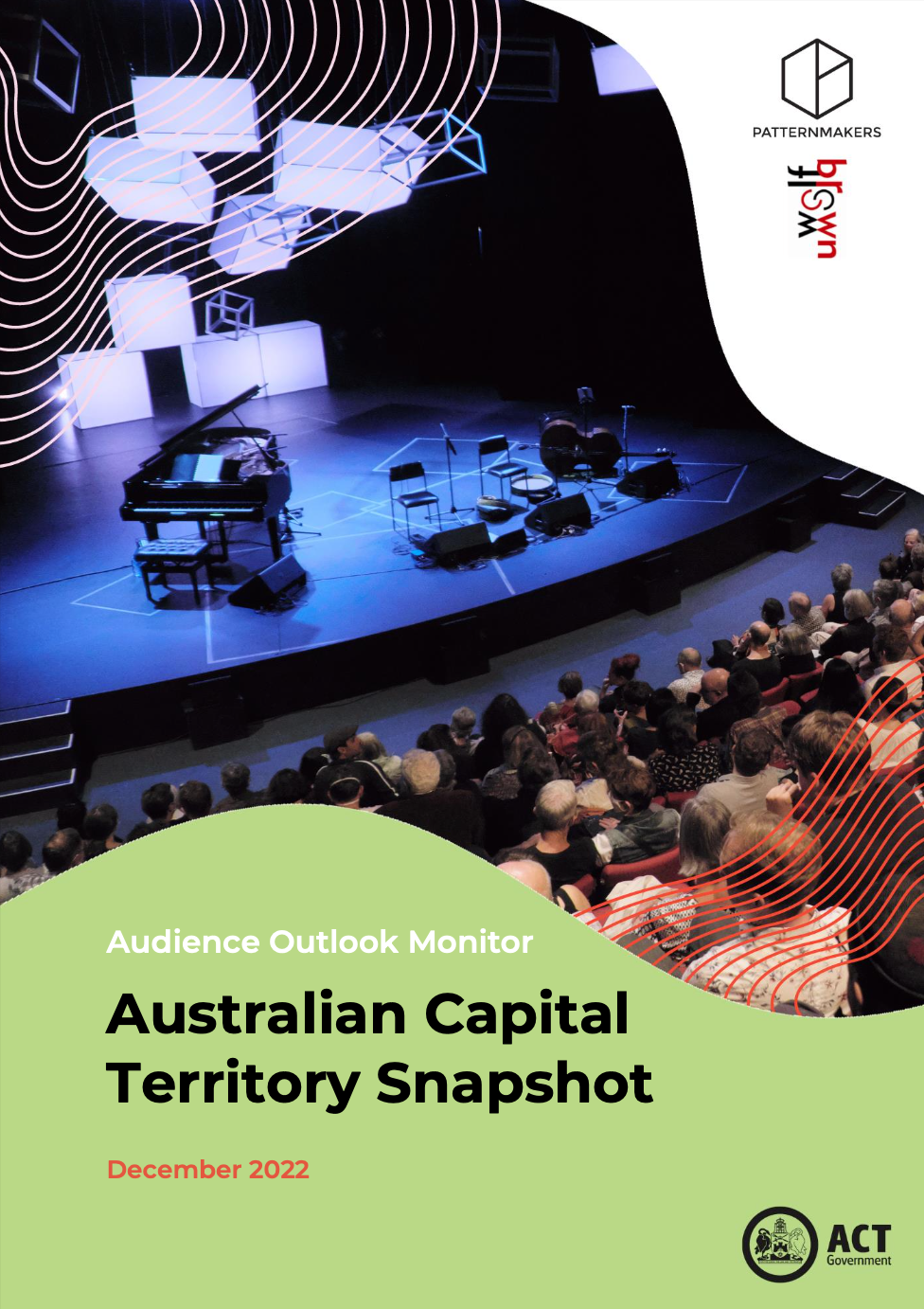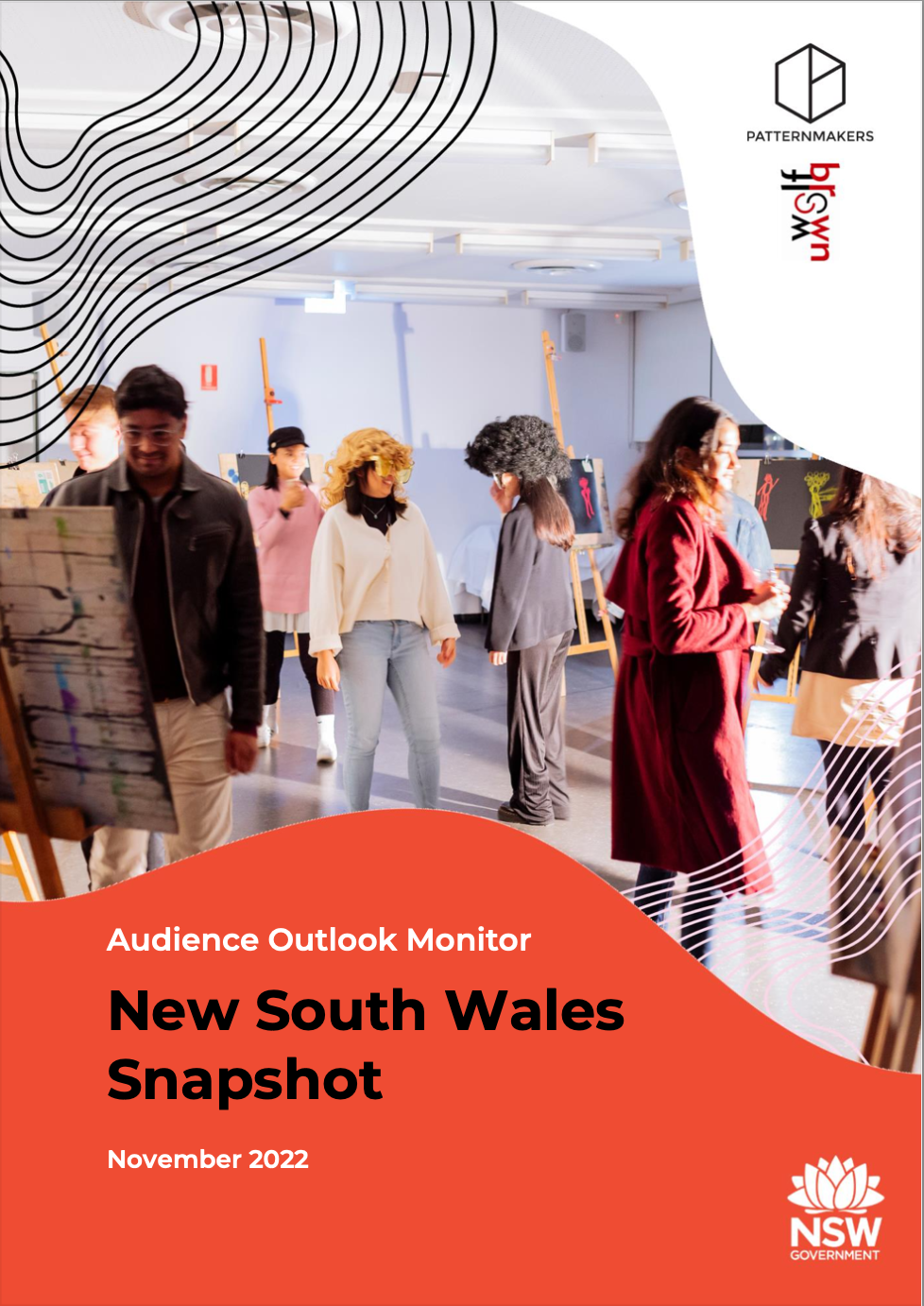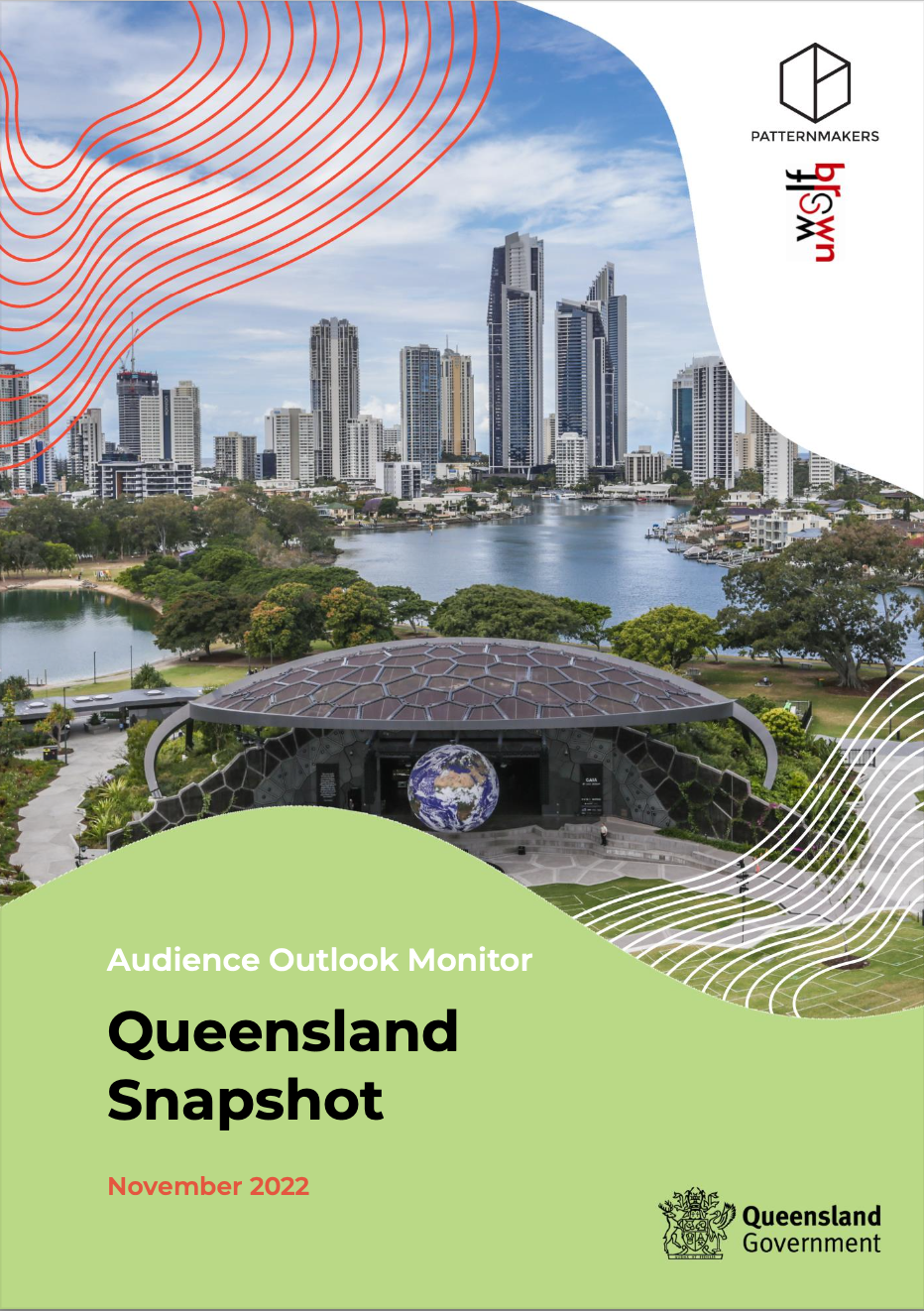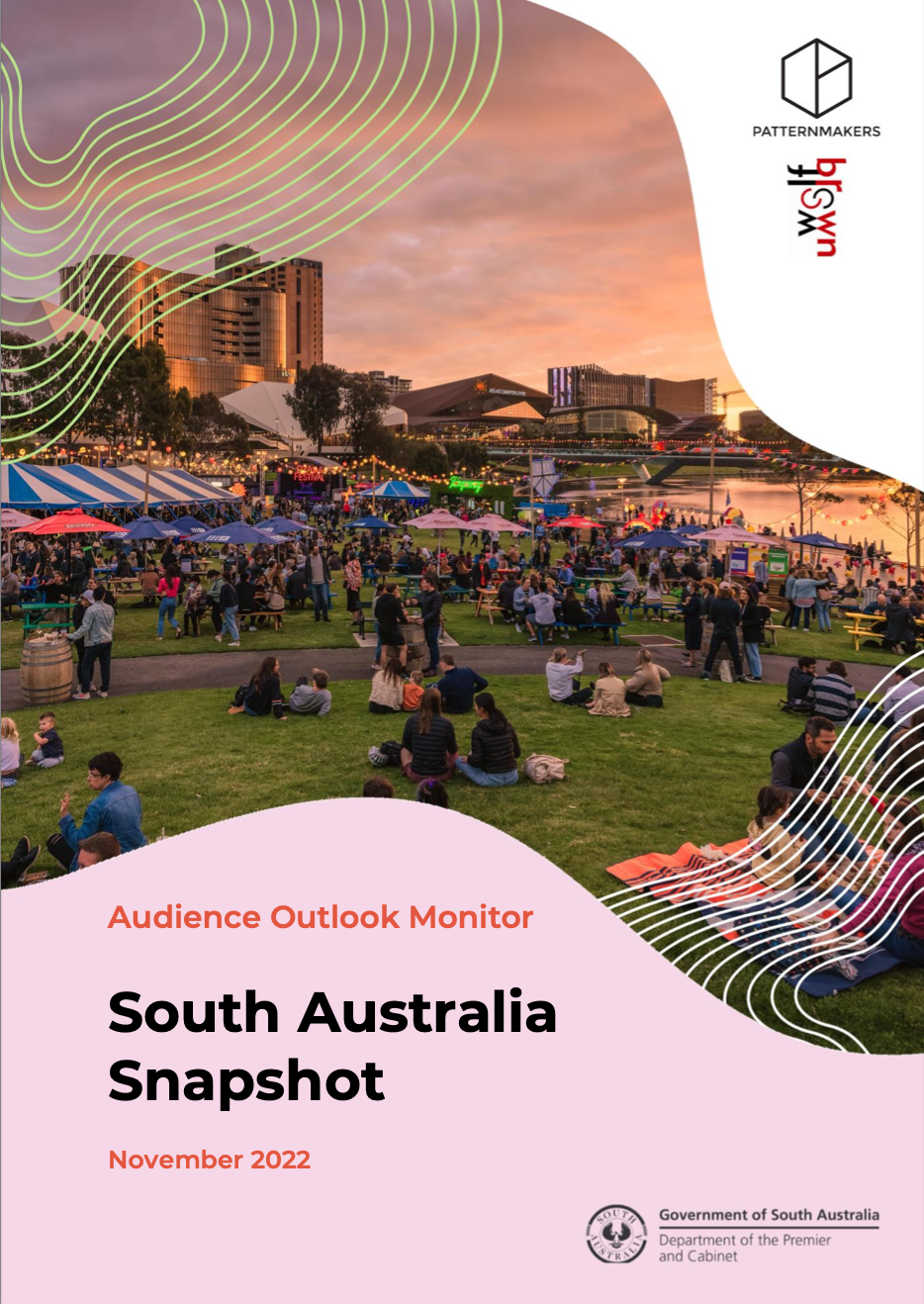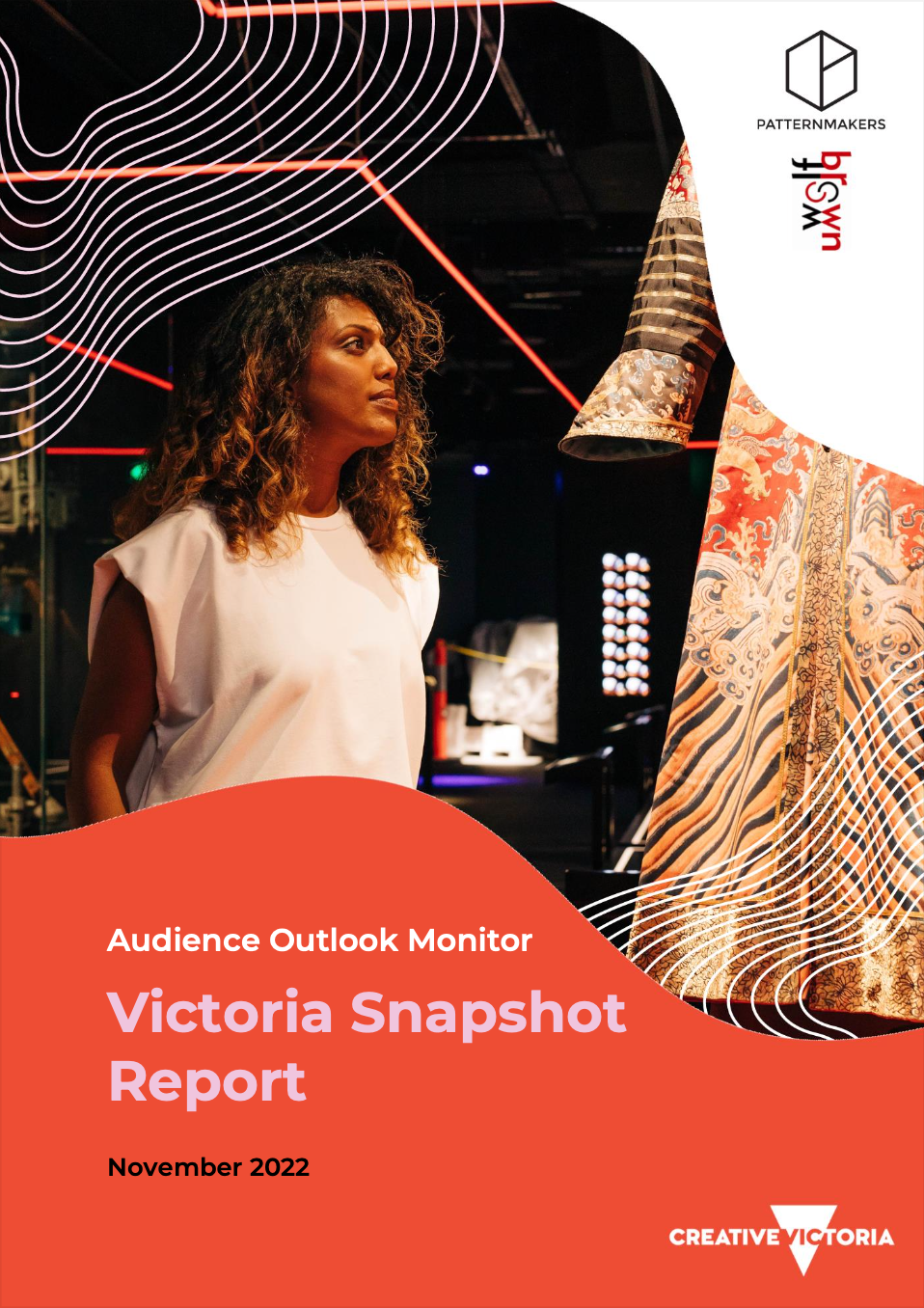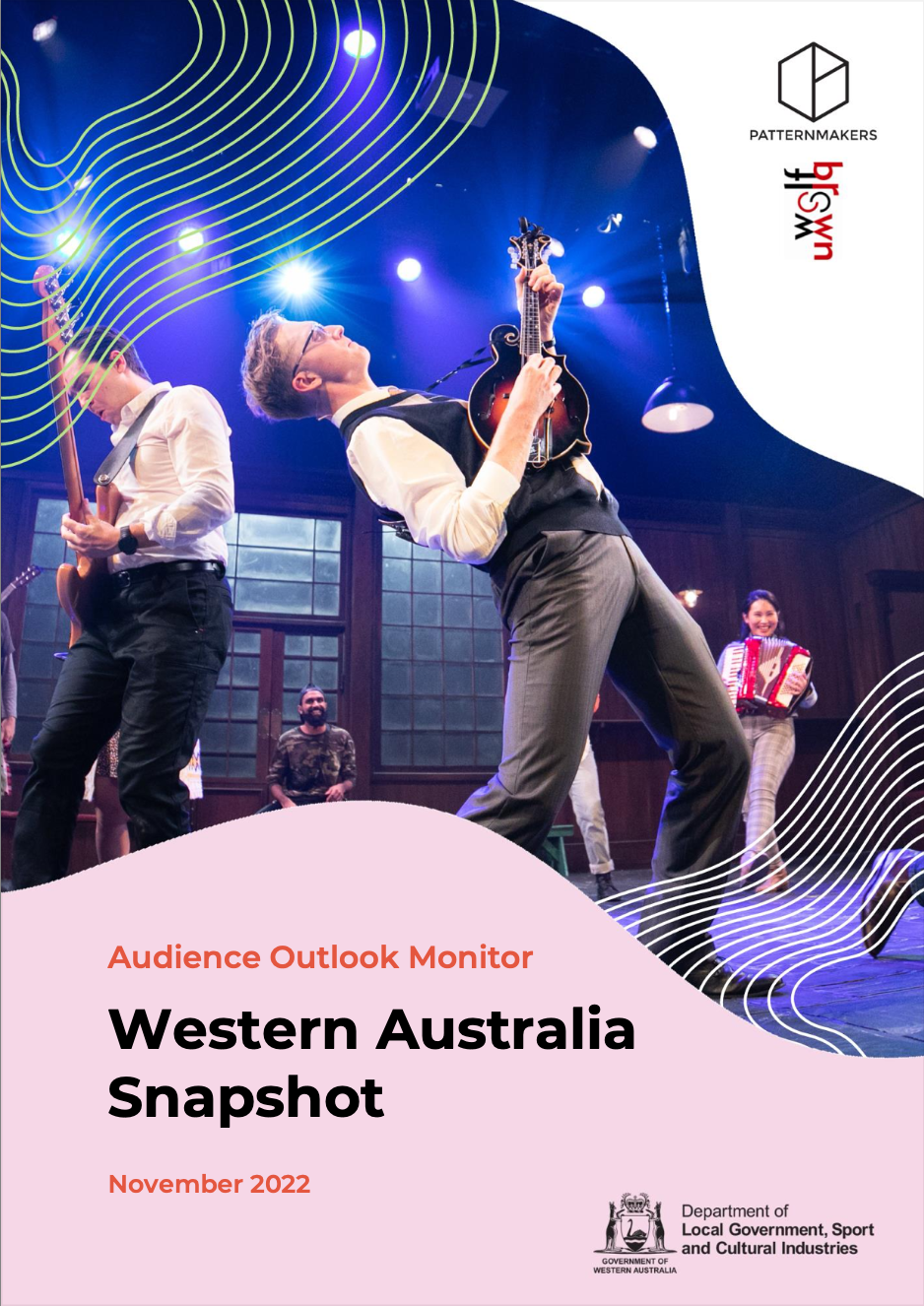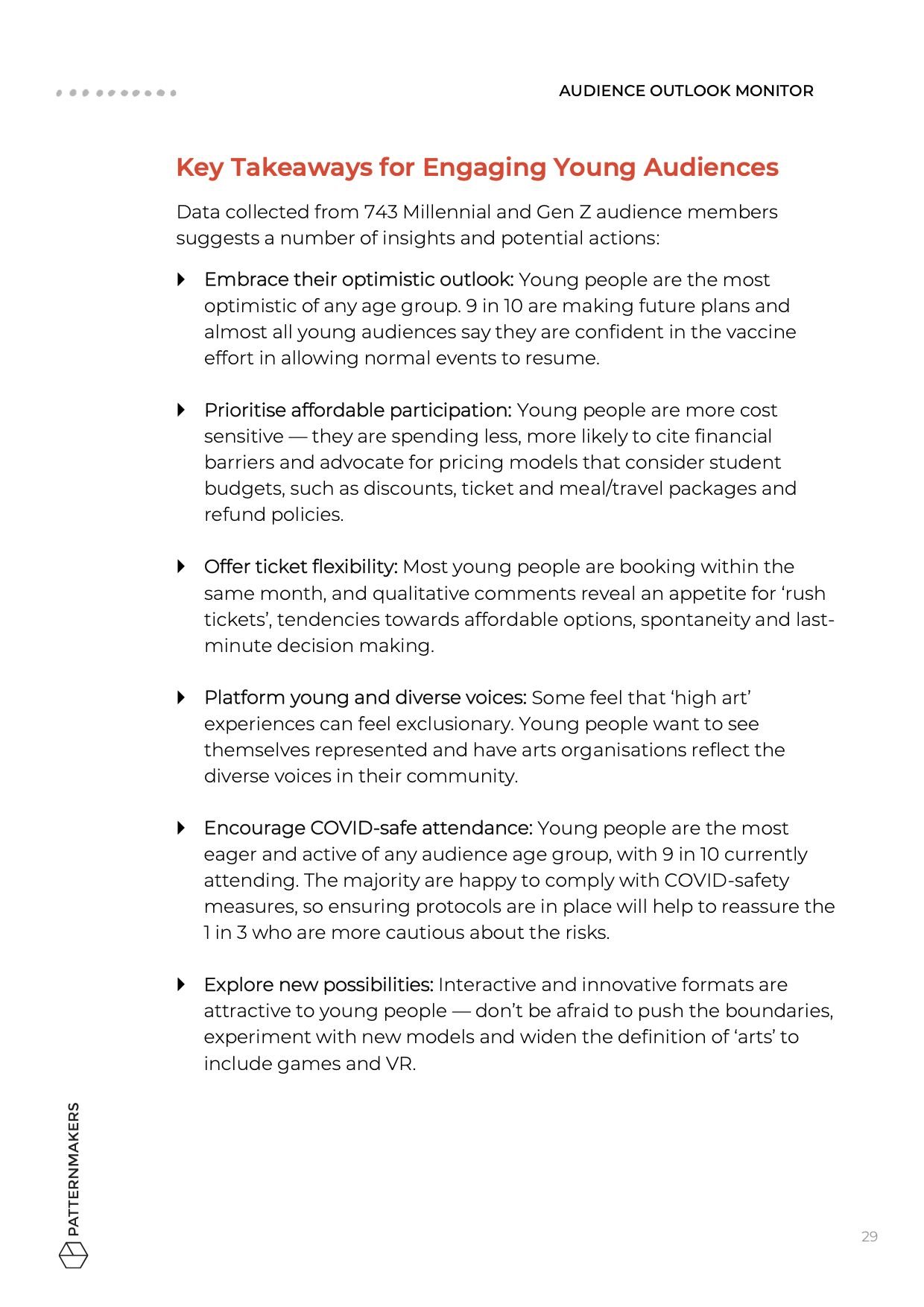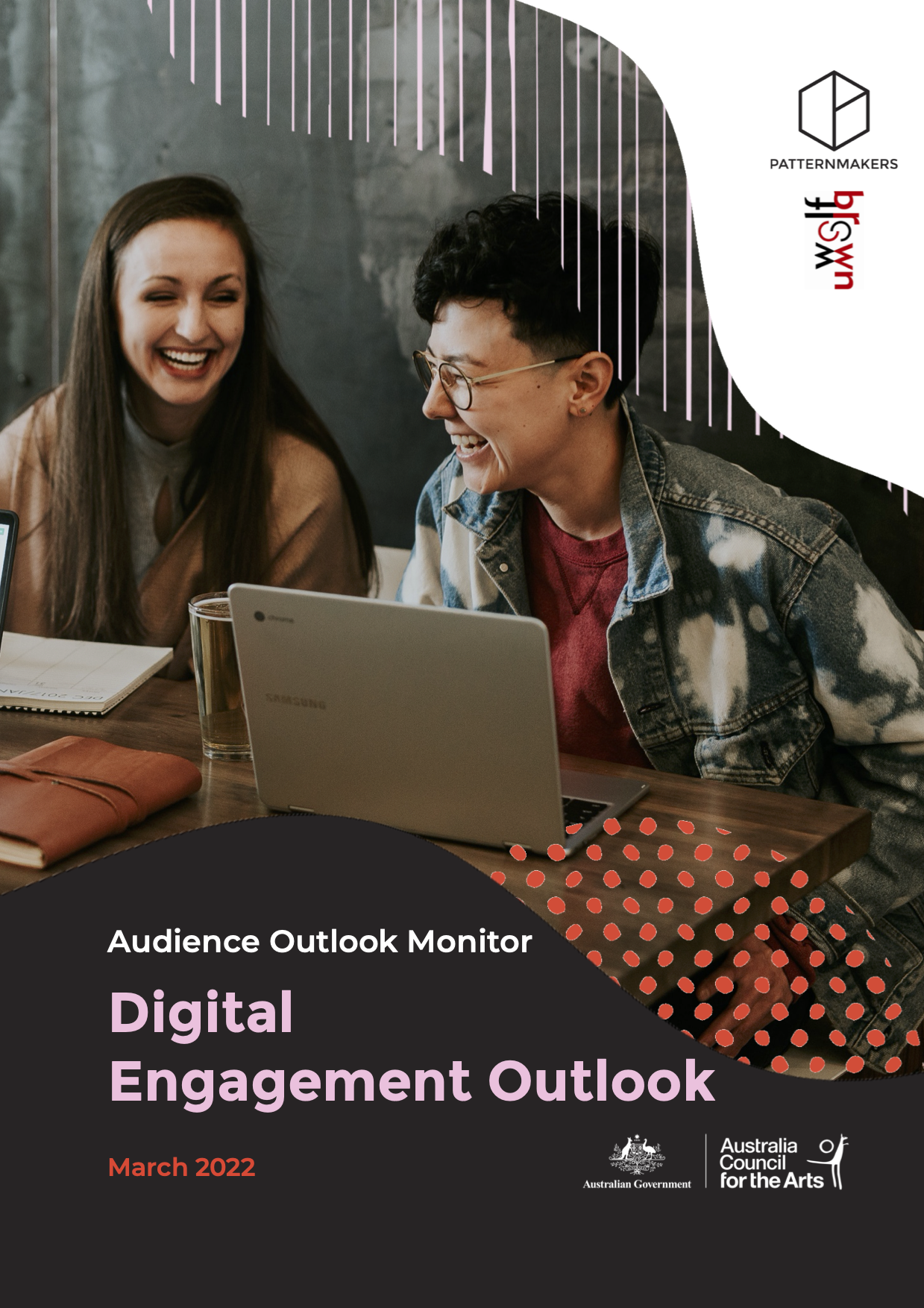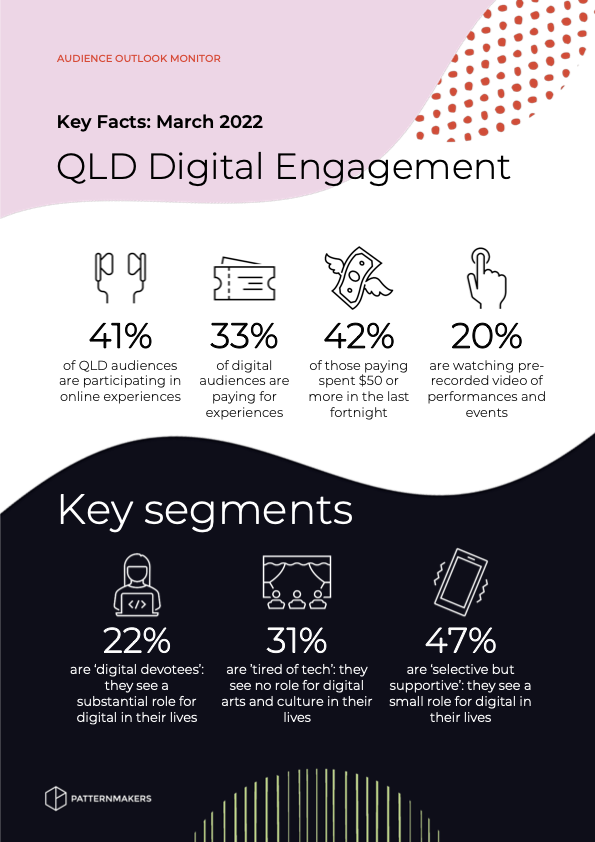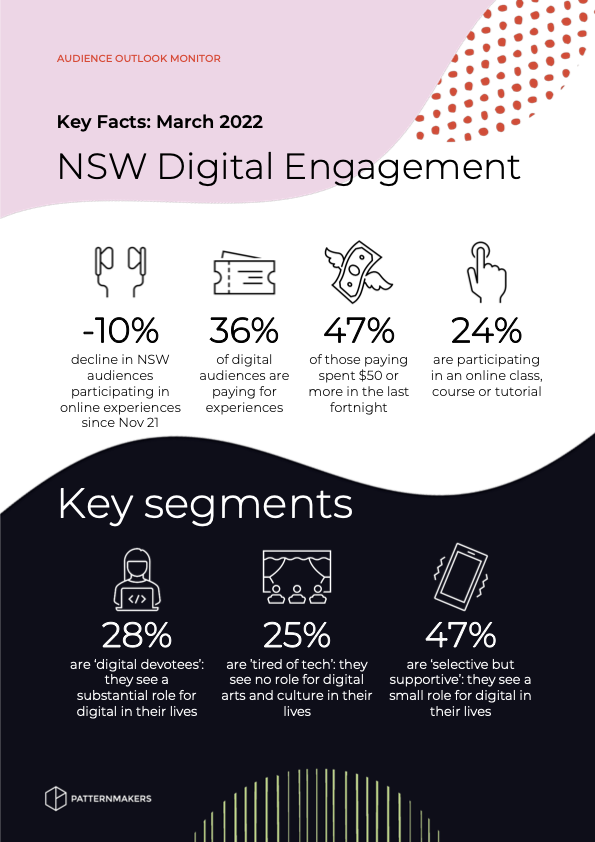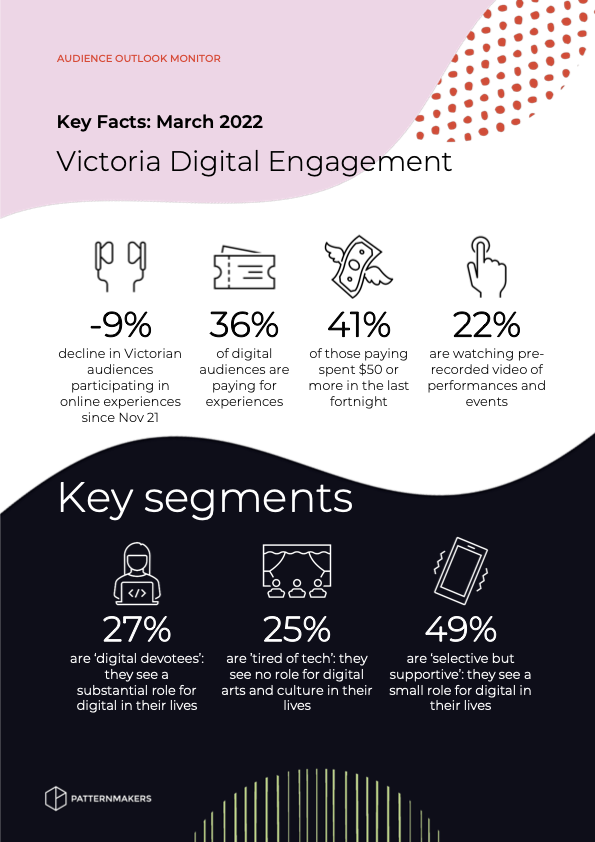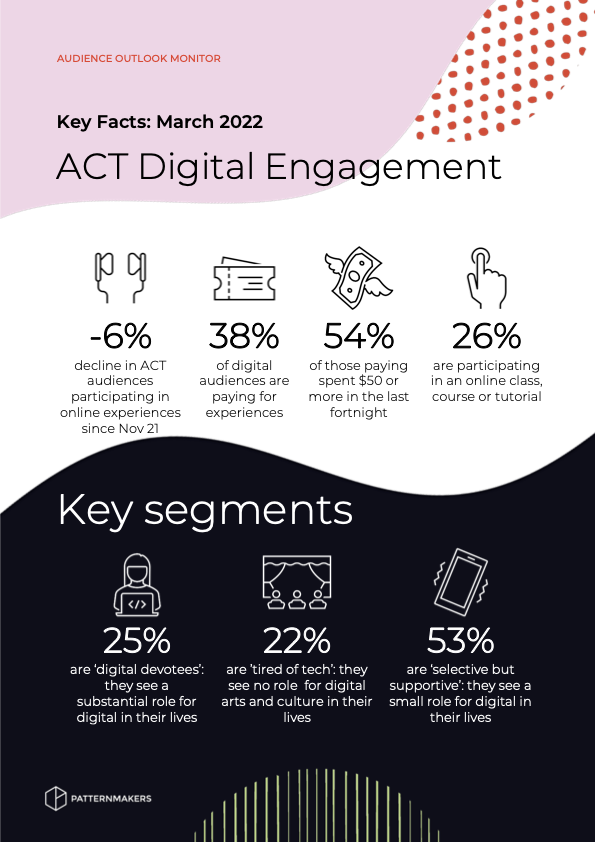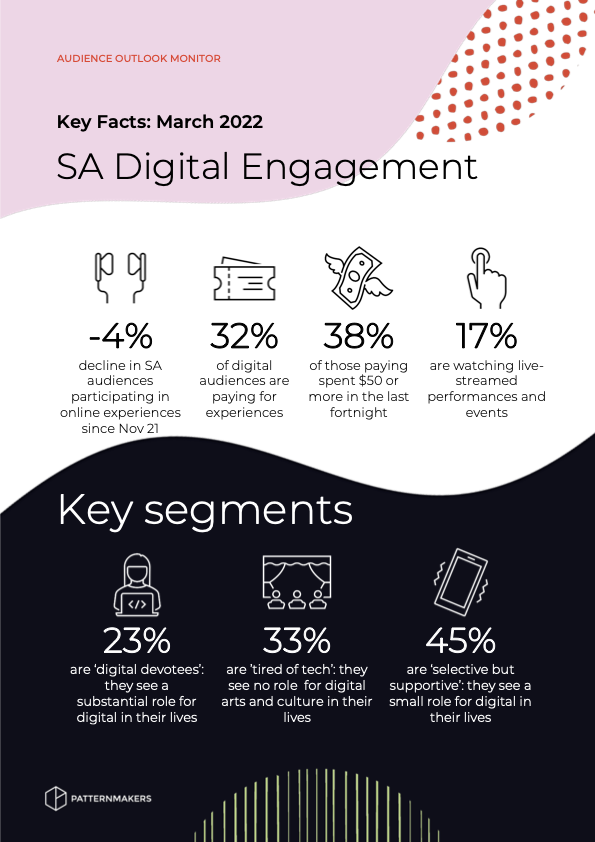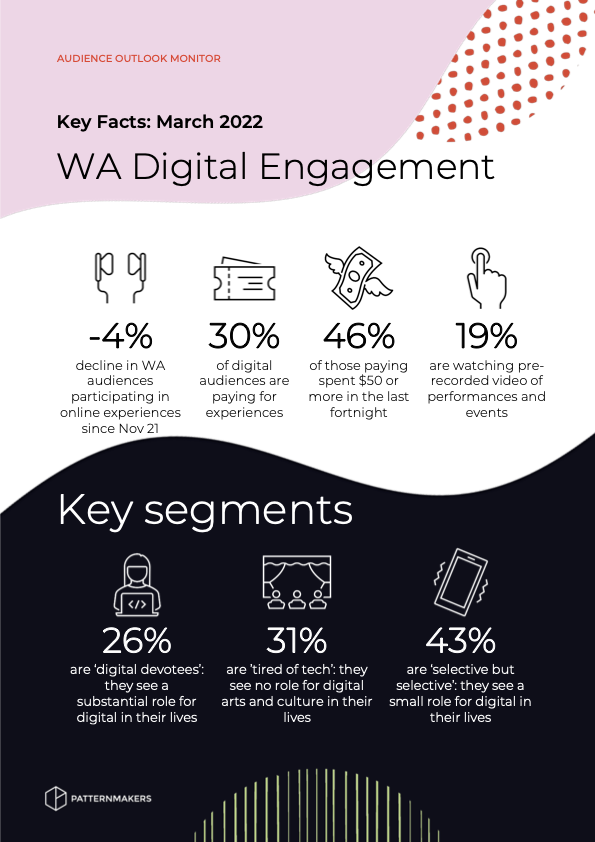City lights to red dirt: Connecting with audiences across Australia
In this Audience Outlook Monitor report, ‘City Lights to Red Dirt’, we look at the geographic trends in data collected from past attendees to cultural events, comparing audiences in big cities, outer suburbs and the regions.
Our cities, suburbs and regions are different places today and audiences are responding in interesting ways.
Attendees of arts and cultural events are feeling the pressure of the housing crisis, changing work and commuting patterns, navigating weather events and approaching travel and leisure differently.
In this new report, ‘City Lights to Red Dirt’, we look at the geographic trends in data collected from past audiences of cultural events.






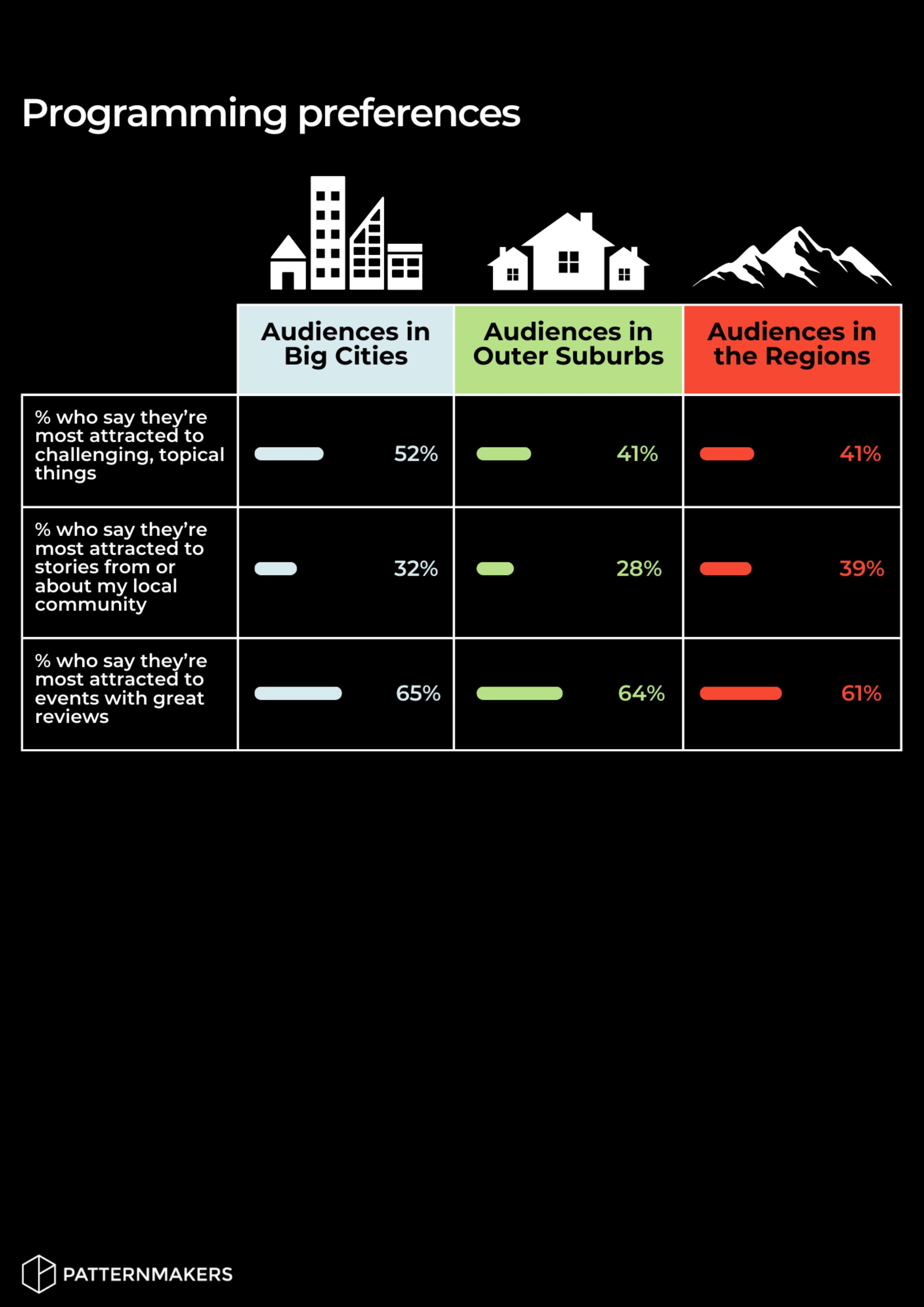
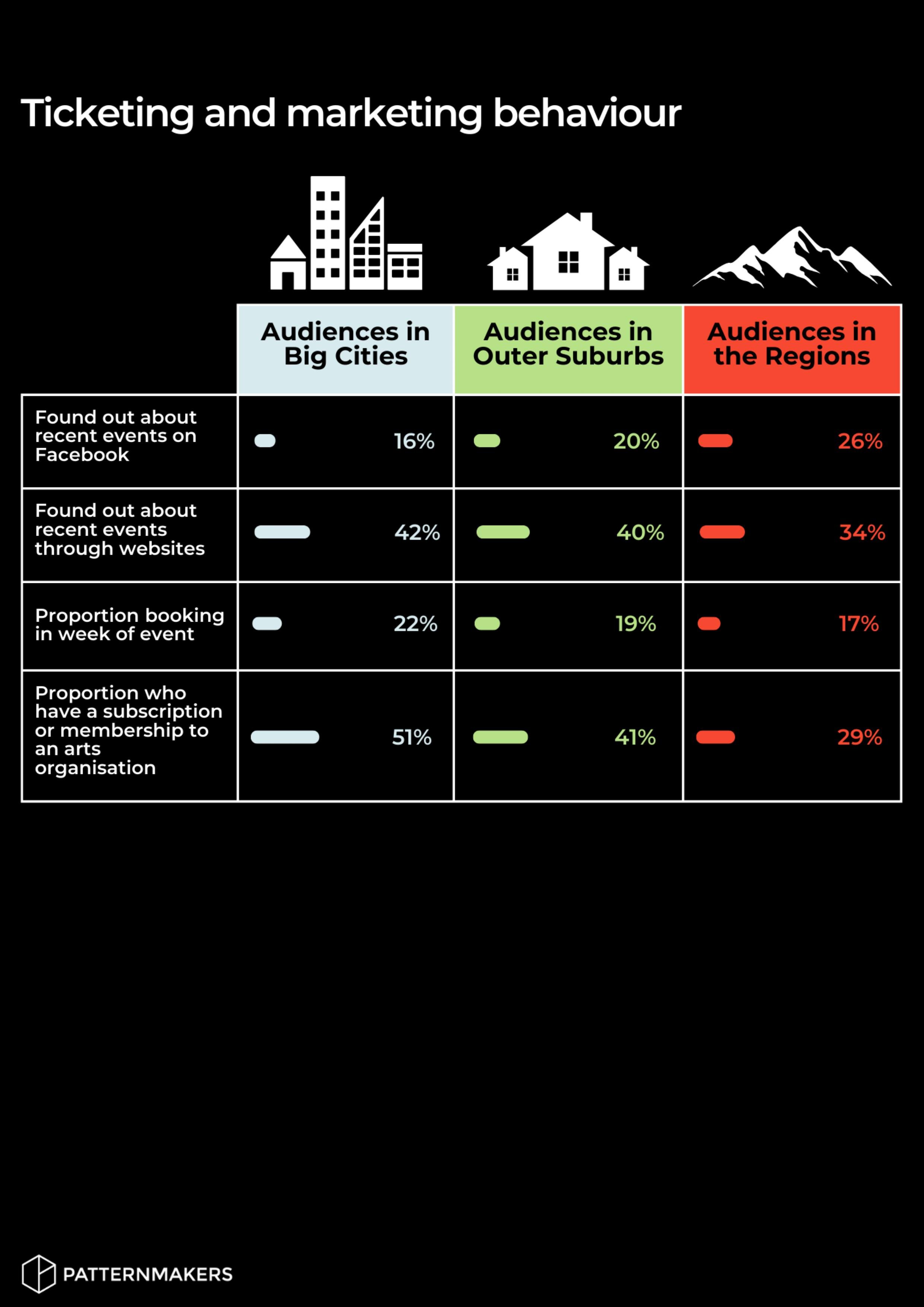
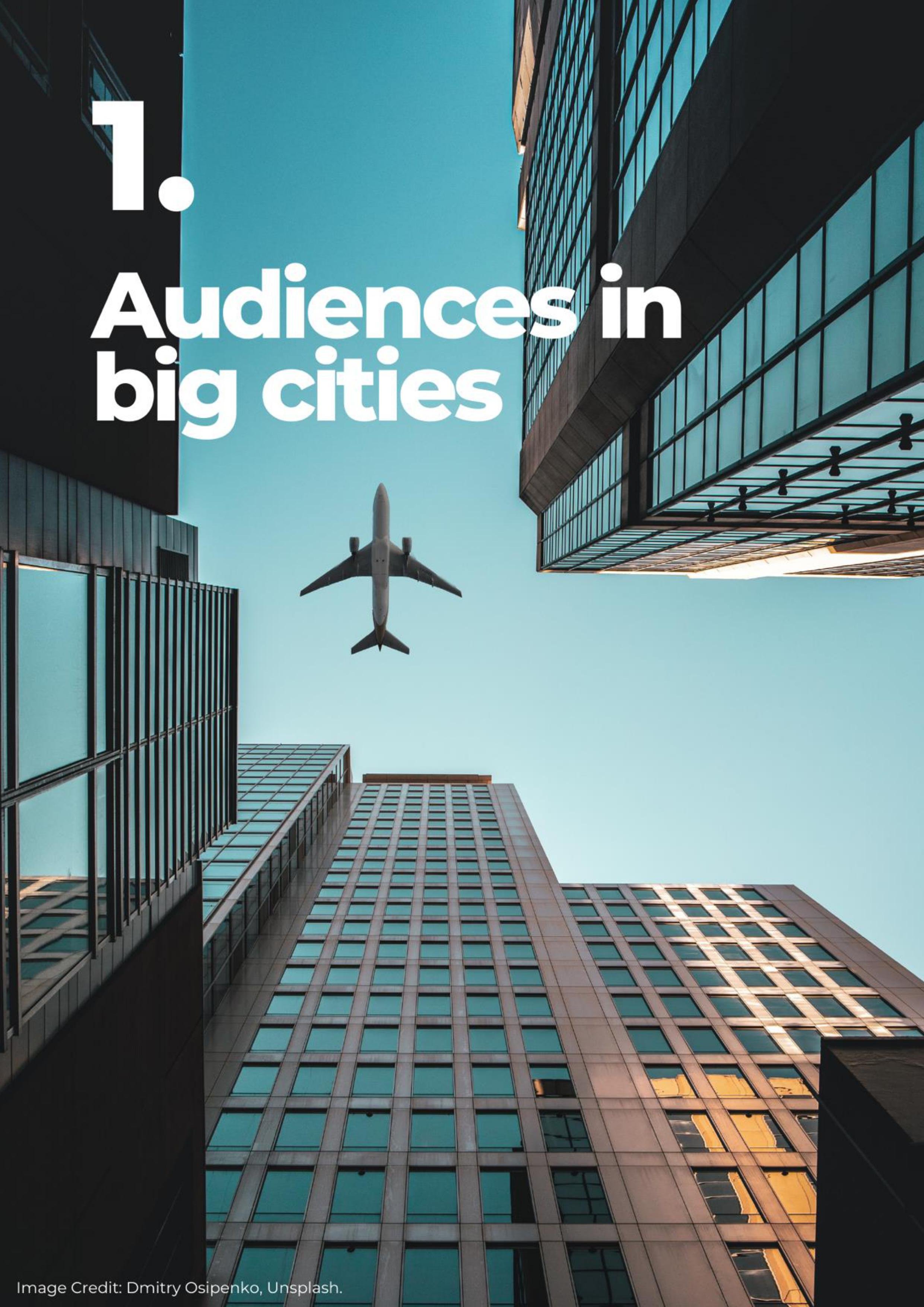


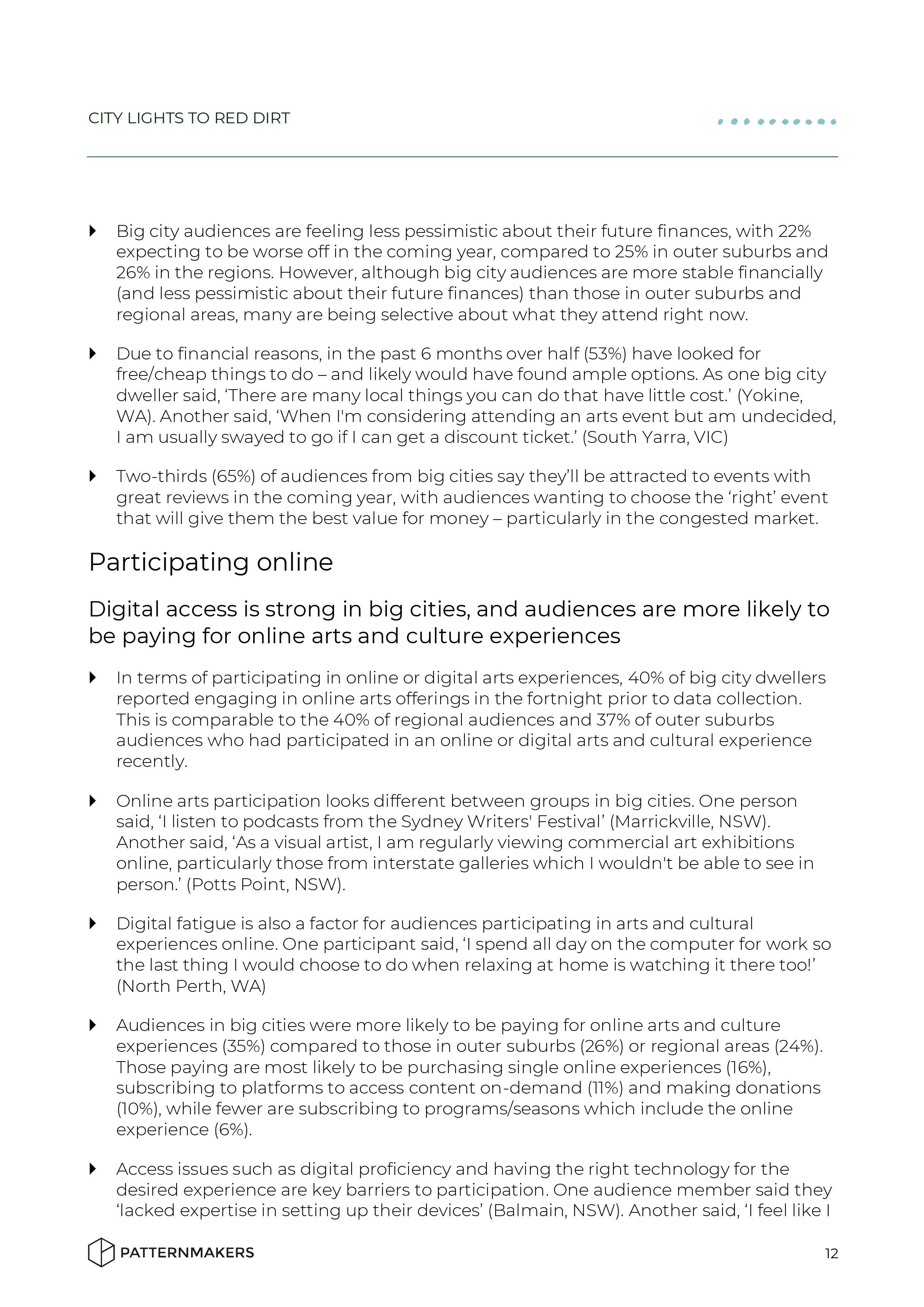
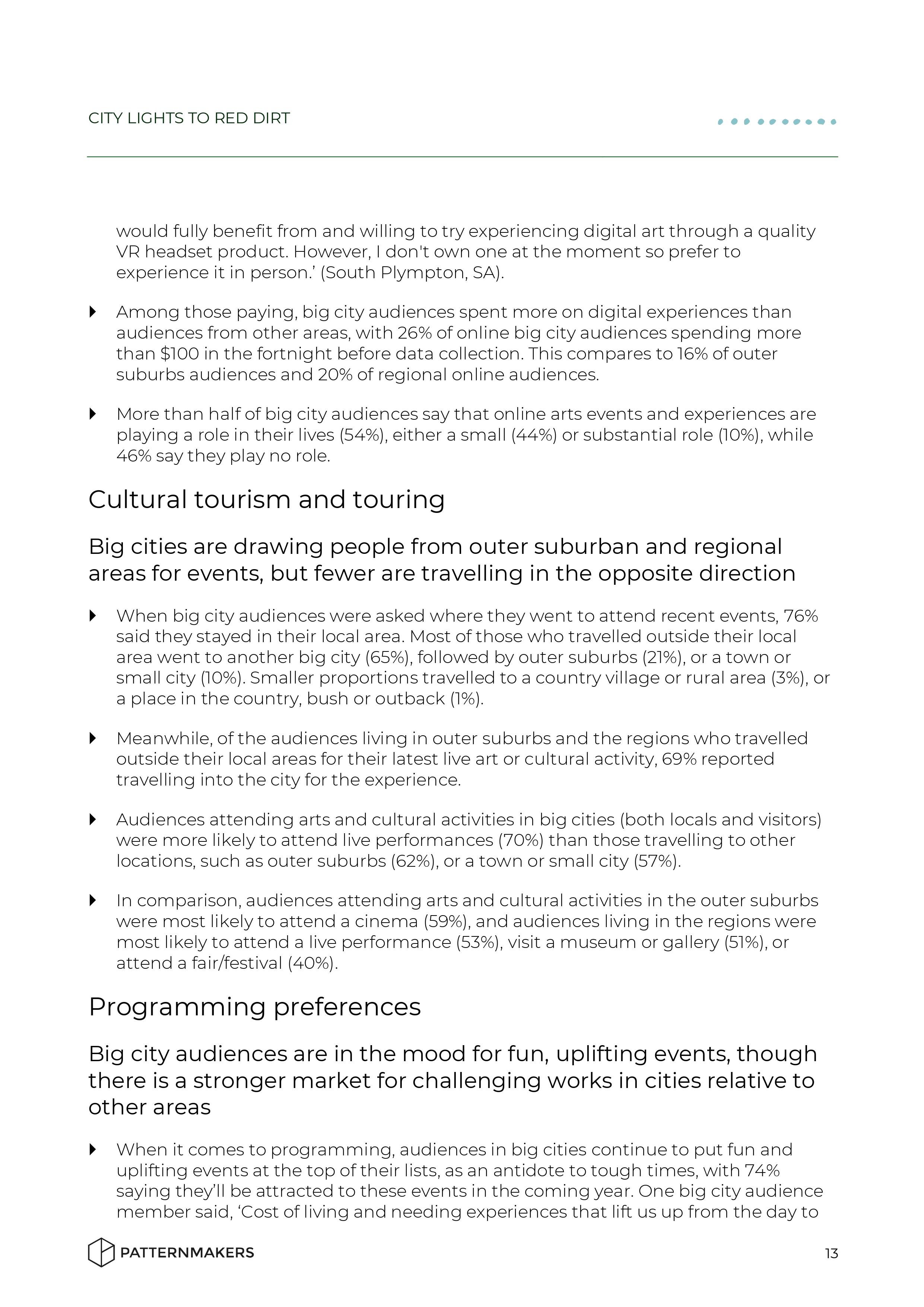

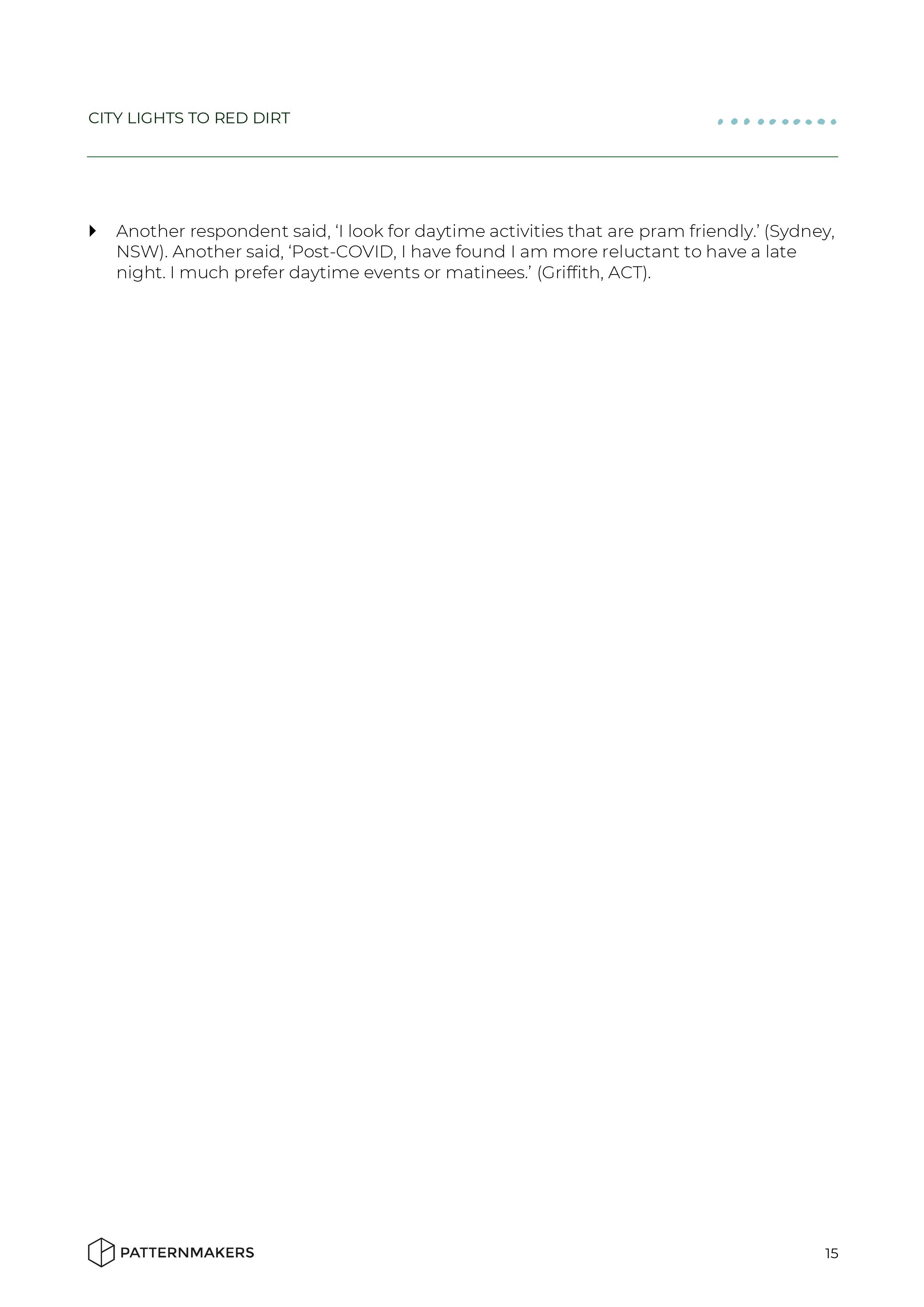
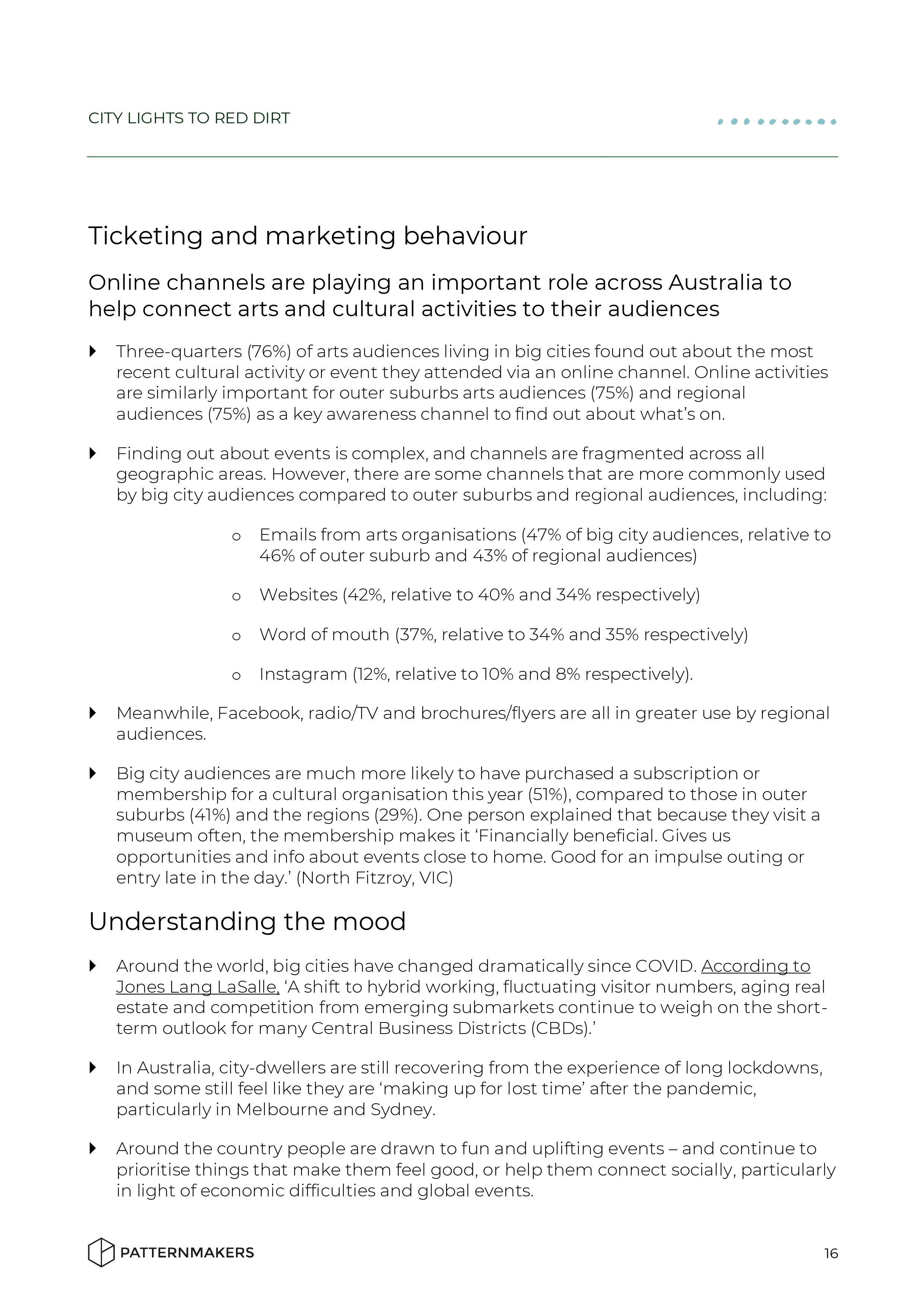


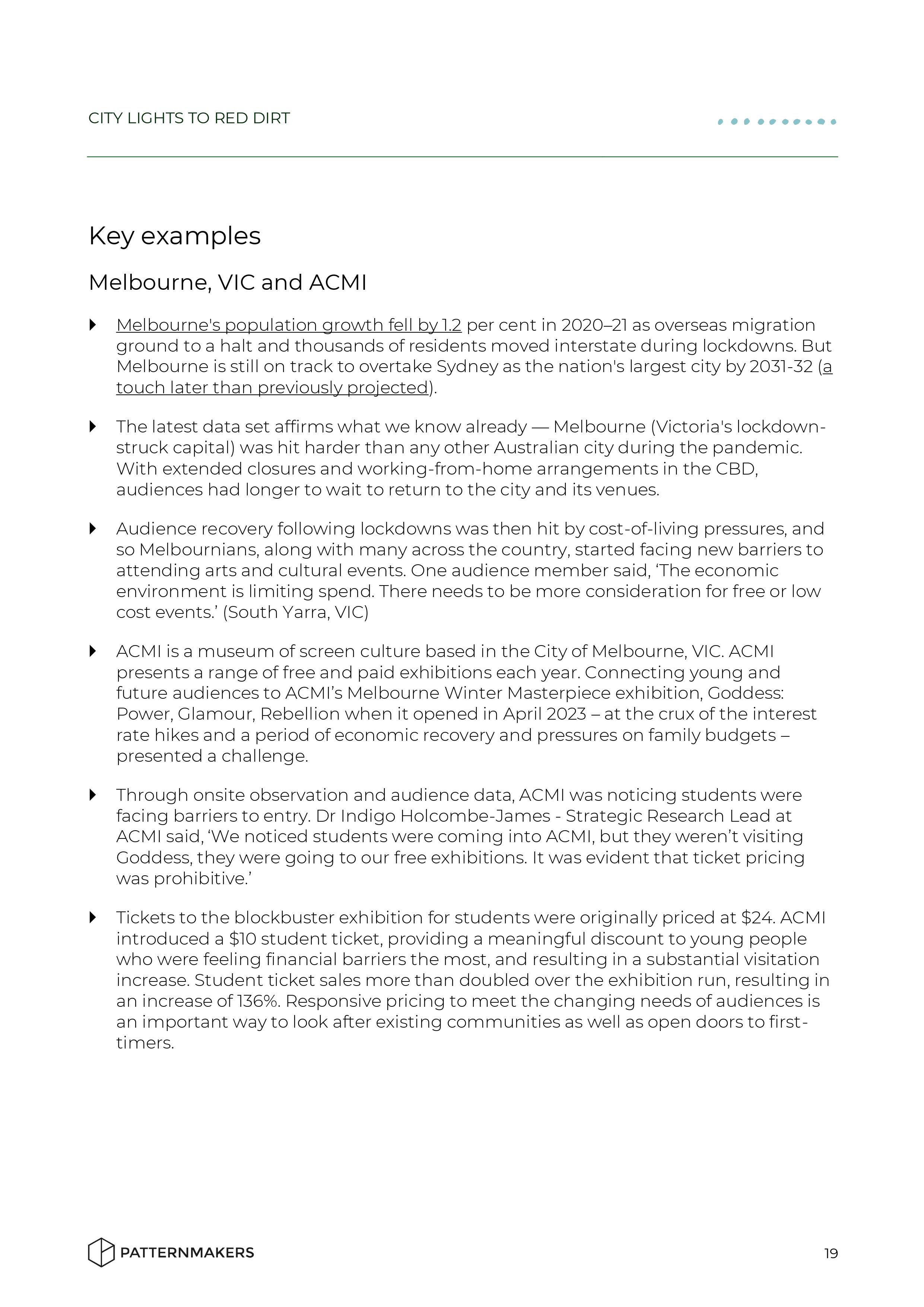
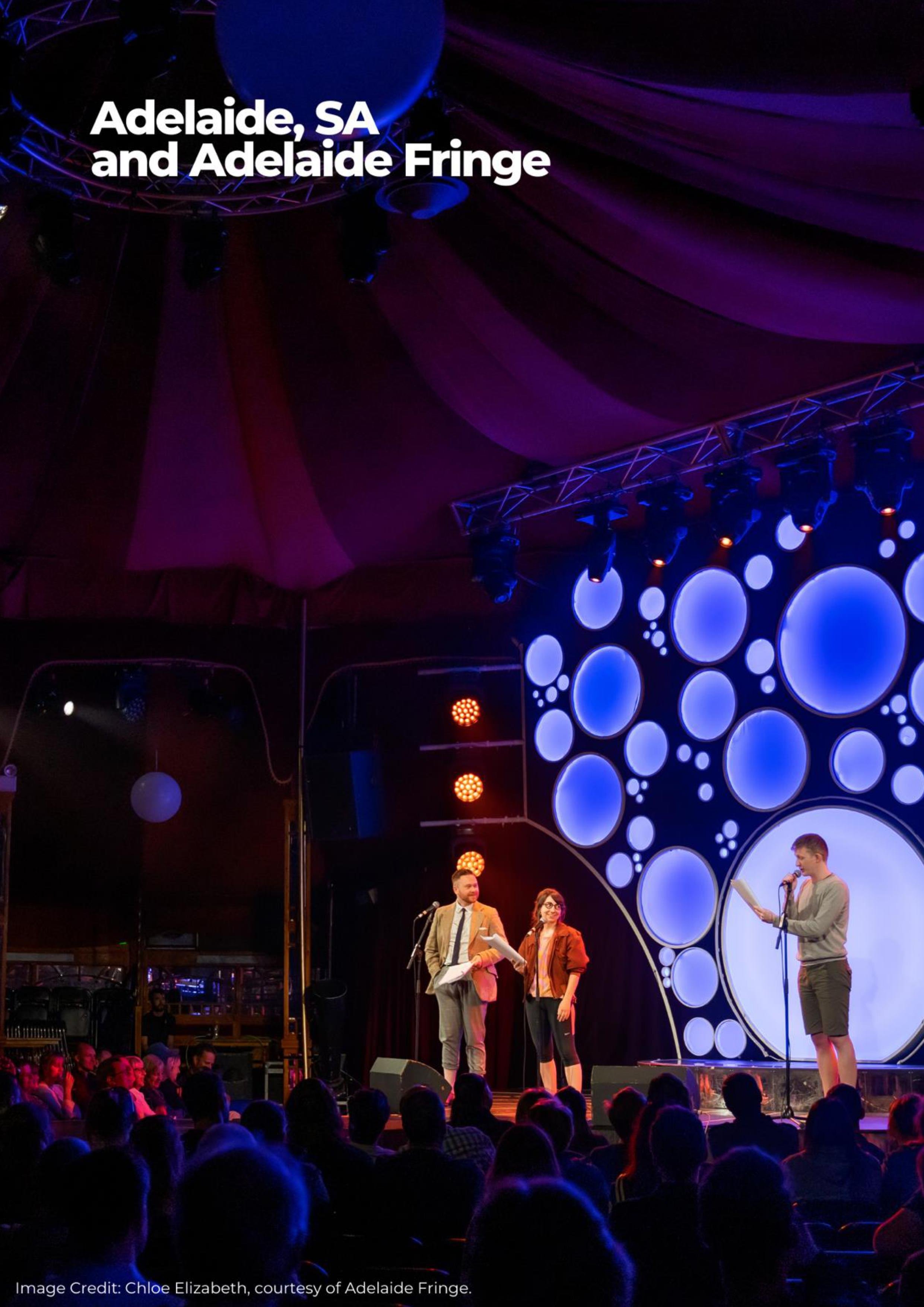


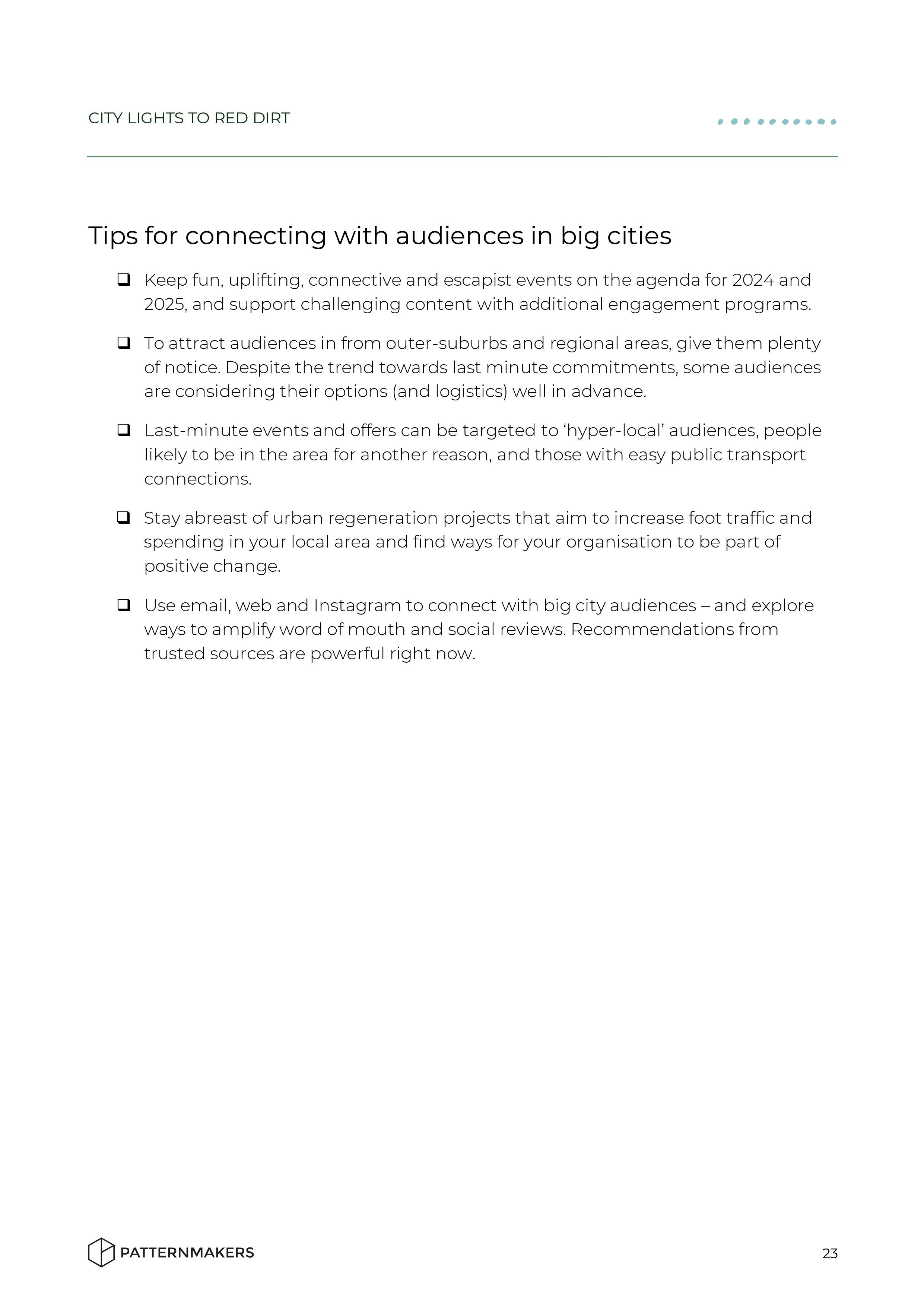

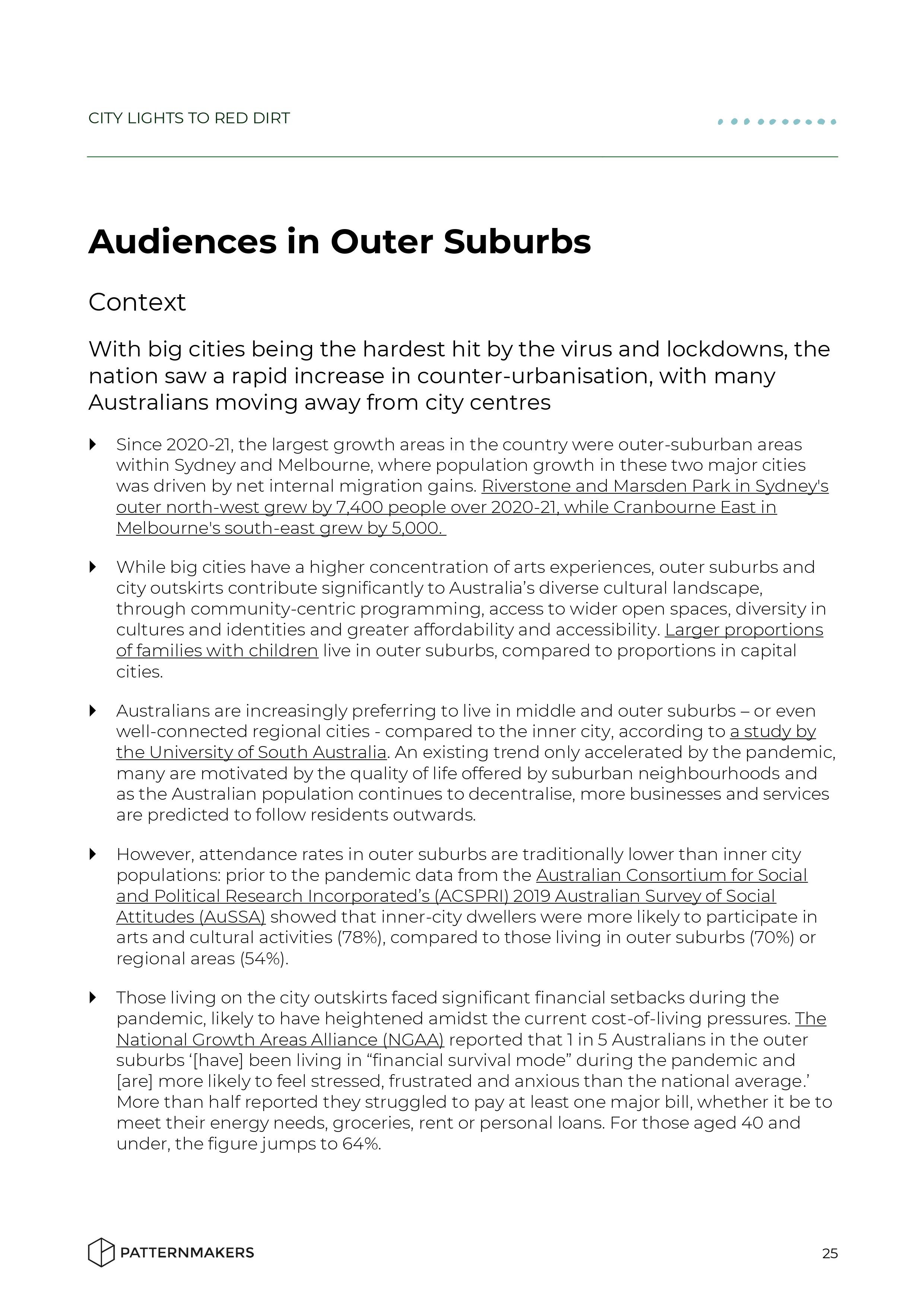
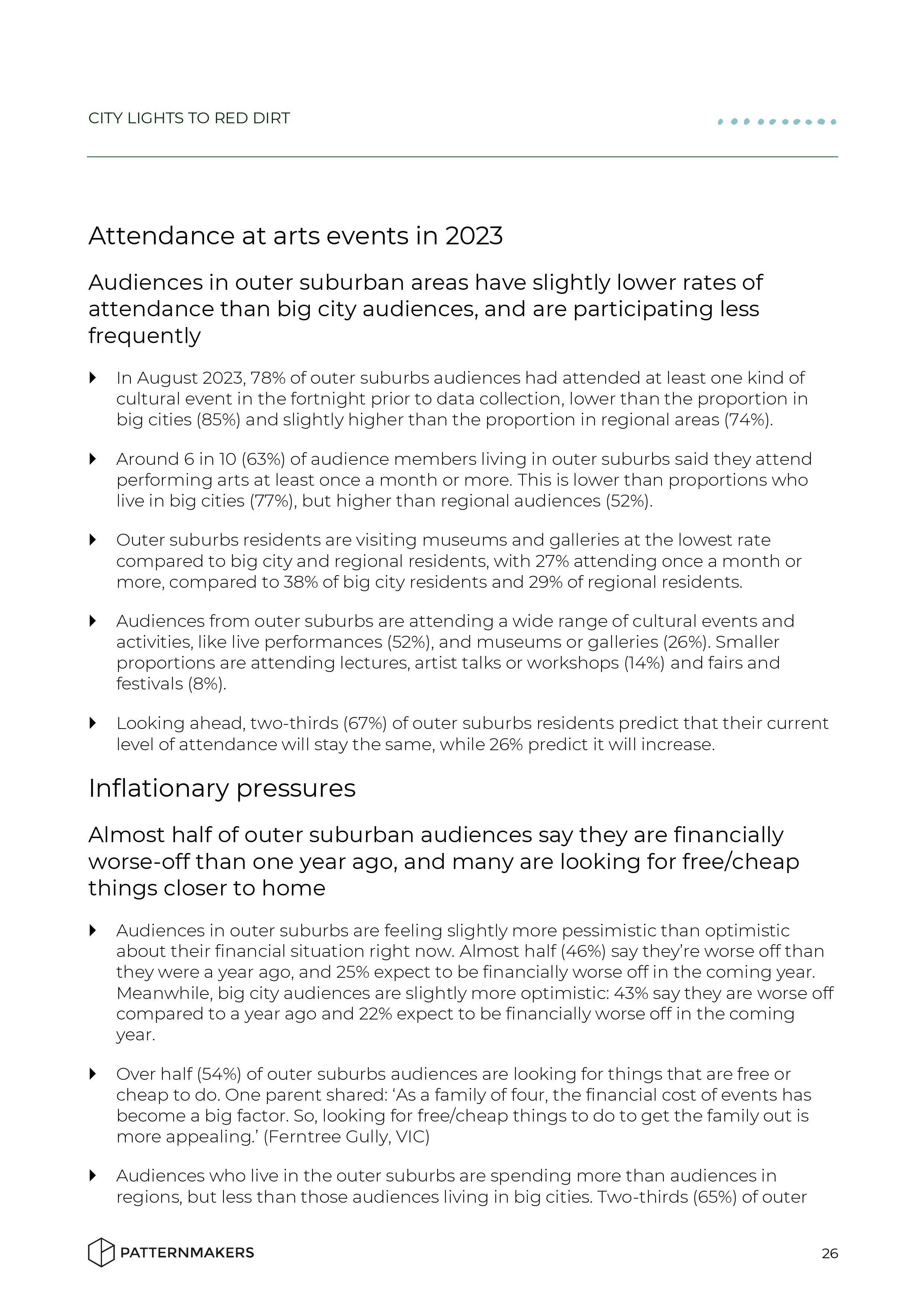
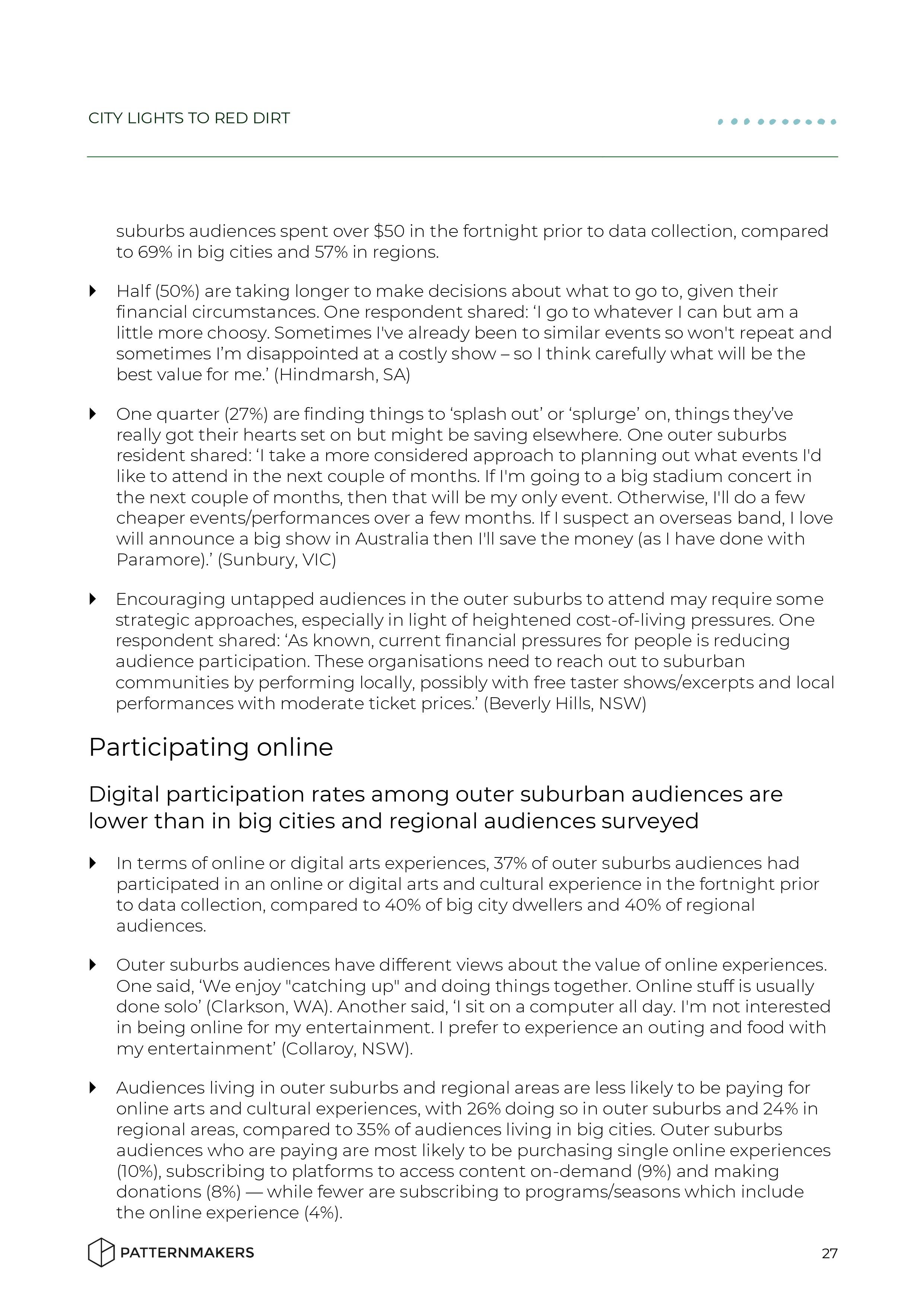
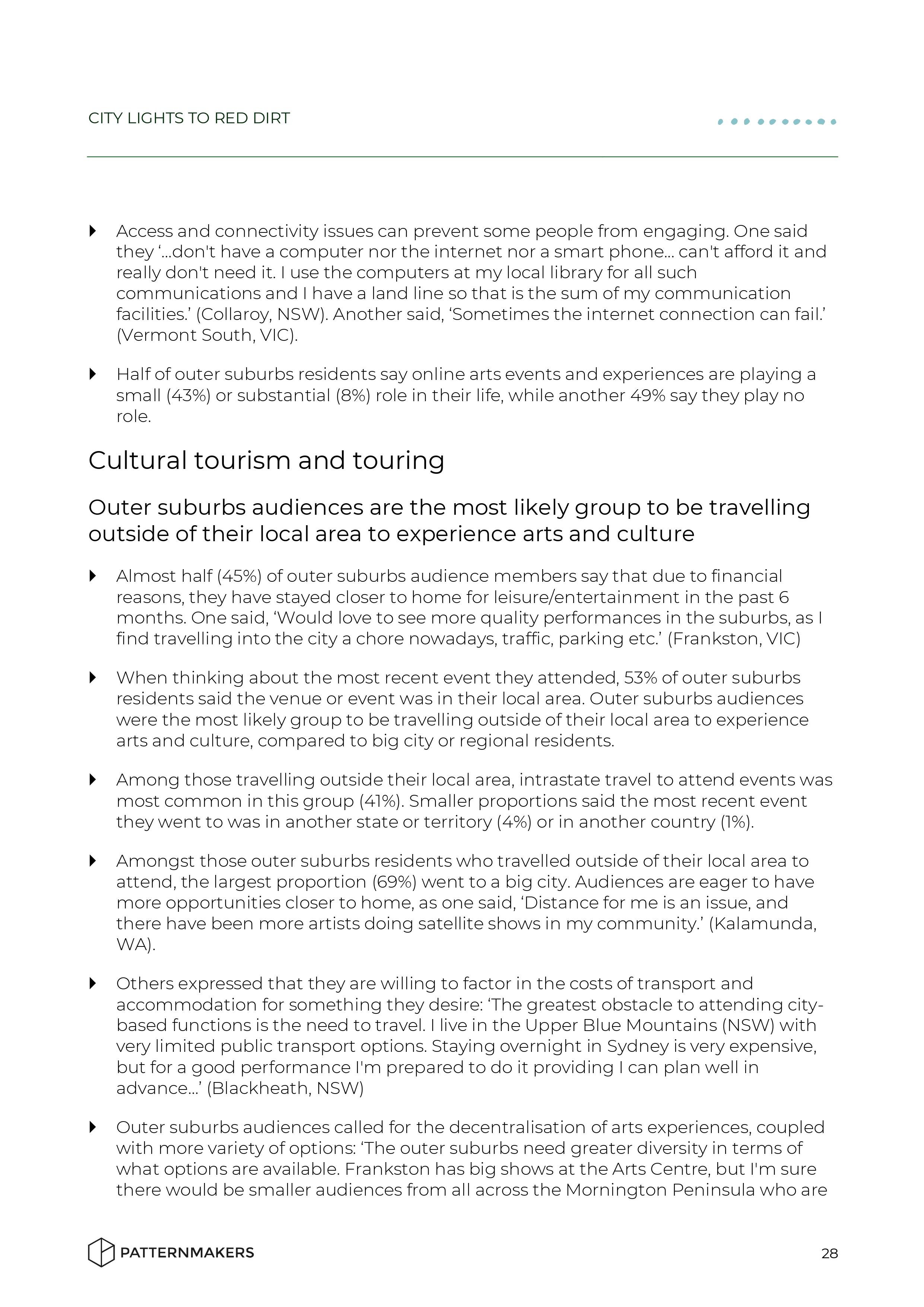


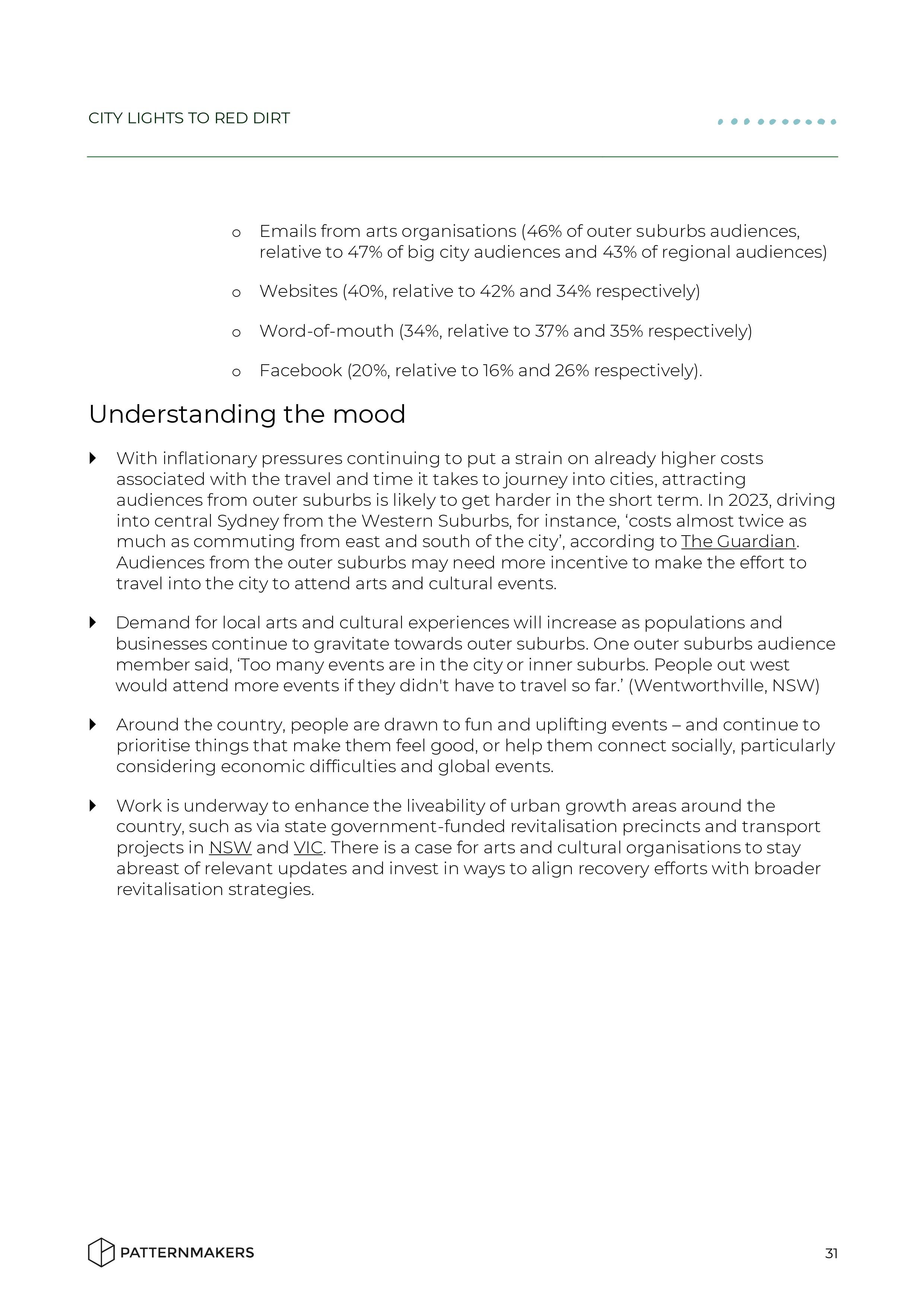
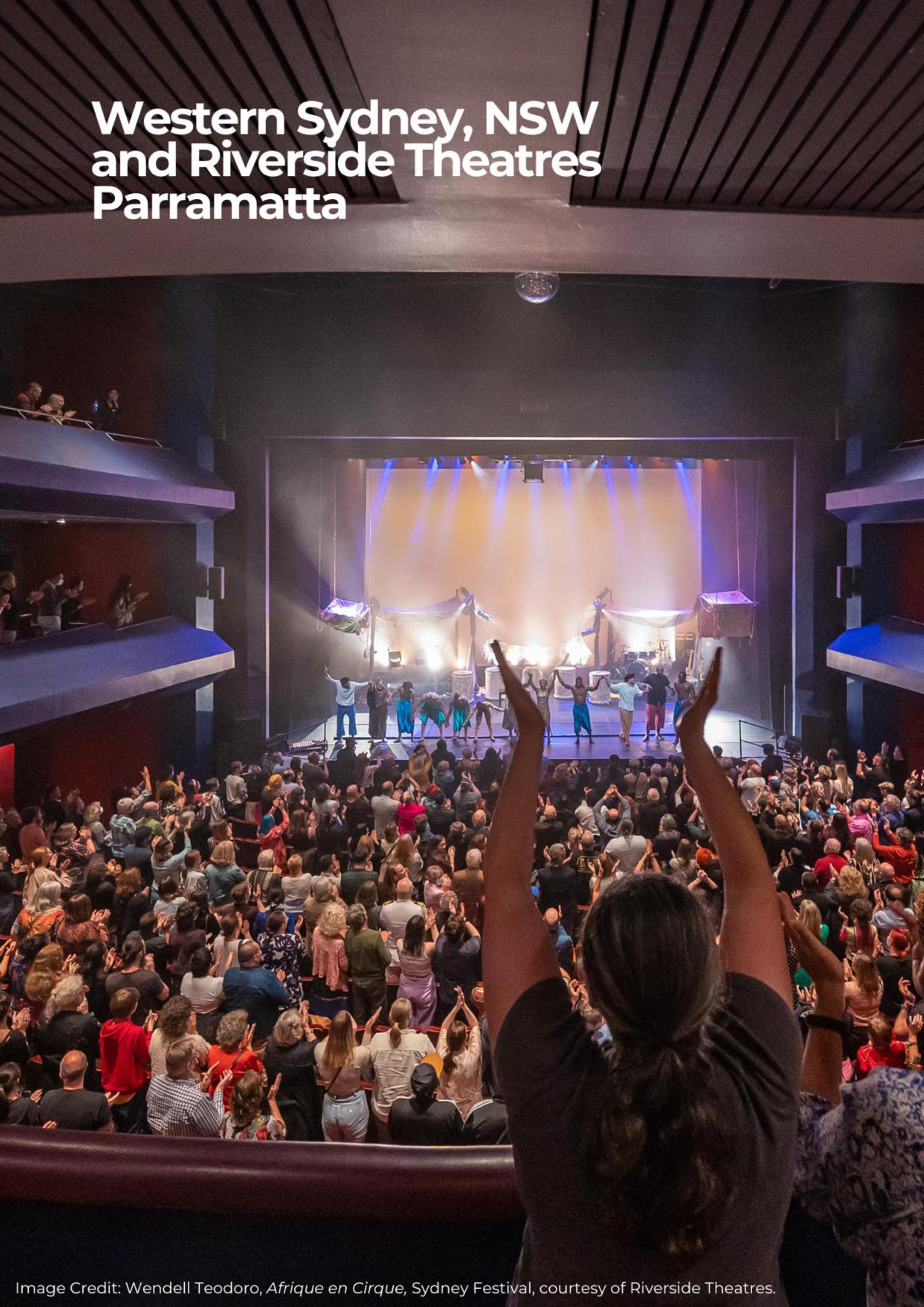
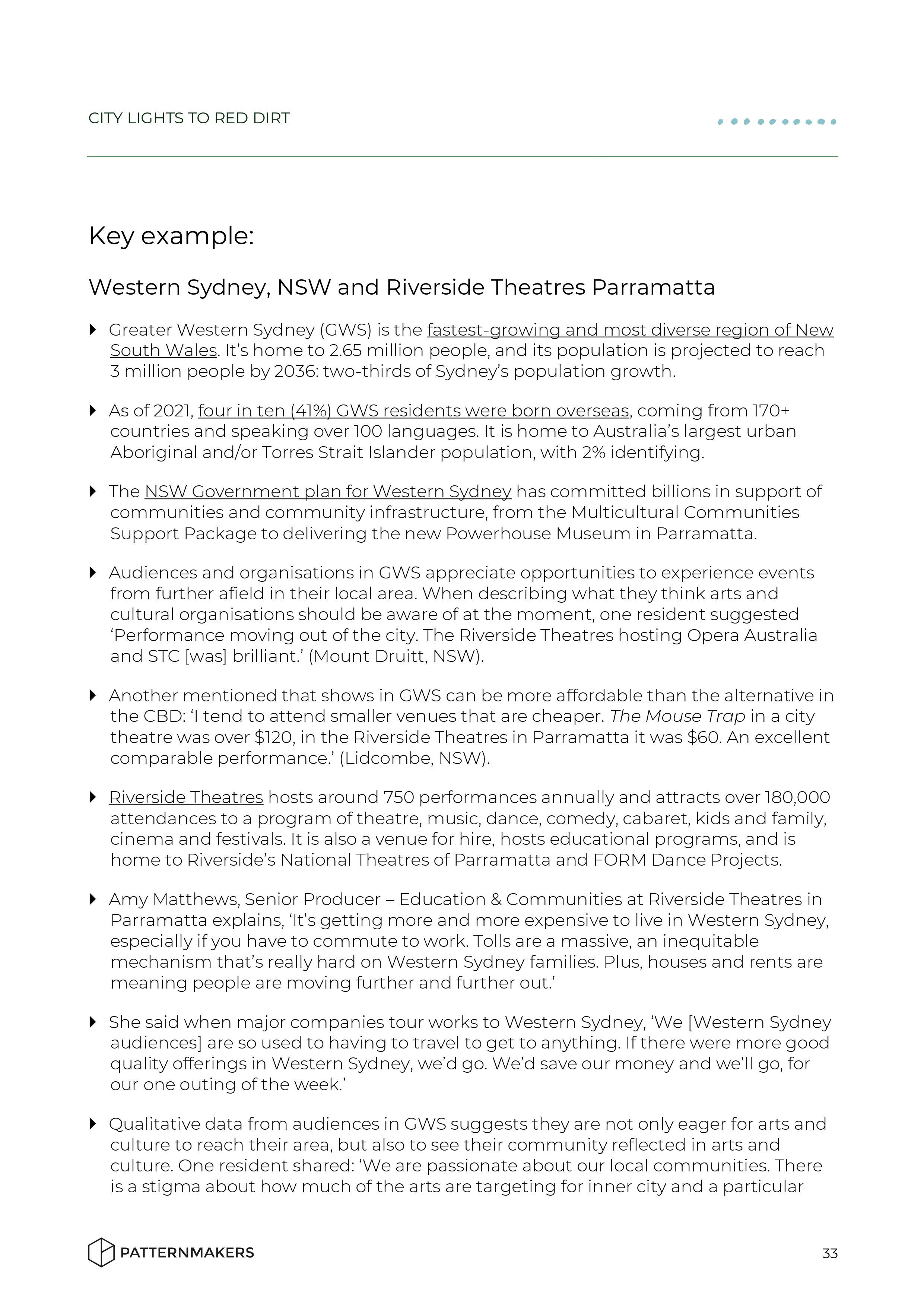



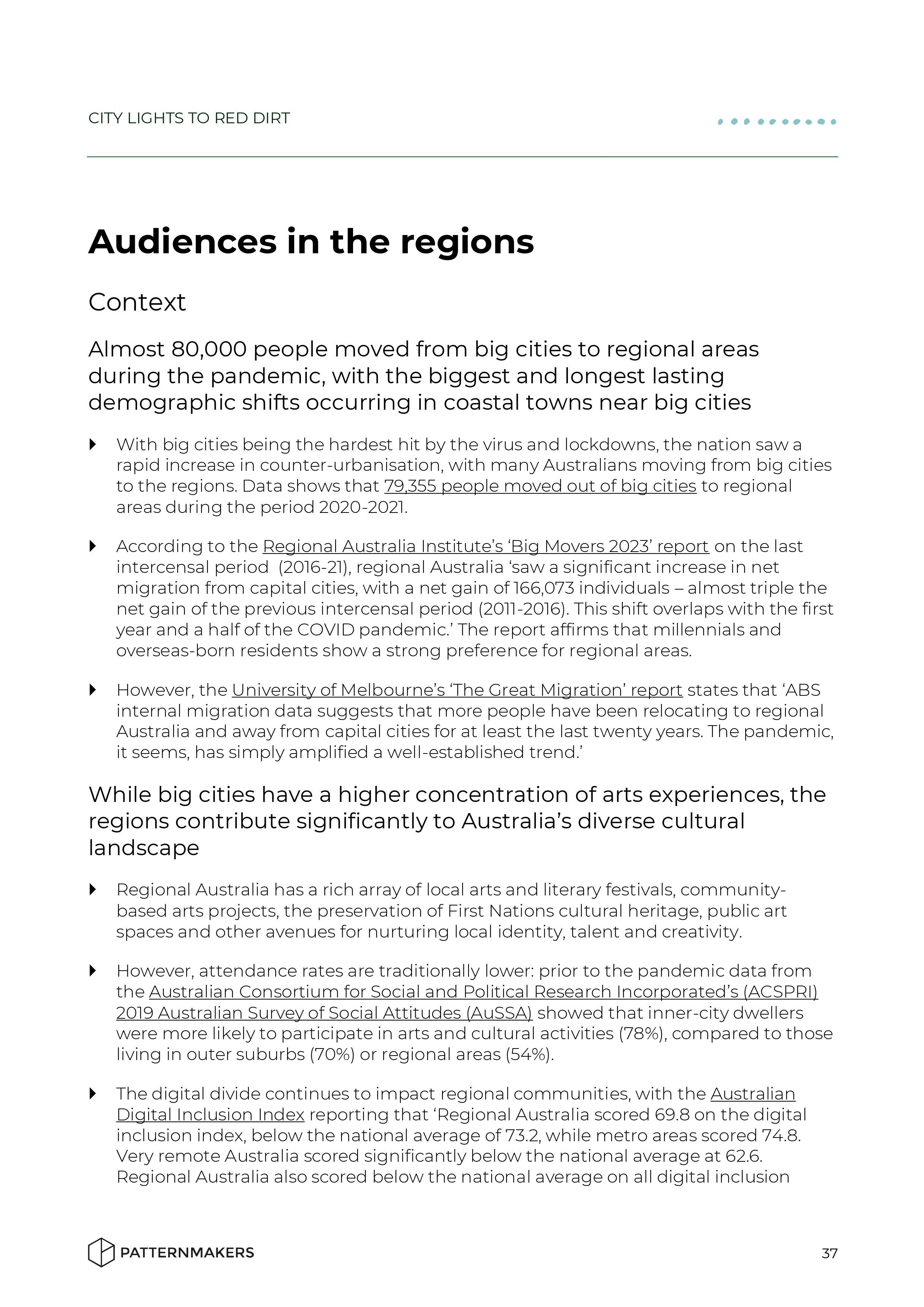
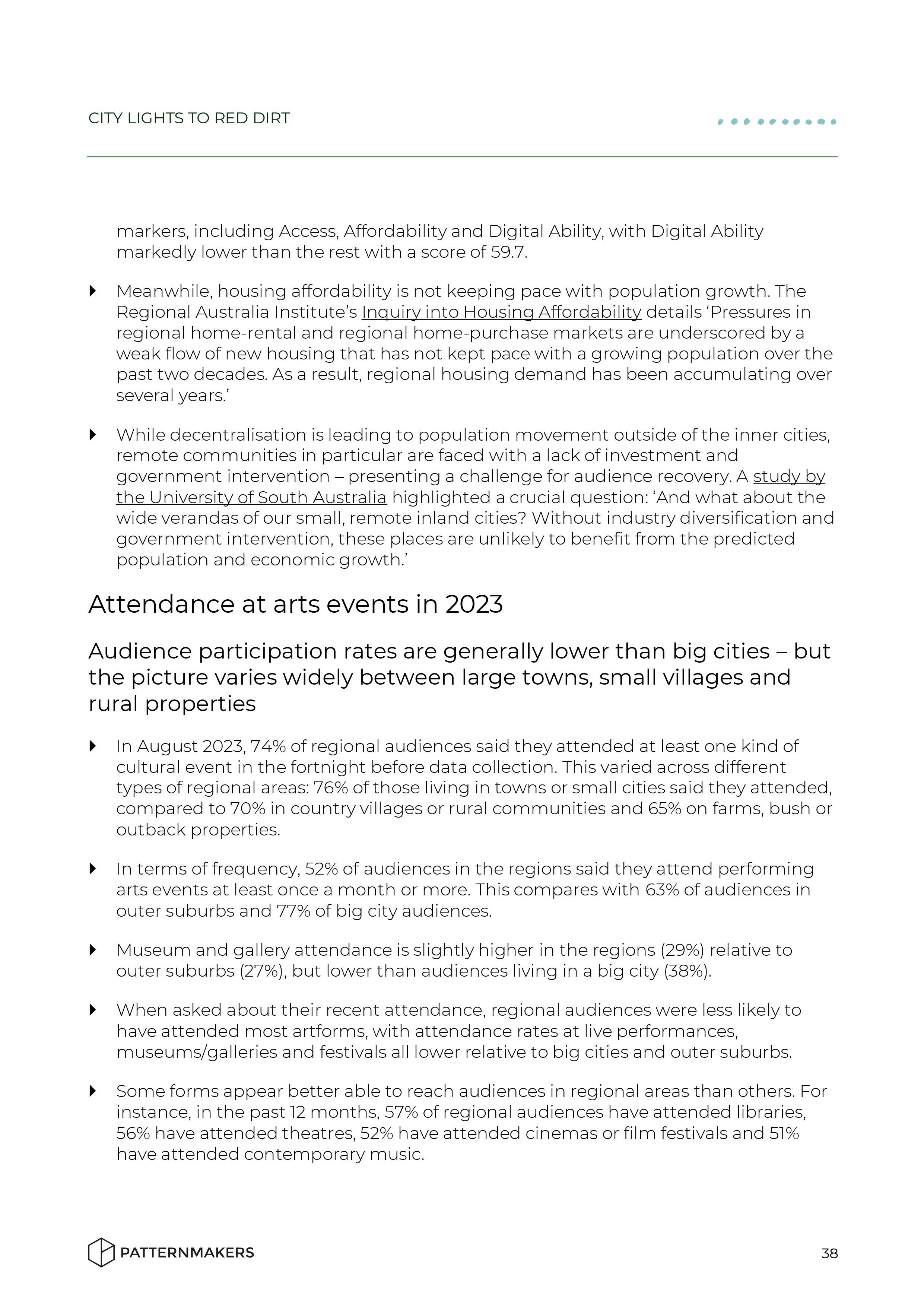
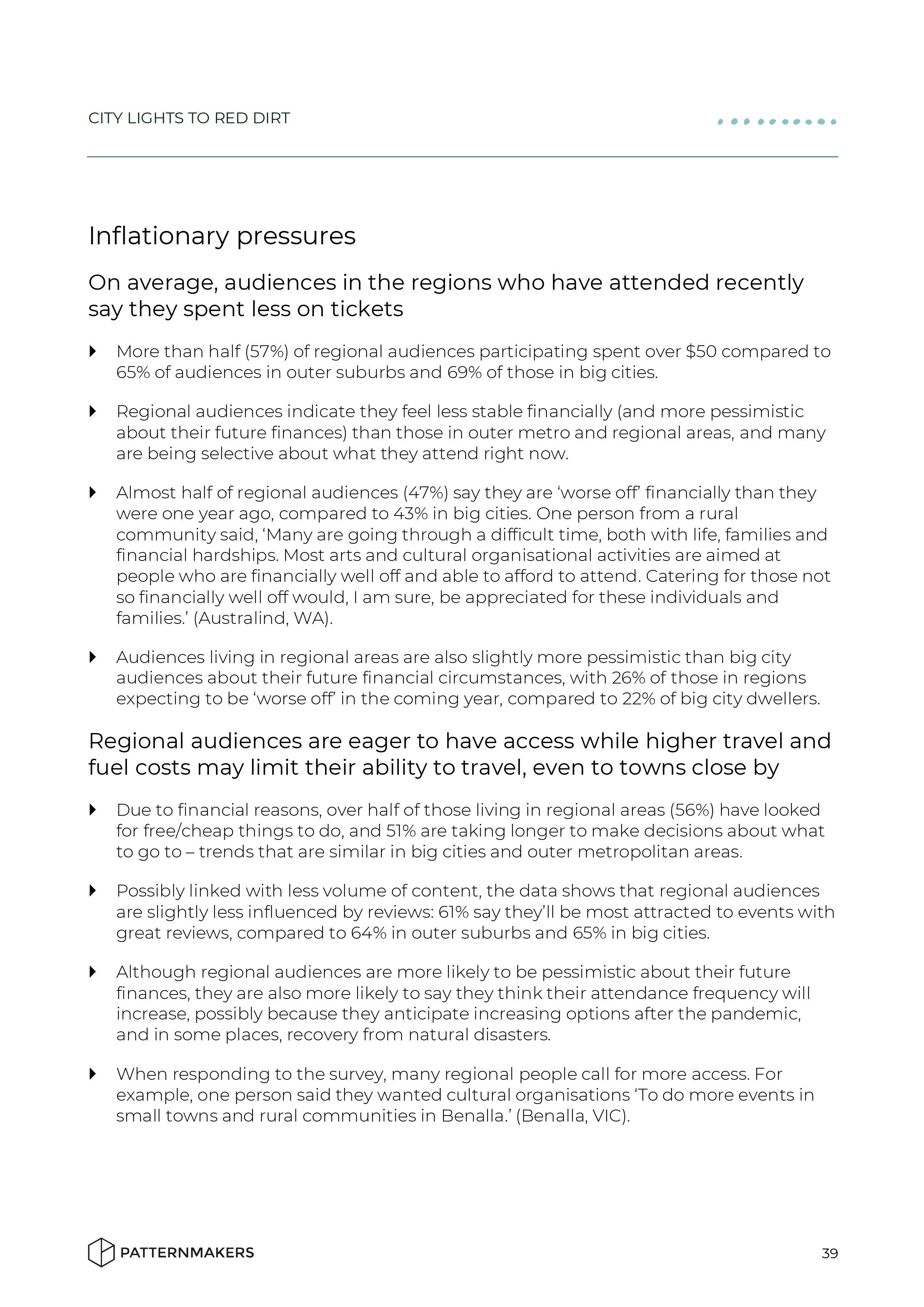
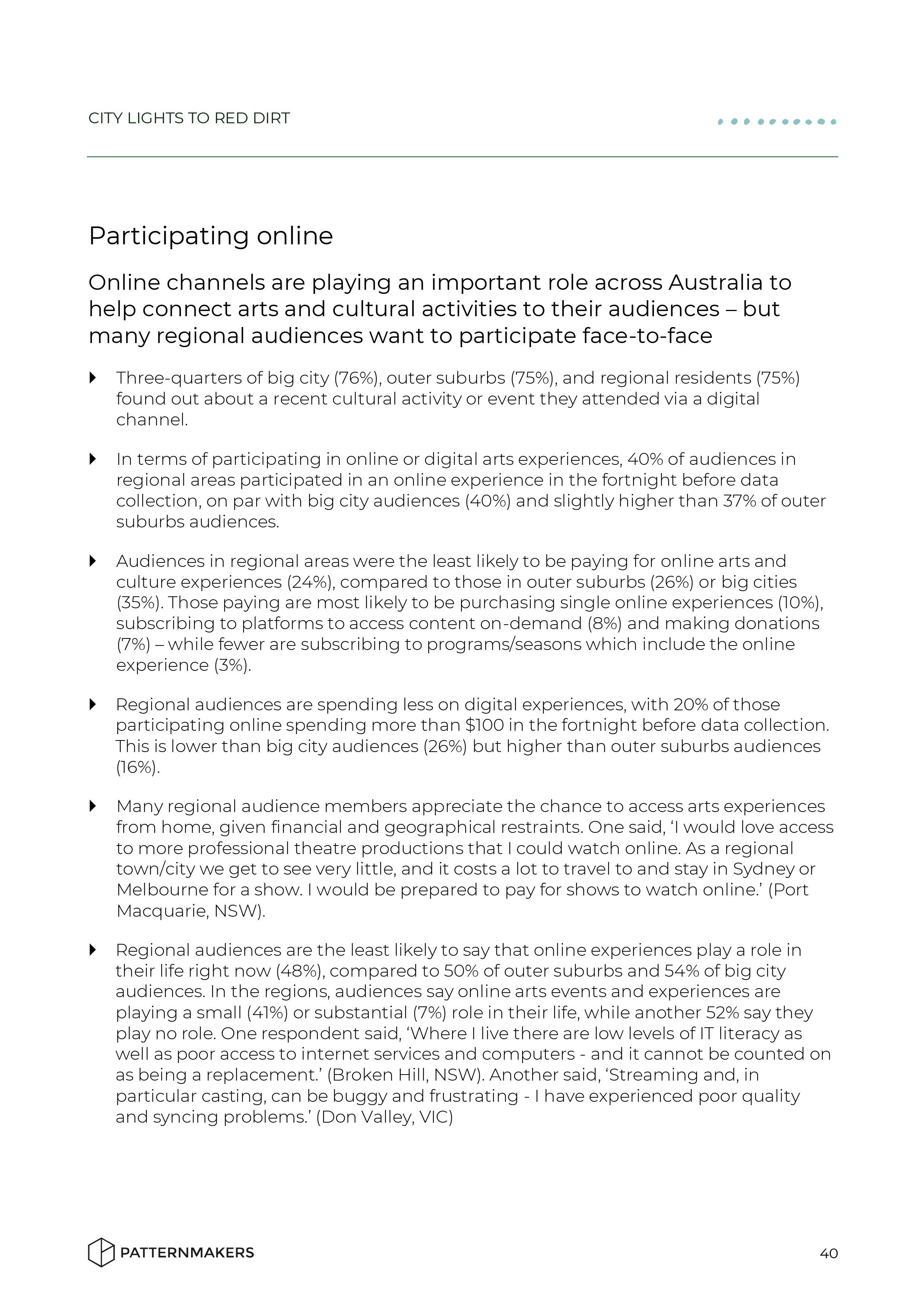
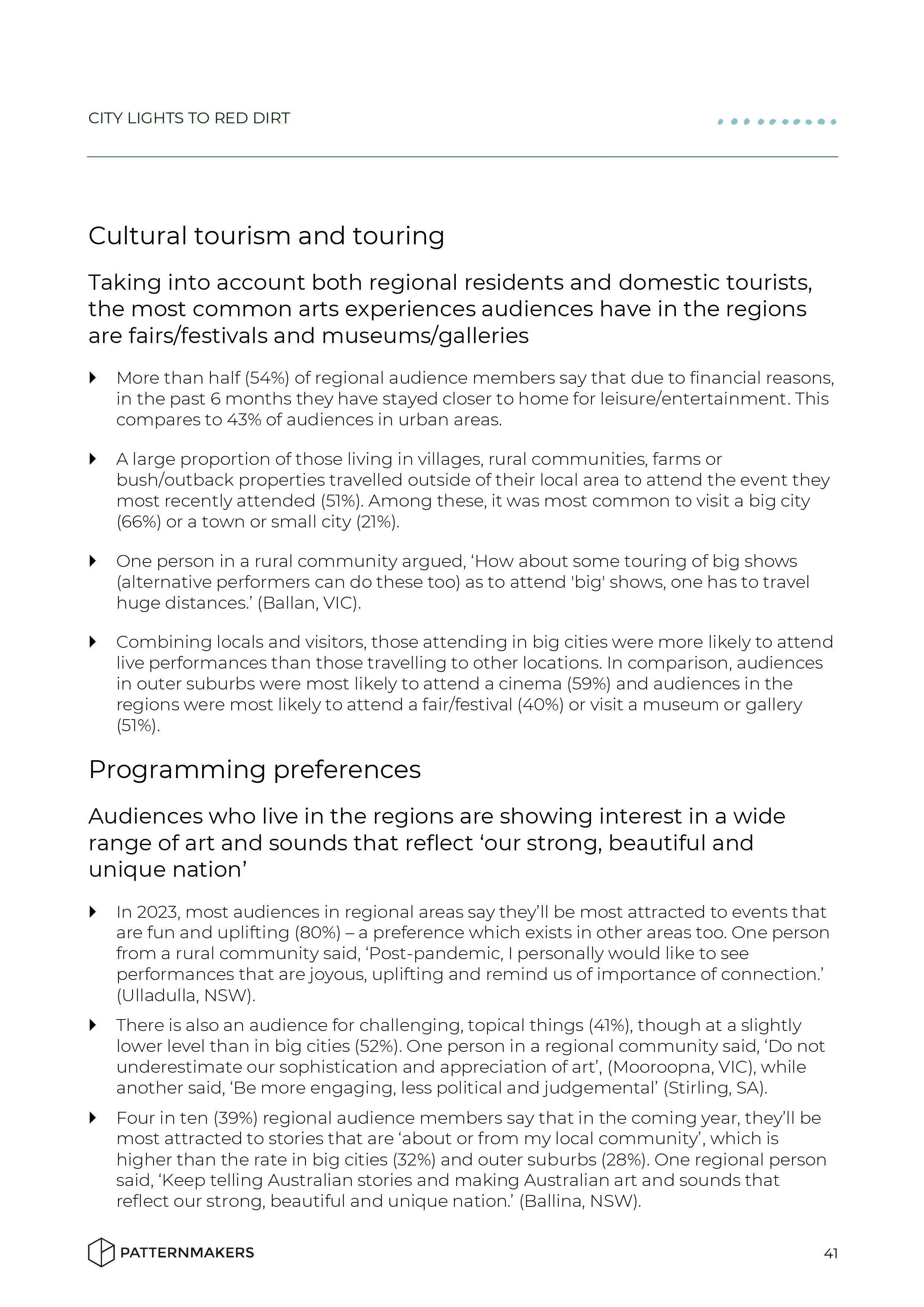
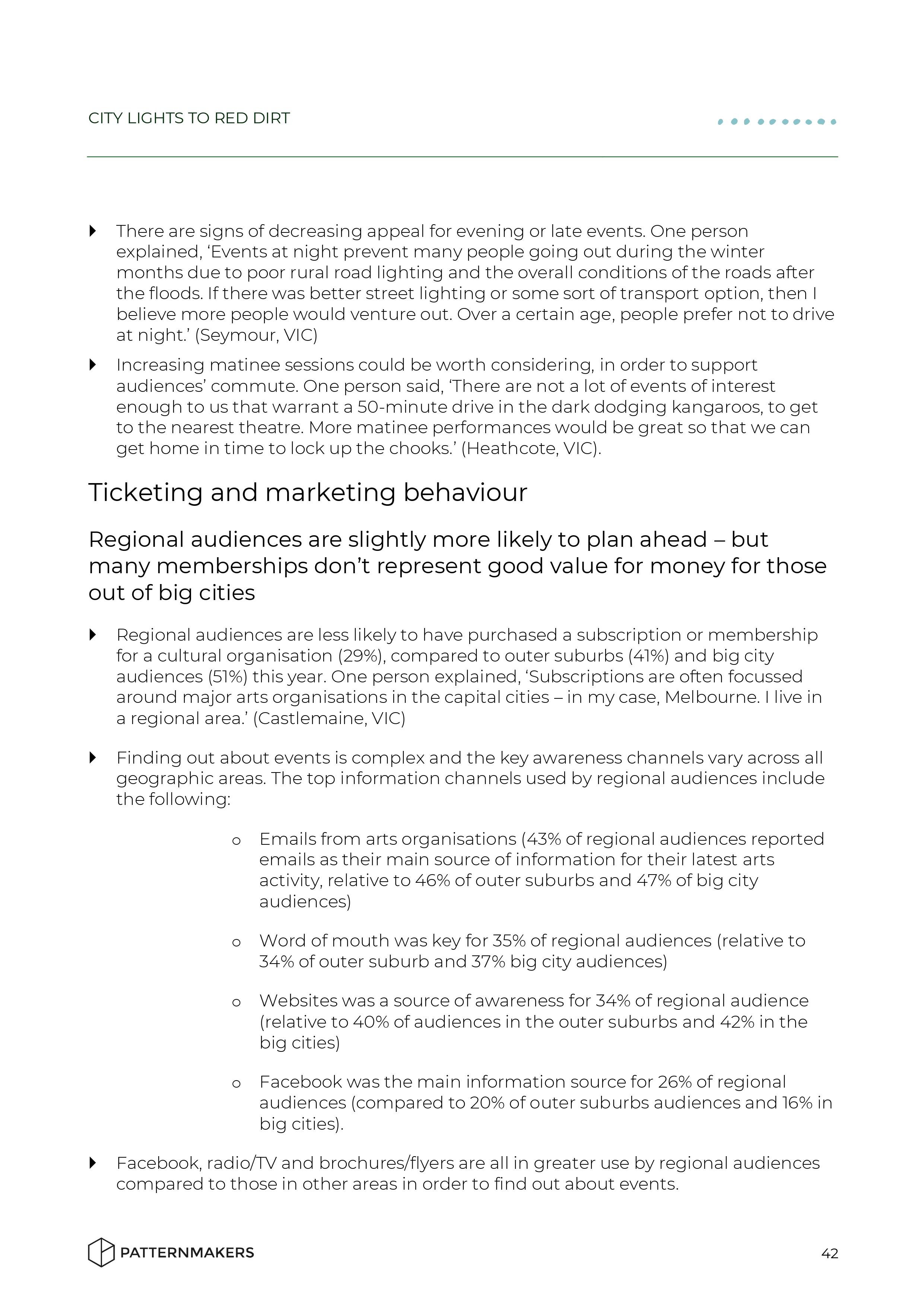
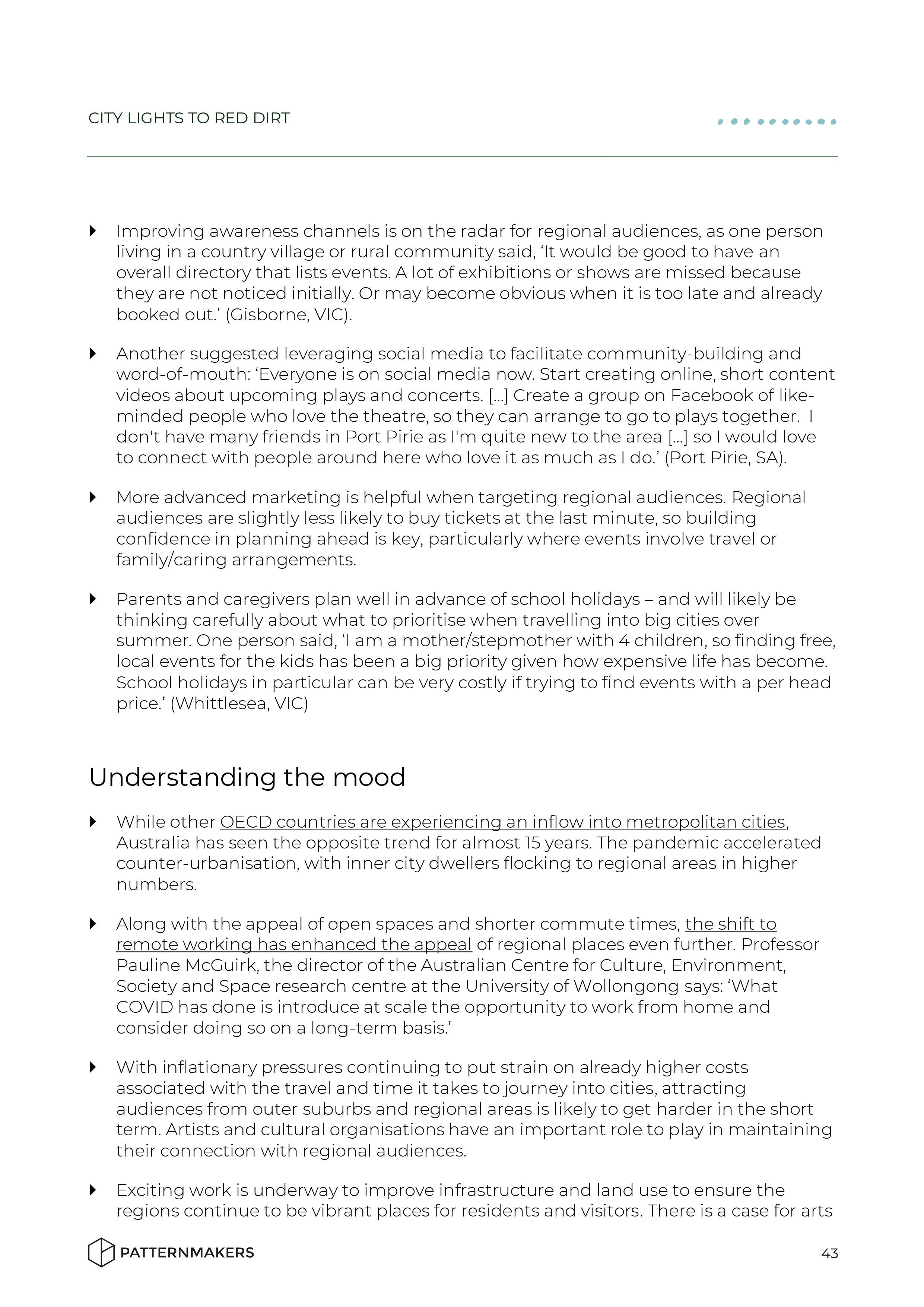


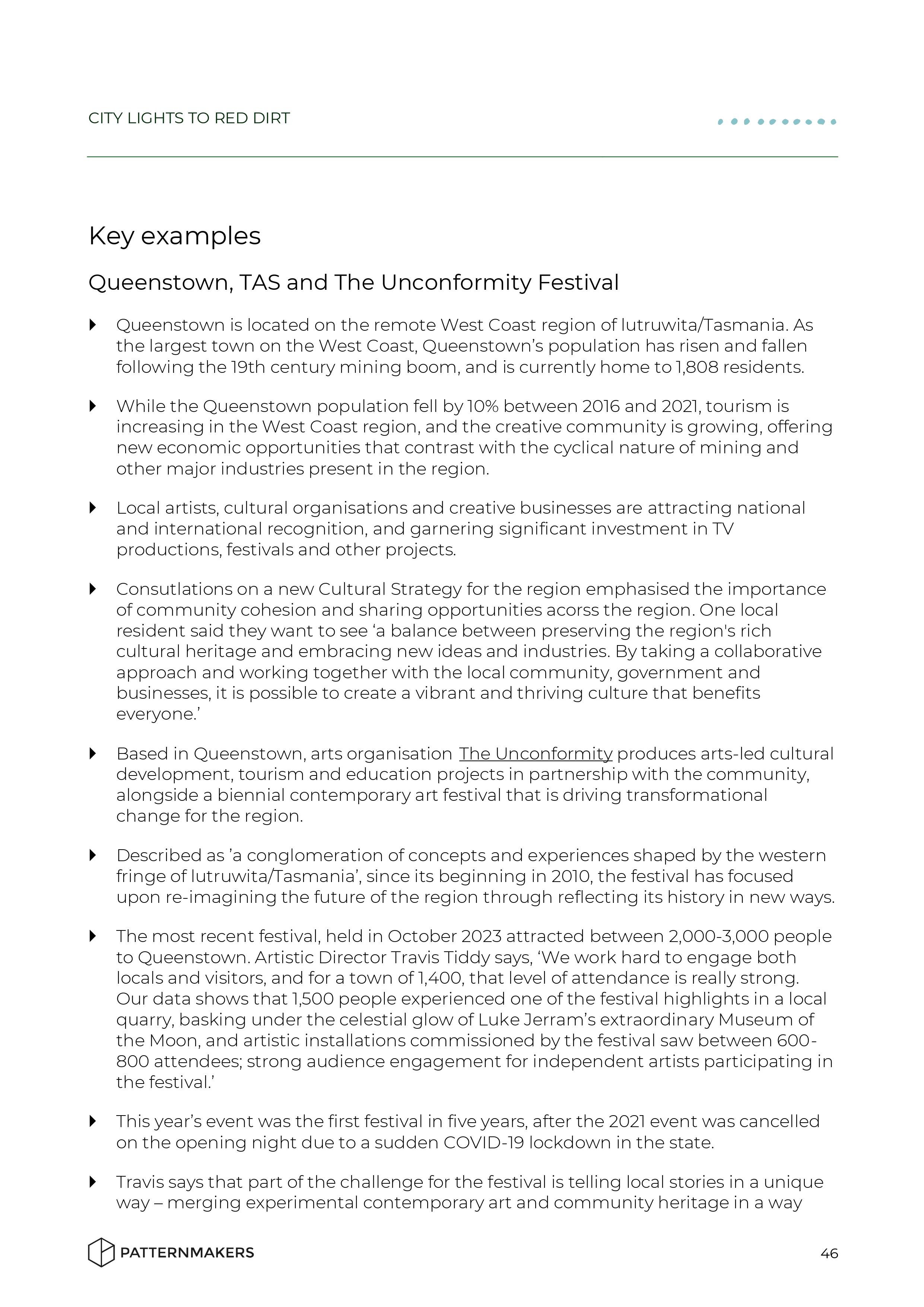
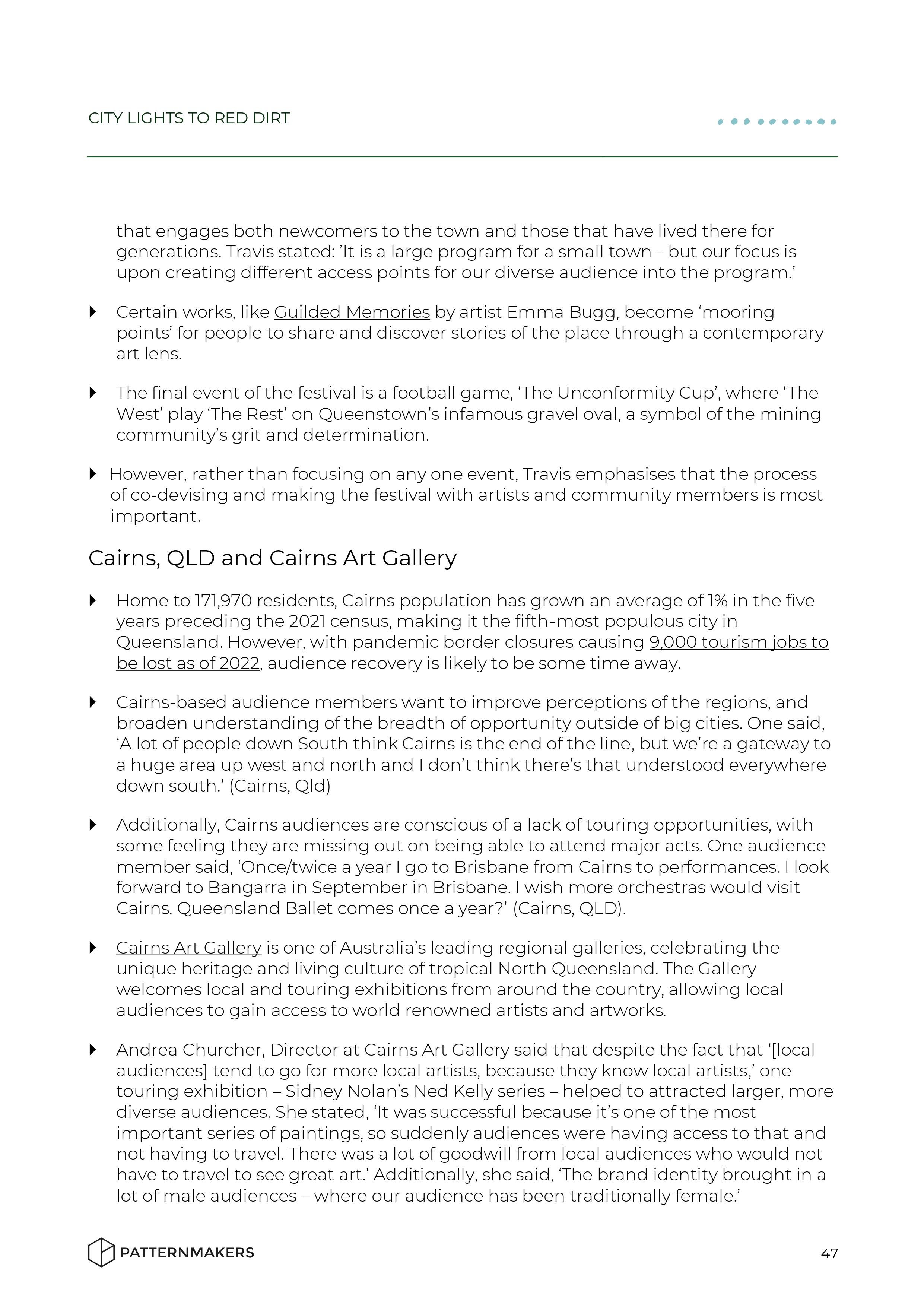
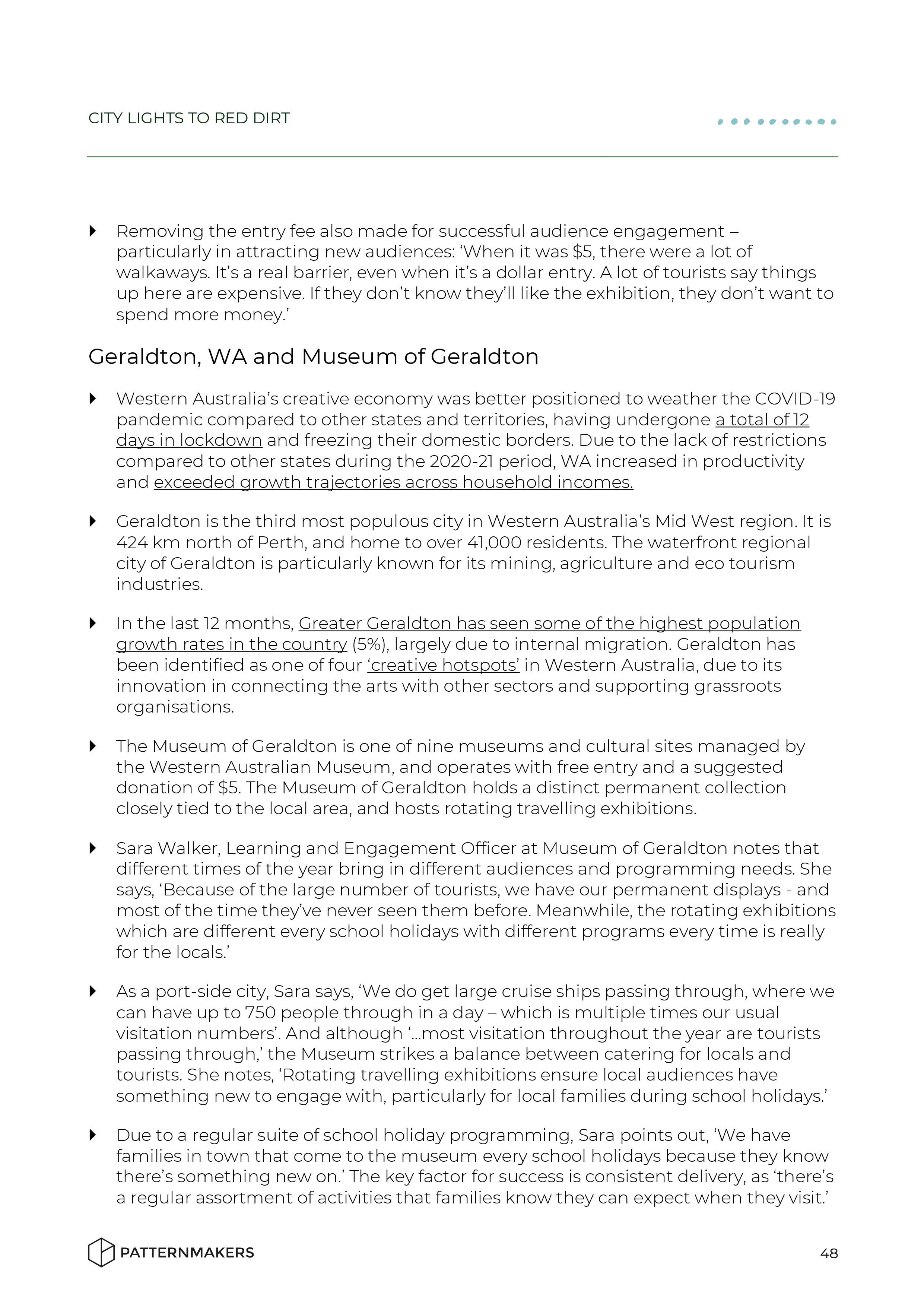
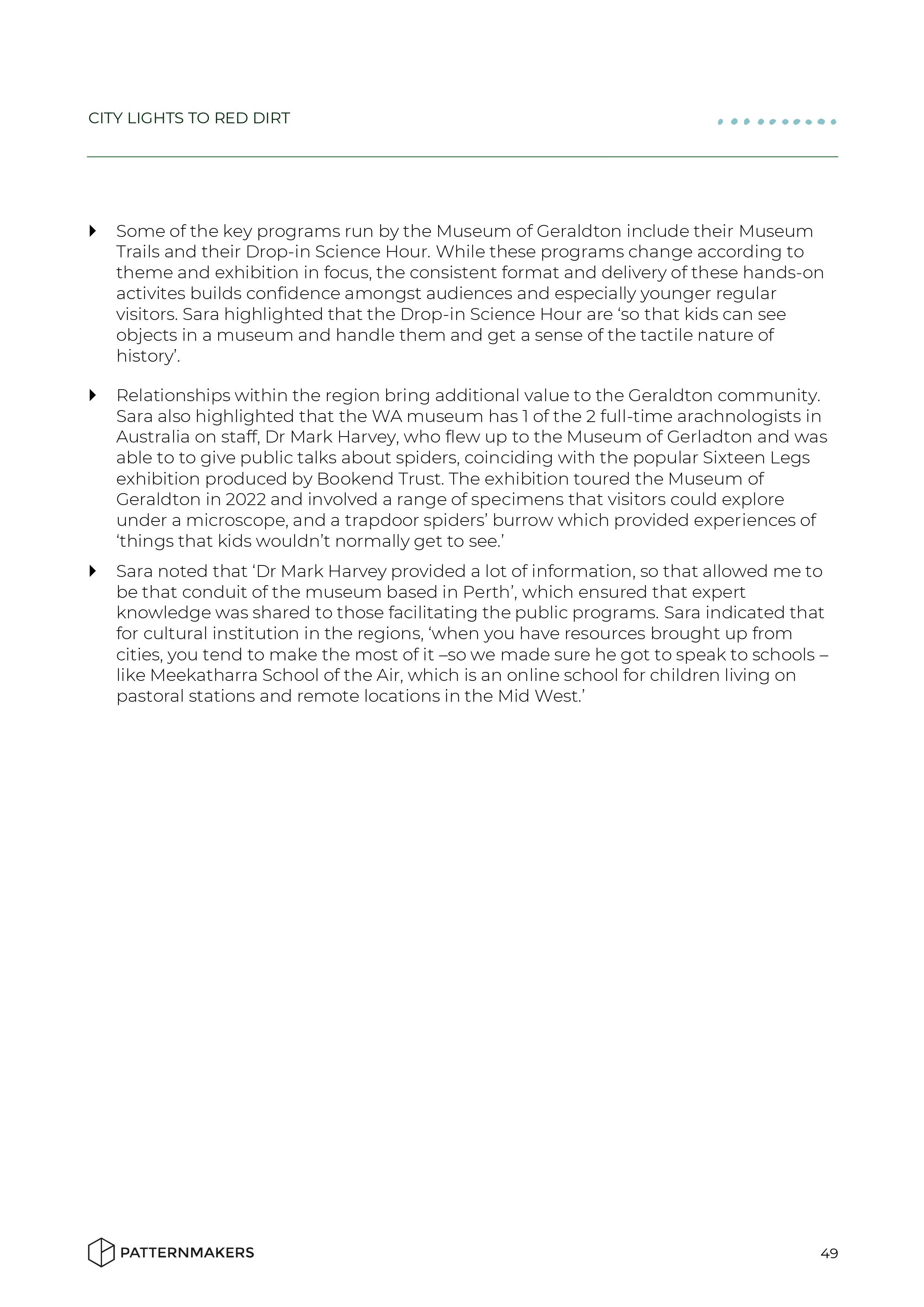
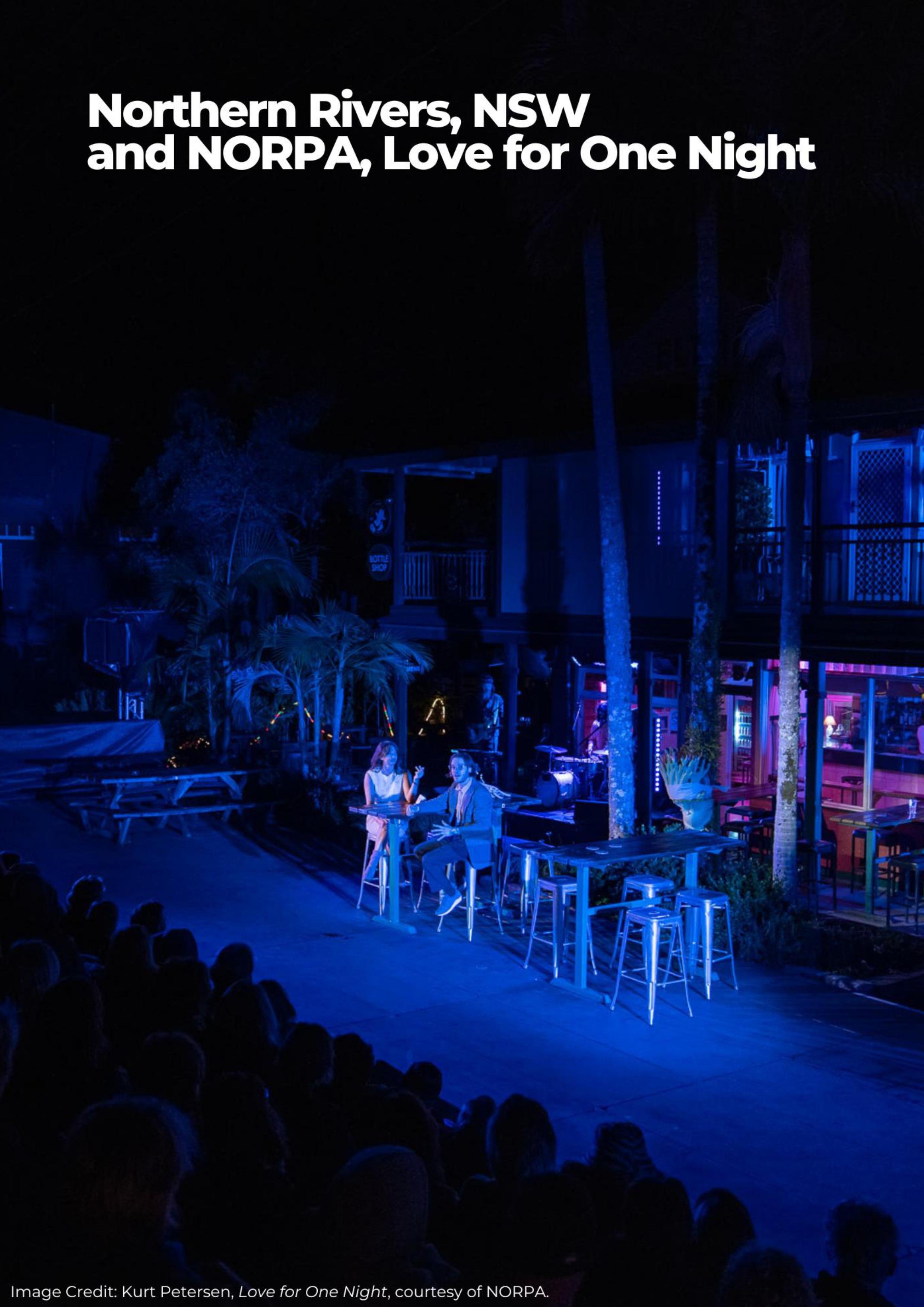
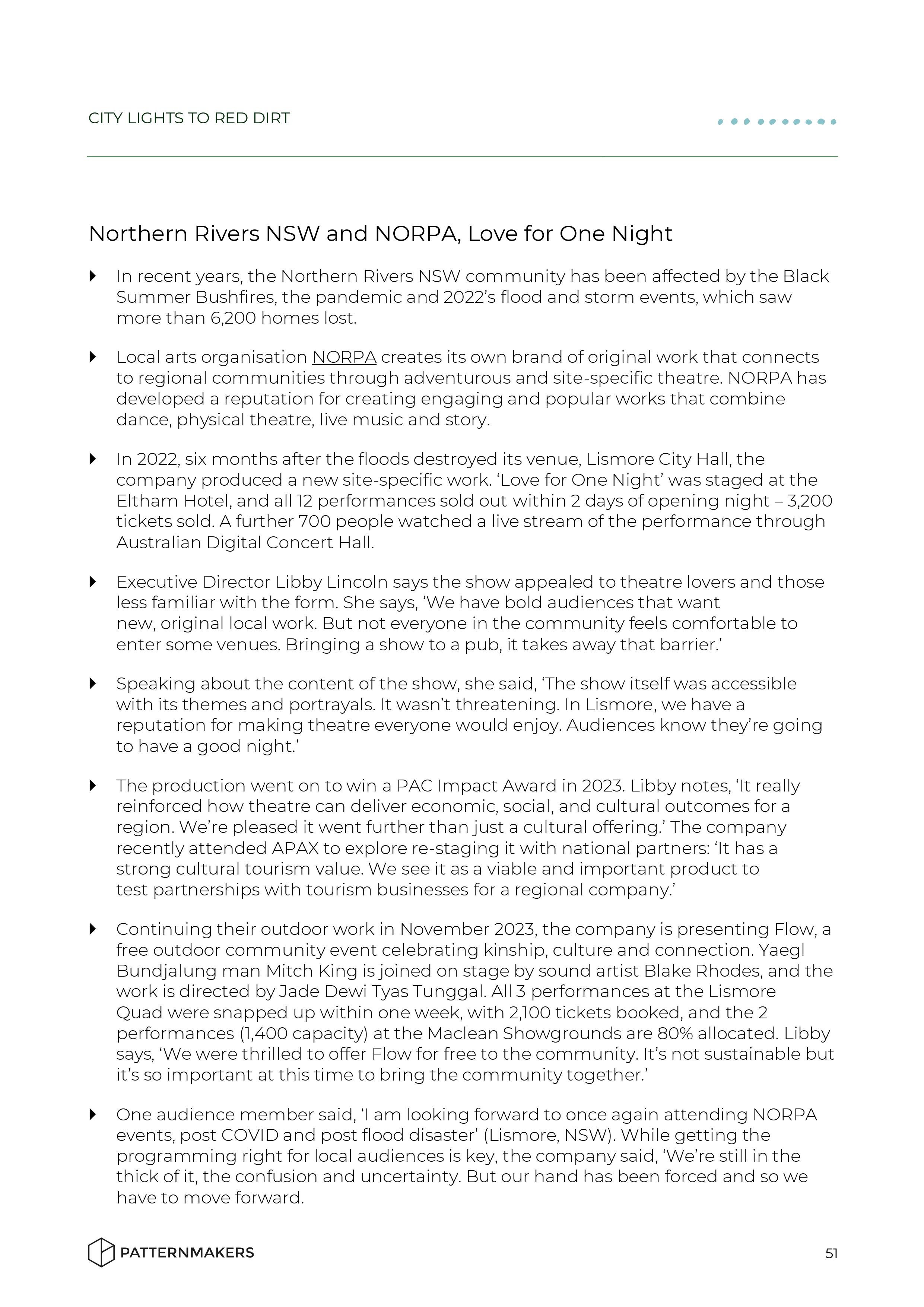

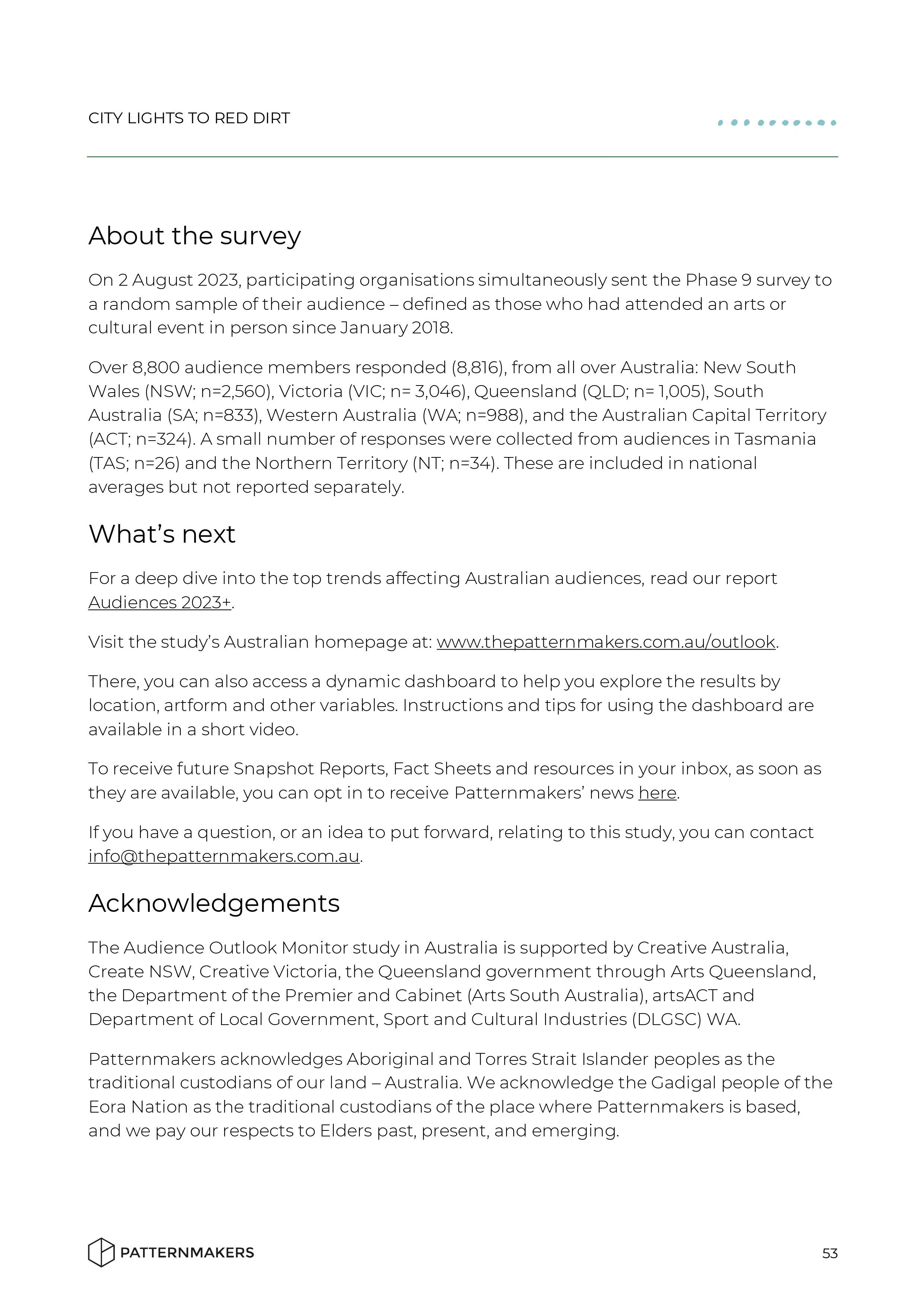

Click the buttons below to download the report, as a PDF or accessible Word version, or read on for more of the findings.
Three chapters, three geographic audience segments
The report compares audiences in three main geographic areas, providing insights for connecting people with culture where they live and the places they visit.
Download the chapters as separate fact sheets below.
Audiences in Big Cities
Arts audiences in big cities are experiencing the arts at high levels, but with market saturation and the shifting dynamics of Australia's CBDs post-pandemic, new challenges have emerged for organisations to cut through.
-
In Australia’s big cities, more people are attending arts events more often, but resident arts organisations are competing in a congested market. The data from past attendees shows that:
85% of big city audiences said they attended at least one kind of cultural event in the fortnight before data collection. Attendance is also more frequent amongst big city arts audiences: 38% attend a gallery or museum at least once a month, compared to outer suburbs (27%) and regional audiences (29%).
Arts audiences living in big cities are spending more on tickets to in-person live events and cultural activities: 7 in 10 spent more than $50 the fortnight before data collection (69%), compared to 65% of outer suburb audiences and 57% of regional audiences.
While most audiences are drawn to fun, uplifting and even escapist content right now, big city audiences are showing a greater appetite for challenging, topical content in the next 12 months (52%), compared to audiences living in outer suburbs and regional areas (both 41%). With more options on offer, they are also more likely to tune into reviews when considering what to attend.
Audiences in Outer Suburbs
Outer suburbs are the biggest growth areas in Australia right now, and have an expanding arts audience looking for more cultural experiences closer to home — but don't yet have enough venues nearby to accommodate.
-
In the outskirts and outer suburbs of big cities, the rate and frequency of attendance are slightly lower than big cities, but the market is growing, as more people move to more affordable areas where families can enjoy different lifestyles. The data from past attendees of events shows:
Audiences in outer suburbs are feeling slightly more pessimistic than optimistic about their financial situation, with almost half (46%) say they’re worse off than they were a year ago, and 25% expect to be financially worse off in the coming year.
Audiences in outer suburbs (combining both residents and visitors) were most likely to attend a cinema locally (59%), whereas big city audiences were comparatively more likely to attend a local live performance. Audiences in the regions were most likely to attend a fair/festival locally (40%) or visit a museum or gallery (51%).
Audiences in outer suburban areas are the least likely to be participating in online events right now. Half of outer suburbs residents say online arts events and experiences are playing a small (43%) or substantial role (8%) in their life, while another 49% say they play no role.
Audiences in the Regions
Across Australia's diverse regions, audiences are experiencing access to arts and culture differently. Factoring in extra time and travel costs means heightened barriers in 2023, but with a decentralising trend, more options could be on the cards.
-
Regional Australia is changing, with demographic shifts seeing some regional places grow dramatically in recent years – but rising costs of travel are leaving some isolated. There are different patterns for large towns, smaller villages and bush or outback areas, but on average, the data shows that:
Regional audiences indicated feeling less stable financially and more pessimistic about their future finances than those in outer suburbs and big cities, and many are being selective about what they attend right now. Almost half (47%) say they are ‘worse off’ financially than they were one year ago, and 26% expect to be ‘worse off’ in the coming year.
Regional audiences have lower levels of access to some types of events, like live performances, and therefore attend less often: 52% of audiences in the regions said they attend performing arts events at least once a month or more, lower than proportions in big cities (77%) and outer suburbs (63%).
Some art forms appear to reach audiences in regional areas better than others. For instance, in the past 12 months, 51% of regional audiences have attended contemporary music and 57% have attended libraries, which are similar to attendance rates in urban areas.
Four in ten regional audience members say that in the coming year, they’ll be most attracted to stories that are ‘about or from my local community’ (39%), slightly higher than the rate in big cities (32%) and outer suburbs (28%).
Get the data at a glance
Click the button below to download our Fast Facts for attendance, inflationary pressures, programming preferences and ticketing and marketing behaviour.
Read the ‘Audiences 2023+’ report
In case you missed it, click the button below for the key insights from the August 2023 National Snapshot.
Use the dashboard to get results for your artform and region
Survey data from Phase 9, which heard from over 8,800 respondents, has been uploaded to the dashboard, which now contains insights from over 100,000 Australian participants.
You can use the dashboard to explore the findings by state/territory, artform and audience segment.
It’s freely available to access, just click the image below and use the login details provided on the dashboard page.
About the Audience Outlook Monitor
The Audience Outlook Monitor provides the results of a study that has tracked audience sentiment over the course of the COVID-19 pandemic.
Data was collected in six phases throughout 2020-2022 and is again being tracked in 2023.
Government agencies across Australia are collaborating with research agencies Patternmakers (Sydney) and WolfBrown (USA) to produce this resource. The dashboard is freely accessible and designed to help artists and cultural organisations of all kinds to make the best possible decisions.
How to find out more
To receive new releases directly into your inbox, as soon as they are available, you can opt in to receive updates below.
If you have a question, or an idea for using this data, please contact Patternmakers at info@thepatternmakers.com.au
A state-specific breakdown of Australian audiences in 2023 and beyond
Download the August 2023 State Snapshot reports to discover the top trends in audience behaviour at a state-level.
Read our State Snapshots to discover the top trends in audience behaviour at a state-by-state level.
Based on data from the August 2023 Audience Outlook Monitor, the State Snapshots explore how audience behaviour is impacted across different parts of the country, especially as economic pressures persist.
Attendance levels have stabilised across the states since the pandemic began, with three states reaching their highest rate of attendance since 2020. However, as disposable income gets squeezed, audiences nationwide are grappling with tough decisions about what, how and when to attend.
There are some important distinctions. New South Wales audiences are attending the most and spending the highest on cultural events. Meanwhile, those in Victoria and Queensland are most likely to be acting more frugal and taking longer to make decisions, staying closer to home and looking for cheap/free things to do. In Western Australia and South Australia, the outlook appears most stable, with audiences the most likely to say their rate of attendance will stay the same in the next 12 months.
Download the NSW, VIC, QLD, SA, ACT and WA reports below for the latest look — including the story on last-minute booking, subscriptions/memberships and online participation — and to explore the opportunities for strategic thinking in 2023 and beyond.
Download the snapshots
Click the buttons below to access the snapshots for each state.
Thank you to the following state arts agencies for their support in delivering the State Snapshots: Creative Victoria, Create NSW, Arts Queensland, Department of the Premier and Cabinet (Arts SA), Department of Local Government, Sport and Cultural Industries (WA) and ArtsACT.
Cover Image Credit: Cecilia Martin, courtesy of Spaghetti Circus.
Read the ‘Audiences 2023+’ report
In case you missed it, click the button below for the key insights from the August 2023 National Snapshot.
Use the dashboard to get results for your artform and region
Survey data from over 8,800 respondents has been uploaded to the dashboard, which now contains insights from 100,000 Australian participants.
You can use the dashboard to explore the findings by state, artform and audience segment.
It’s freely available to access, just click the image below and use the login details provided on the dashboard page.
About the Audience Outlook Monitor
The Audience Outlook Monitor provides the results of a study that has tracked audience sentiment over the course of the COVID-19 pandemic.
Data was collected in six phases throughout 2020-2022 and is again being tracked in 2023.
Government agencies across Australia are collaborating with research agencies Patternmakers (Sydney) and WolfBrown (USA) to produce this resource. The dashboard is freely accessible and designed to help artists and cultural organisations of all kinds to make the best possible decisions.
How to find out more
To receive new releases directly into your inbox, as soon as they are available, you can opt in to receive Audience Outlook Monitor news below.
Subscribers to our regular Culture Insight & Innovation Updates will need to update their preferences to receive all updates about the Audience Outlook Monitor. Just enter your email below and follow the instructions provided.
If you have a question, or an idea for using this data, please contact Patternmakers at info@thepatternmakers.com.au
About the Author
Peta Petrakis
Research Analyst
Delivery partners:
Supporting partners:
Past posts on this blog
Archive
- 2023 21
- Dance 3
- Research 99
- Audience development 79
- Arts 73
- COVID-19 70
- Culture 72
- Data culture 69
- Evaluation 75
- Innovation 78
- Thought leadership 16
- About Patternmakers 35
- Privacy 6
- Project updates 25
- Culture Panel 1
- Resources 6
- Toolkit 5
- Beyond the Bio 8
- 2022 23
- Career Advice 9
- Opportunities 4
- Tips & Tricks 13
- 2021 7
- 2024 1
- First Nations 3
- Indigenous 2
- Strategic Planning 5
- Trends 3
- Performing Arts 5
- Manifesto 1
- Education 2
- Capacity building 3
- Digital art 4
- Interviews 3
- Coronavirus 2
- 2020 3
- Tandi Palmer Williams 7
- Theory of Creativity Podcast 1
- 2019 11
- Top 5 2
- 2018 12
- Case Studies 2
- Our services 4
- Postcode Analysis 1
- Accessibility 4
- Touring 3
- Publications 1
- 2017 8
- Data art 2
- 2016 5
The top trends shaping Australian audiences in 2023 and beyond
August 2023 results from the Audience Outlook Monitor are now available. Explore 7 topics around current audience behaviour, presenting the datapoints you need for strategic planning, forecasting attendances, remodelling subscriptions and targeted marketing in 2023 and beyond.
Read about the findings and download the National Snapshot report.
1. Attendance trajectories
Attendance rates across the country continue their slow recovery since the pandemic, and with a challenging year ahead, it’s wise to set sights on the right targets.
-
In 2023, attendance is reaching its highest point since 2020, and the frequency of attendance is increasing, but the recovery process continues.
Strategic investment and programming shifts have helped many organisations sustain or increase their capacity in 2022 and 2023, but charting recovery is complex, with mixed attendance results across the market.
Big jumps in attendance appear unlikely in the next 12 months, with 2 in 3 audience members expecting their attendance levels will stay the same amid a challenging economic outlook.
Making space to review measures of success and share learnings – internally and externally – may help organisations focus on the right challenges over the coming year.
Click the buttons below to download the August 2023 Snapshot Report, as a PDF, accessible Word version or RTF, or read on for more of the findings.









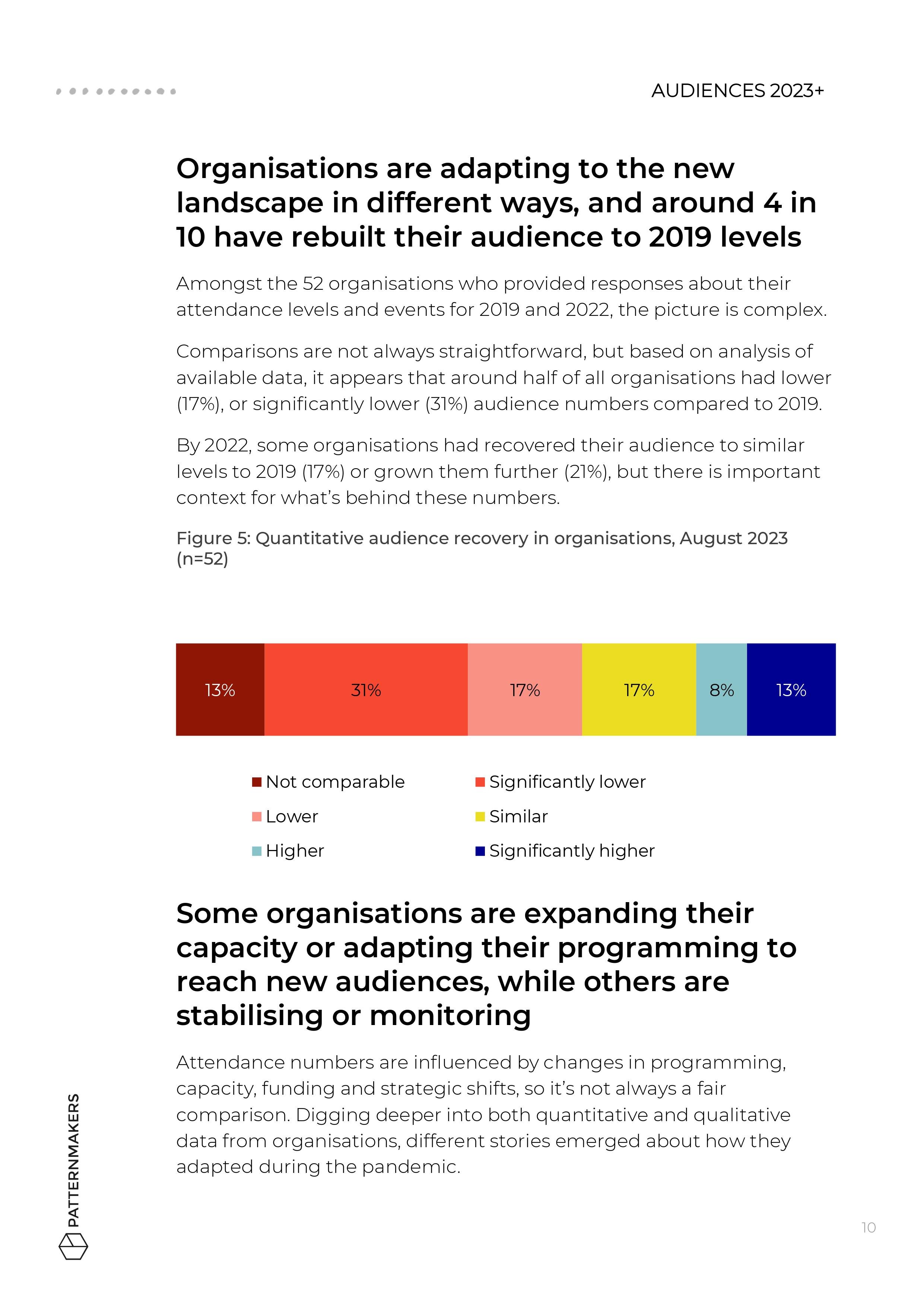



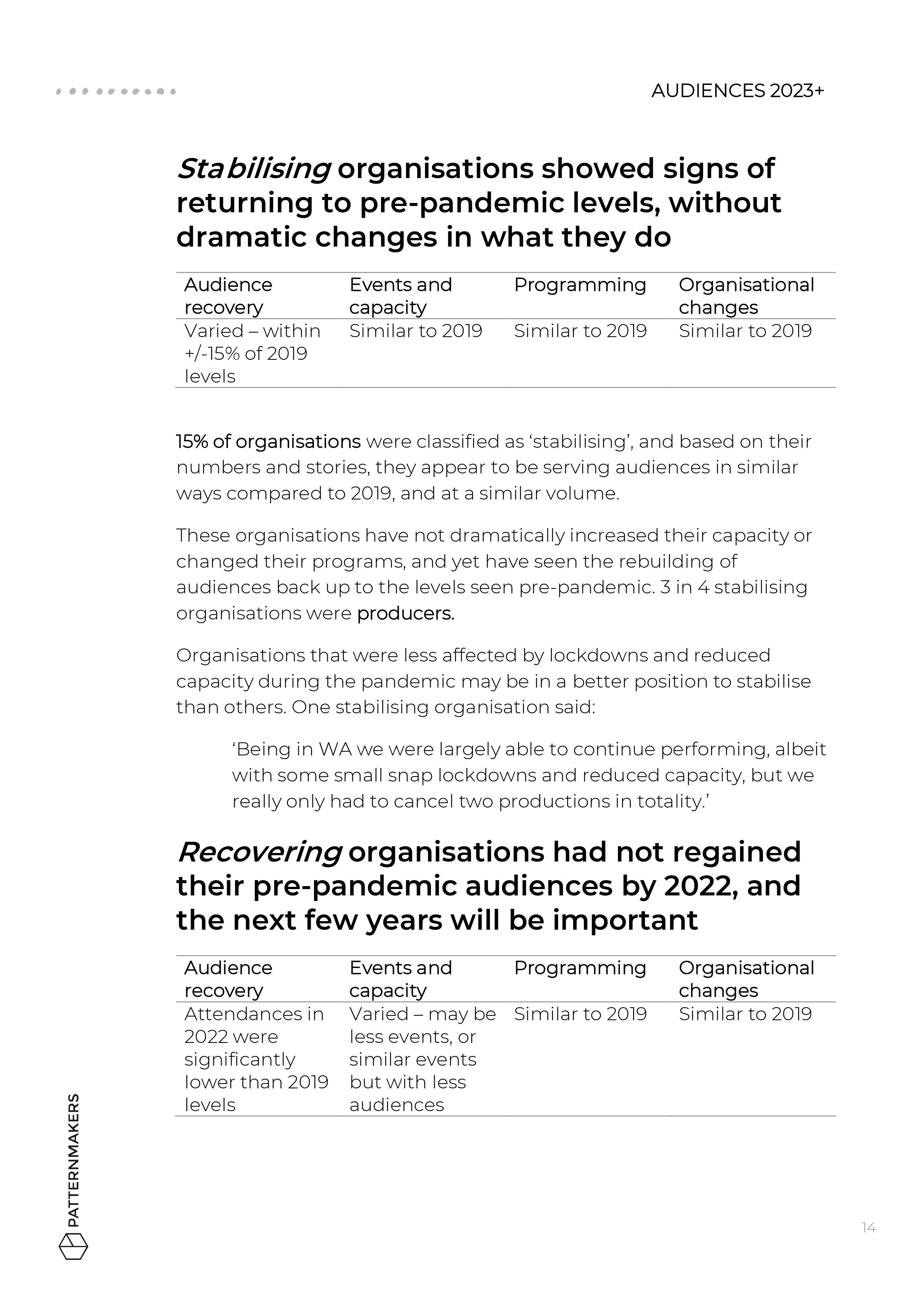


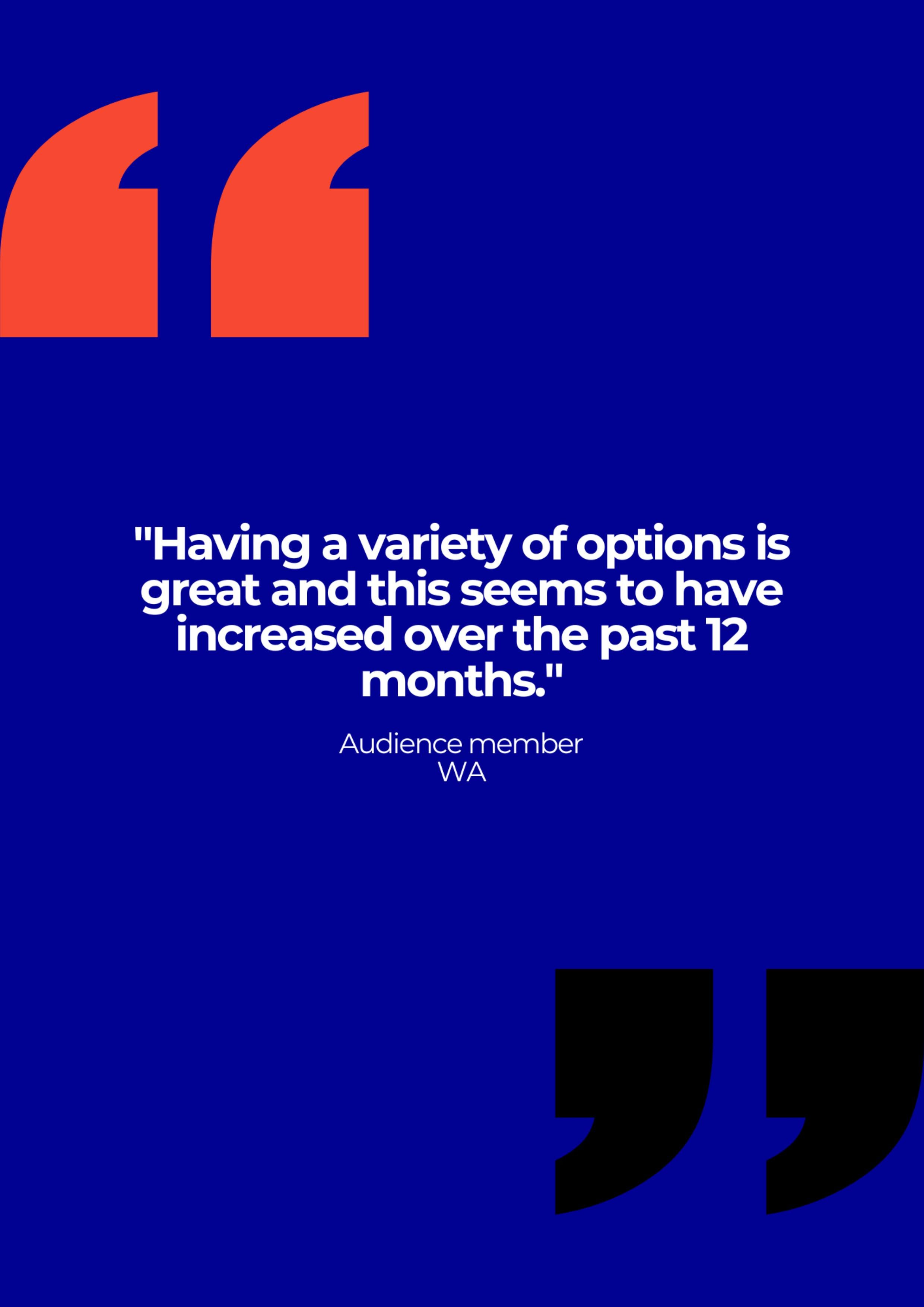
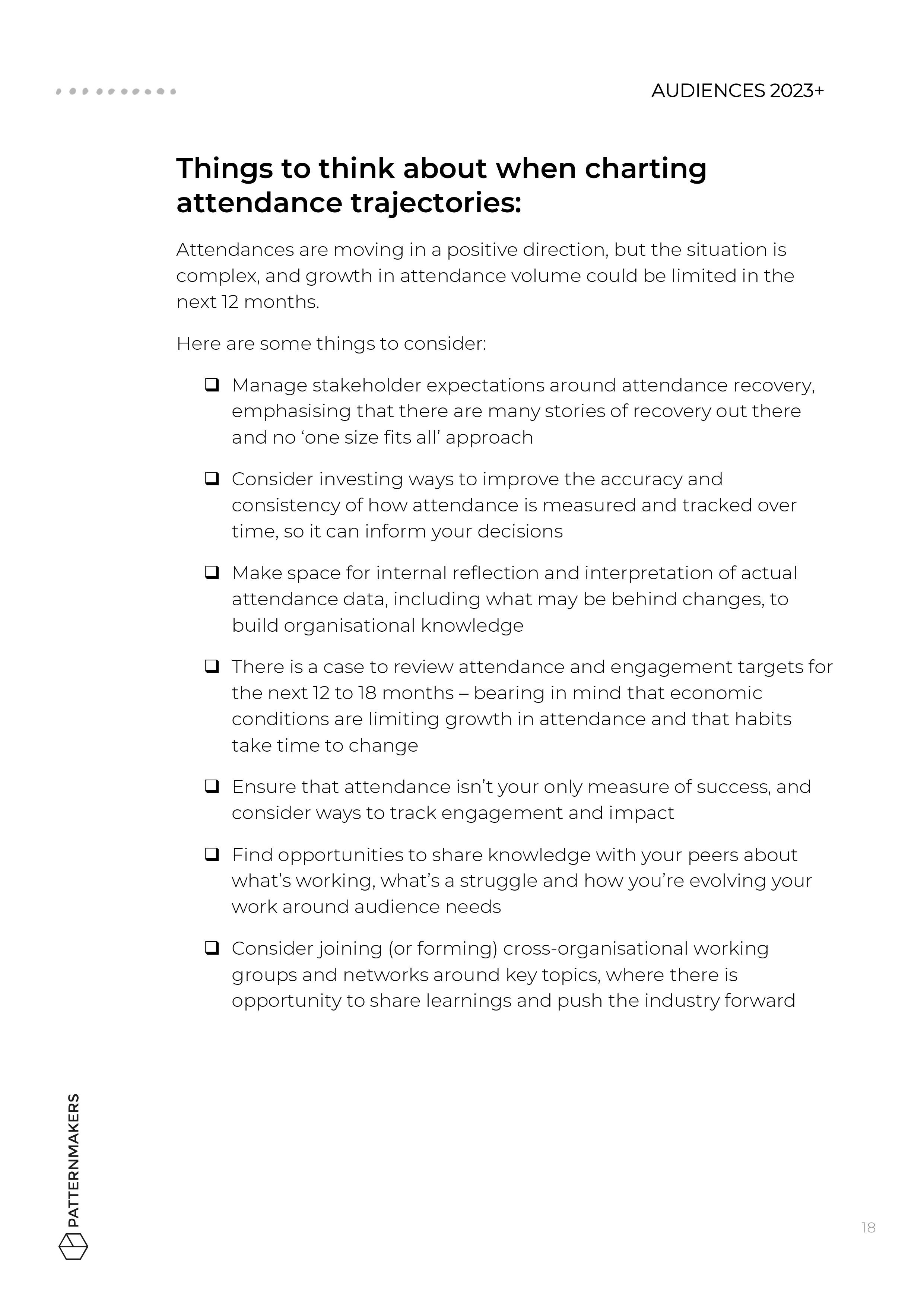


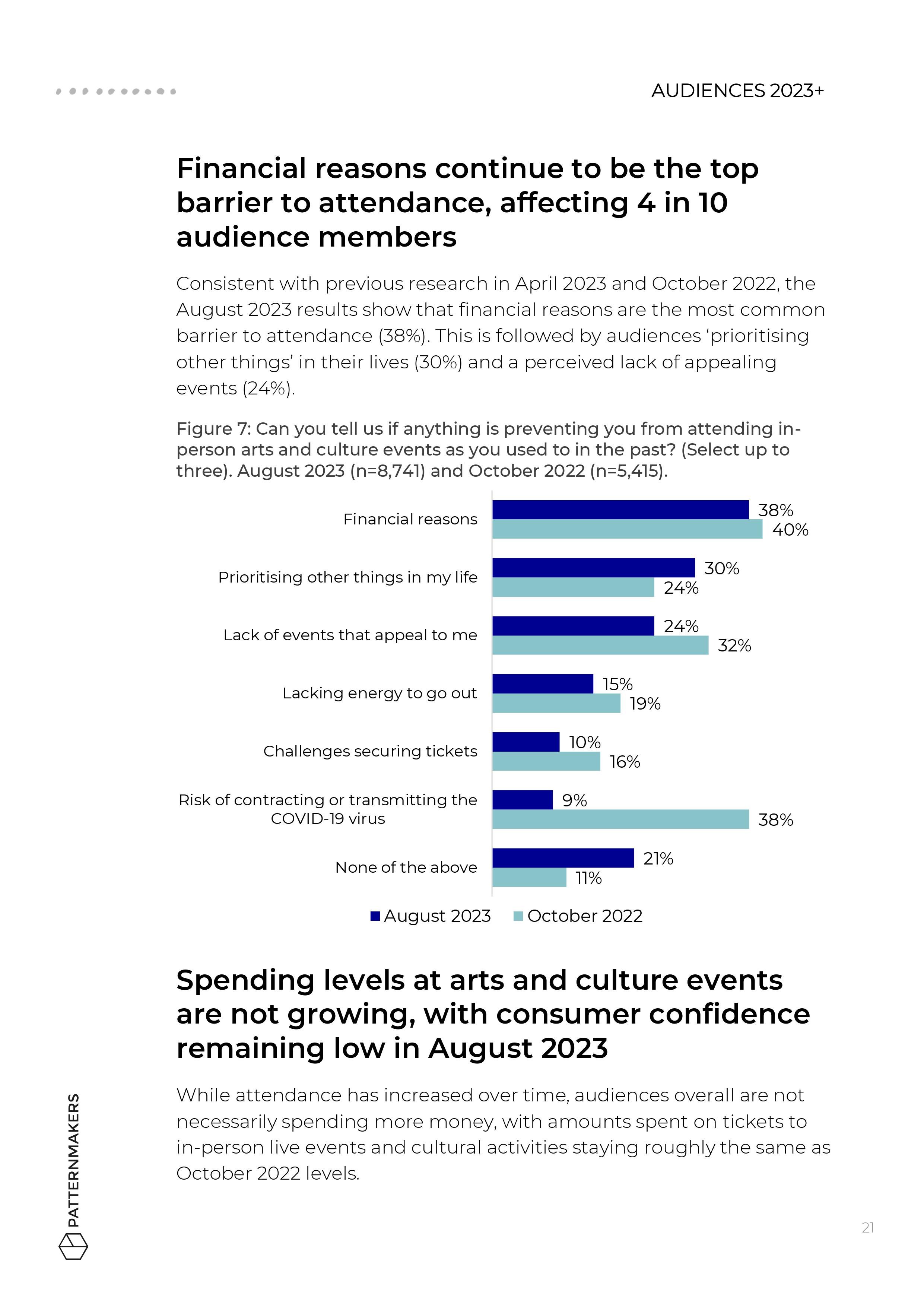
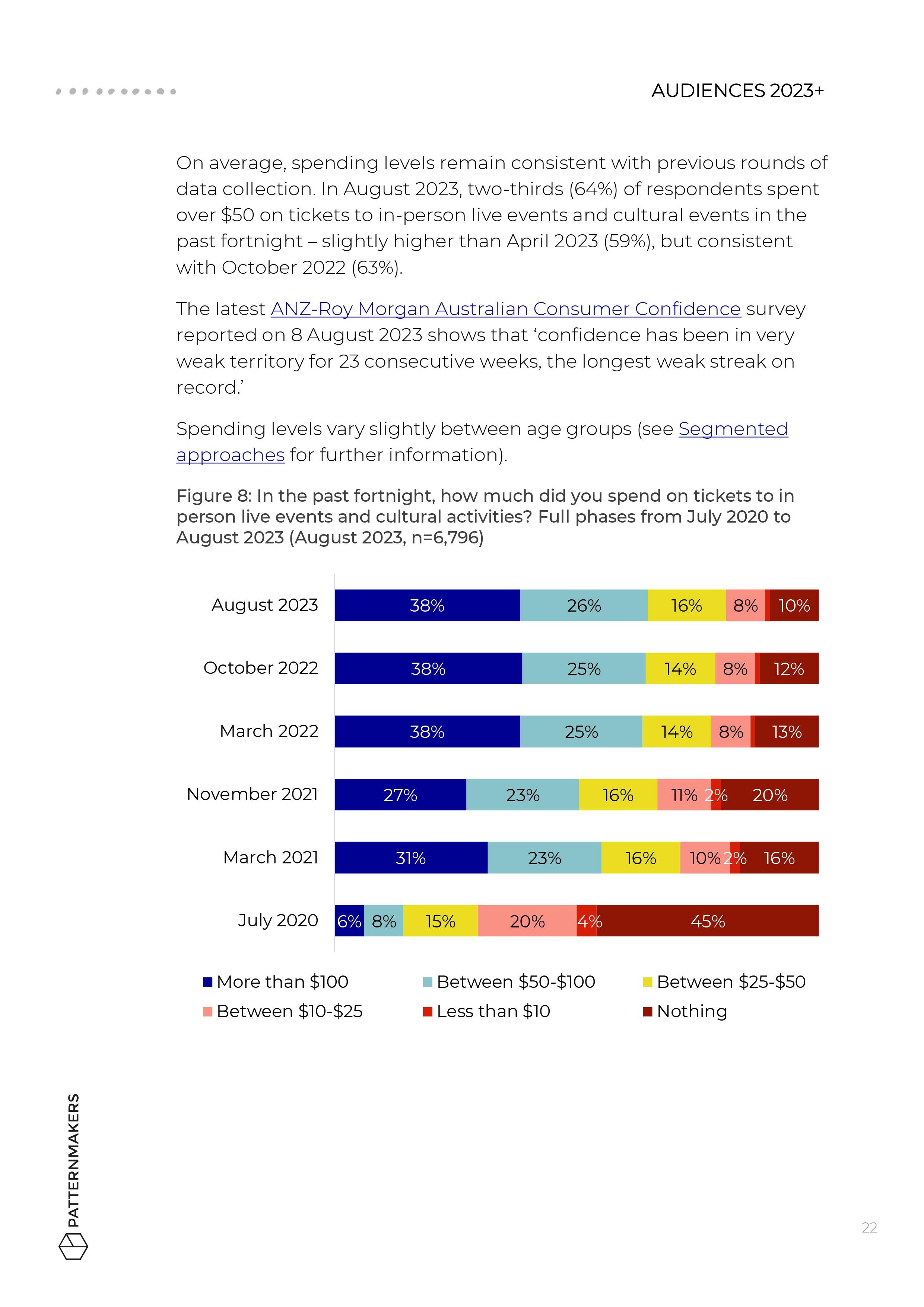

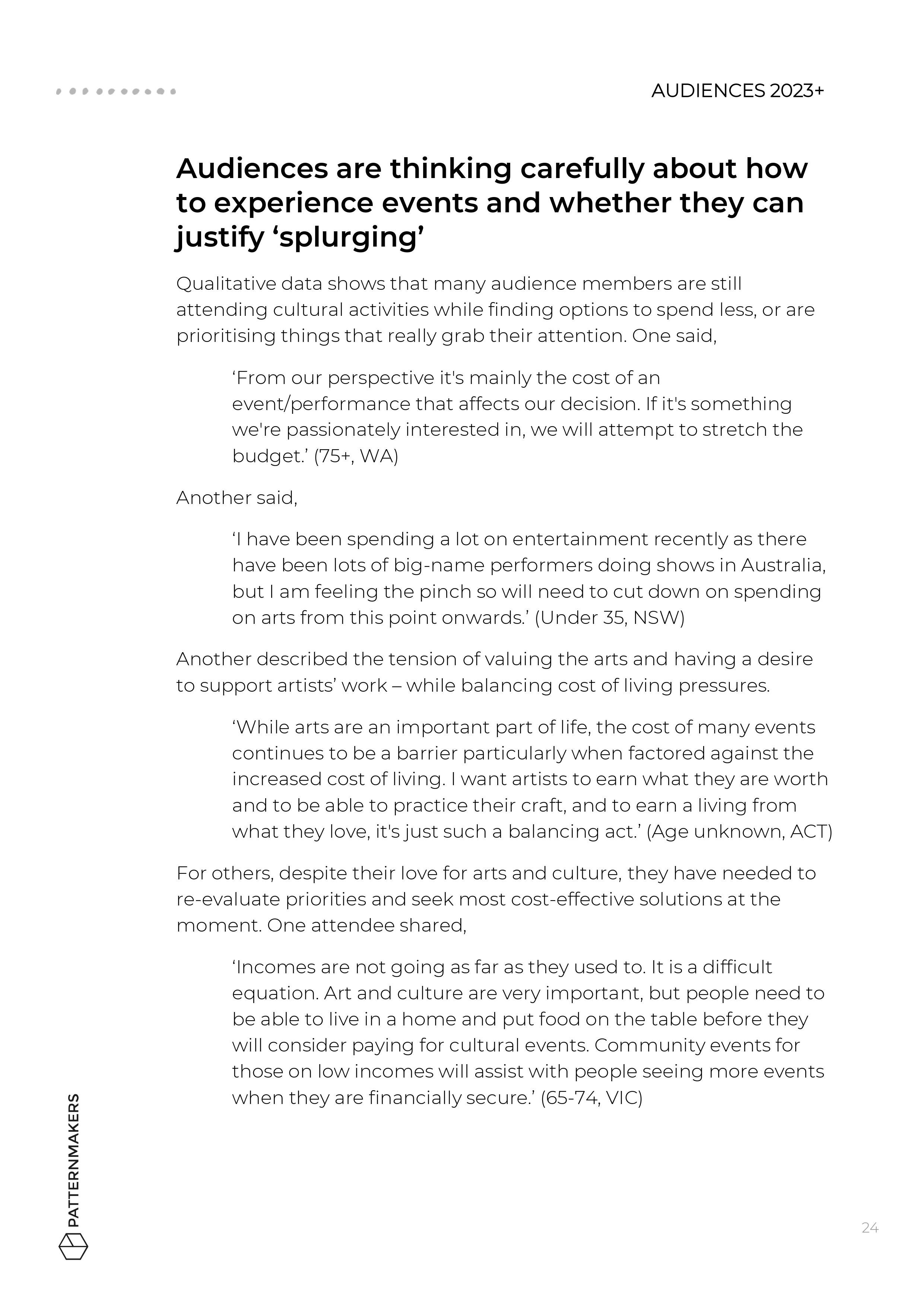




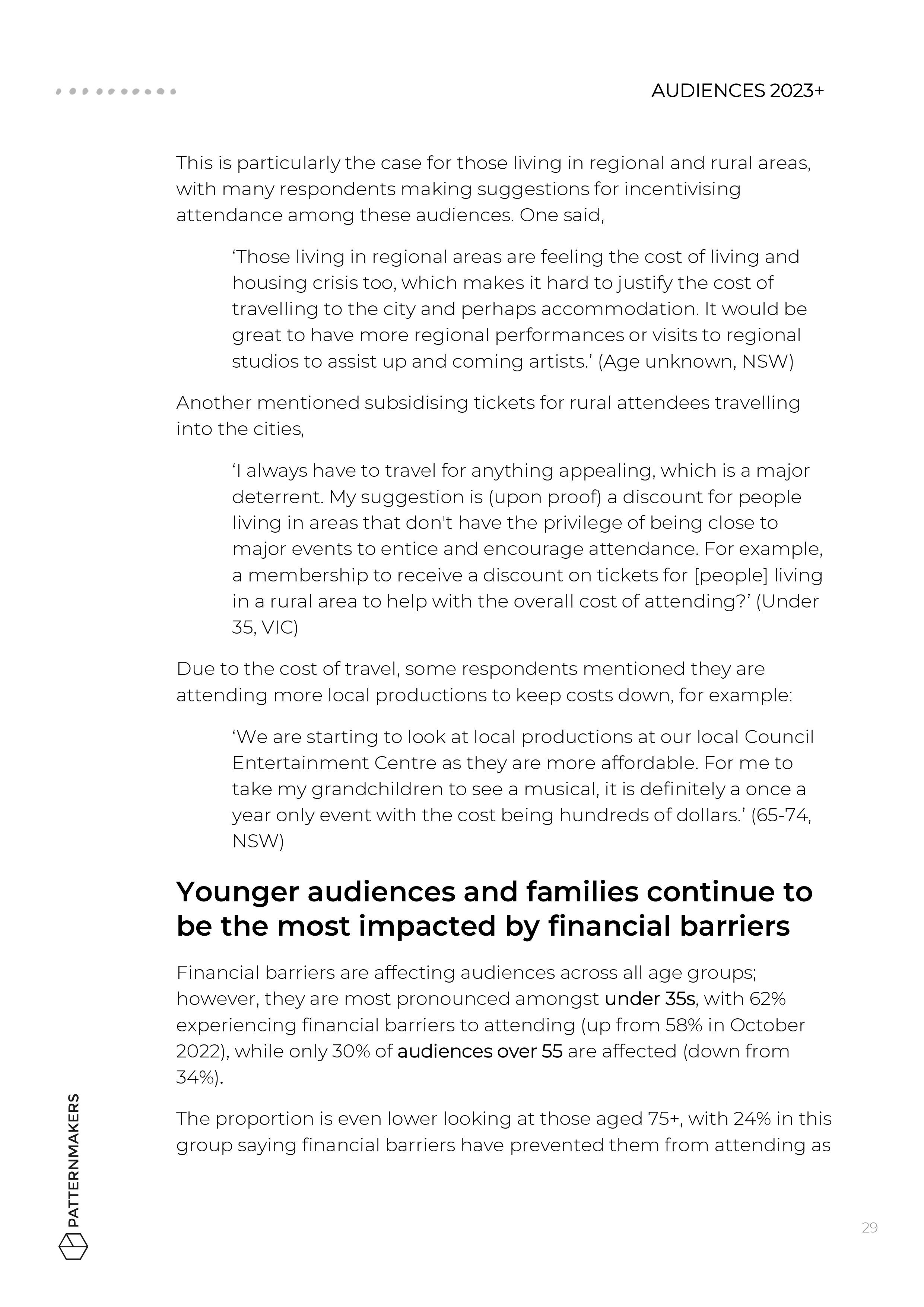
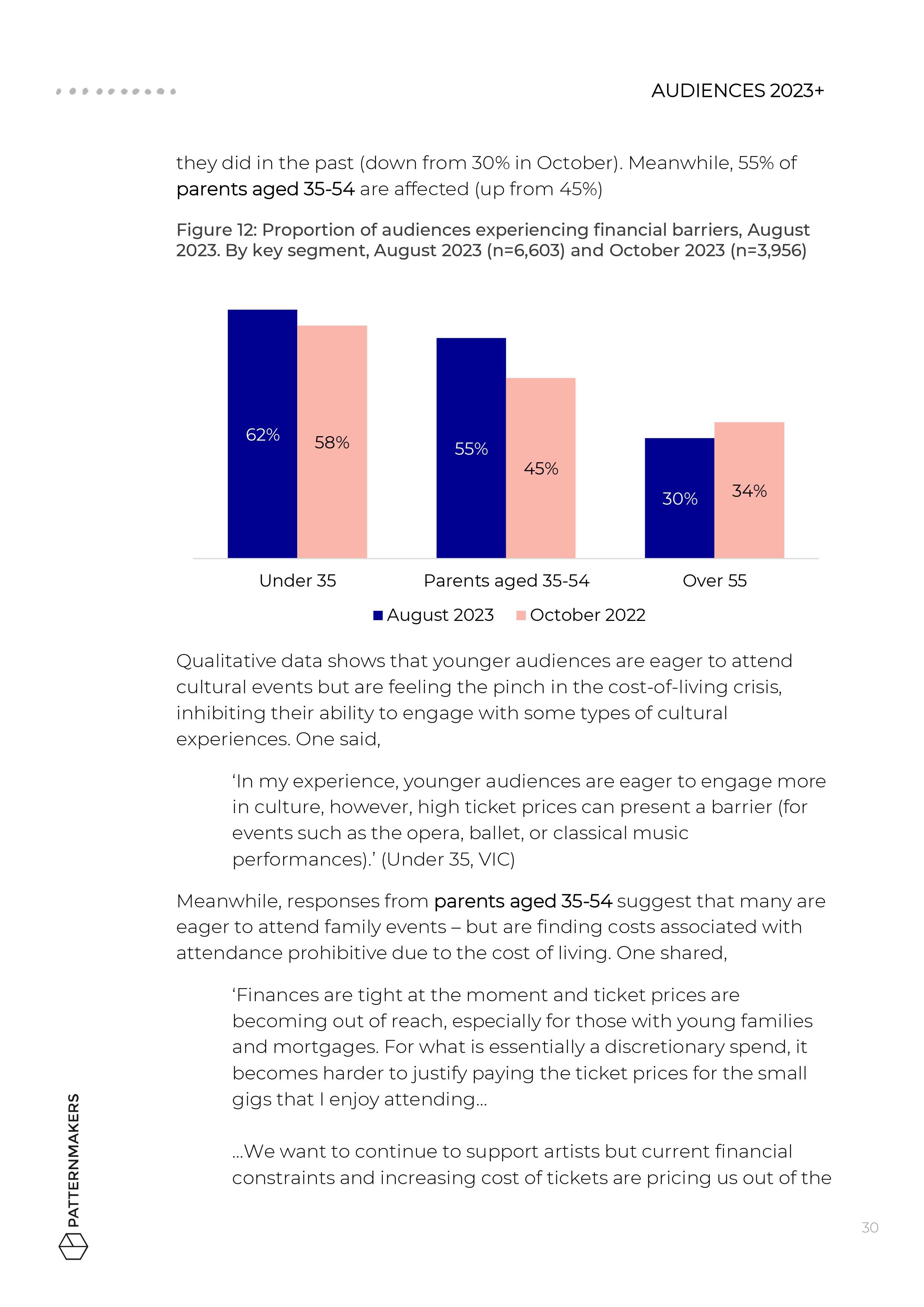




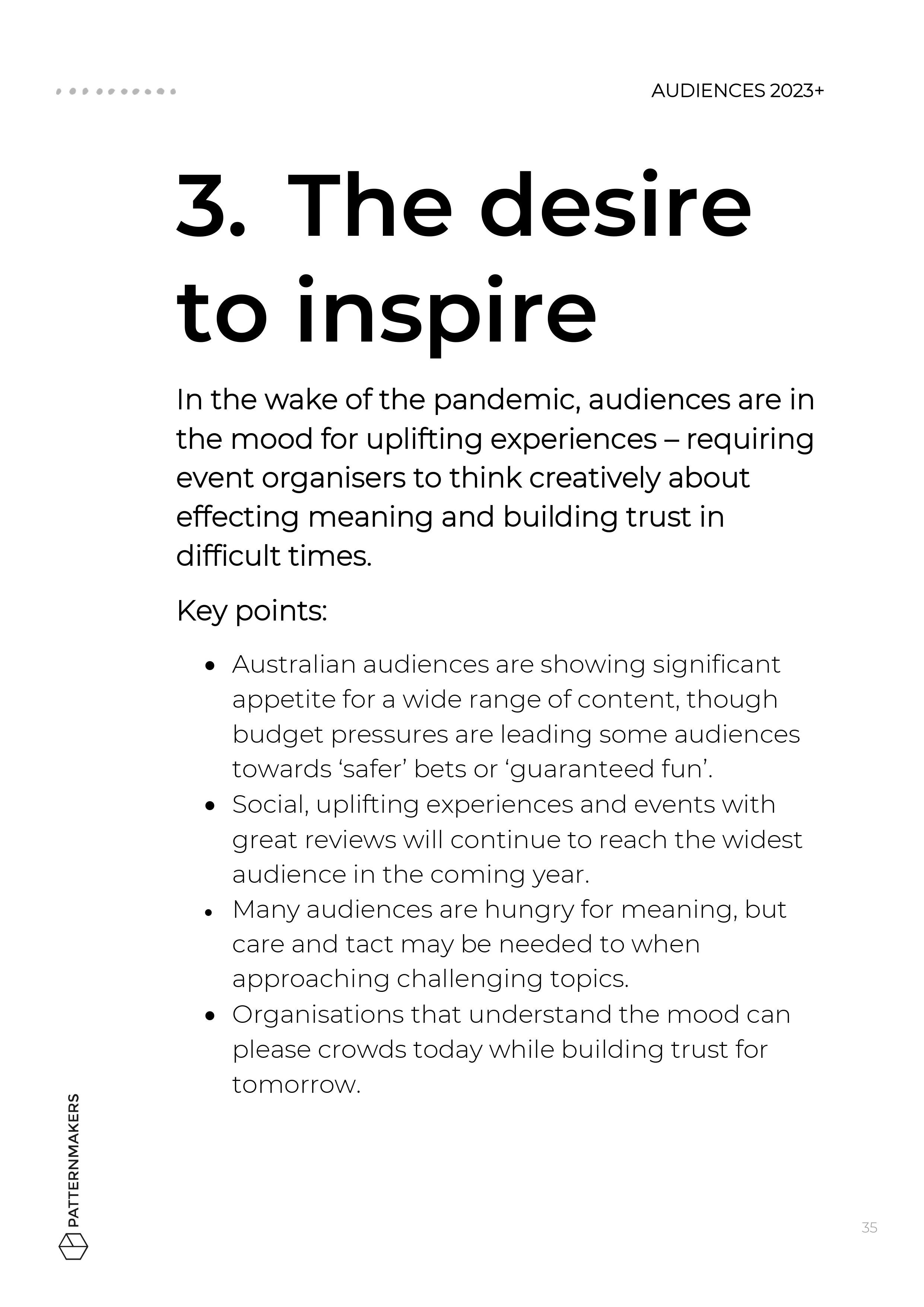
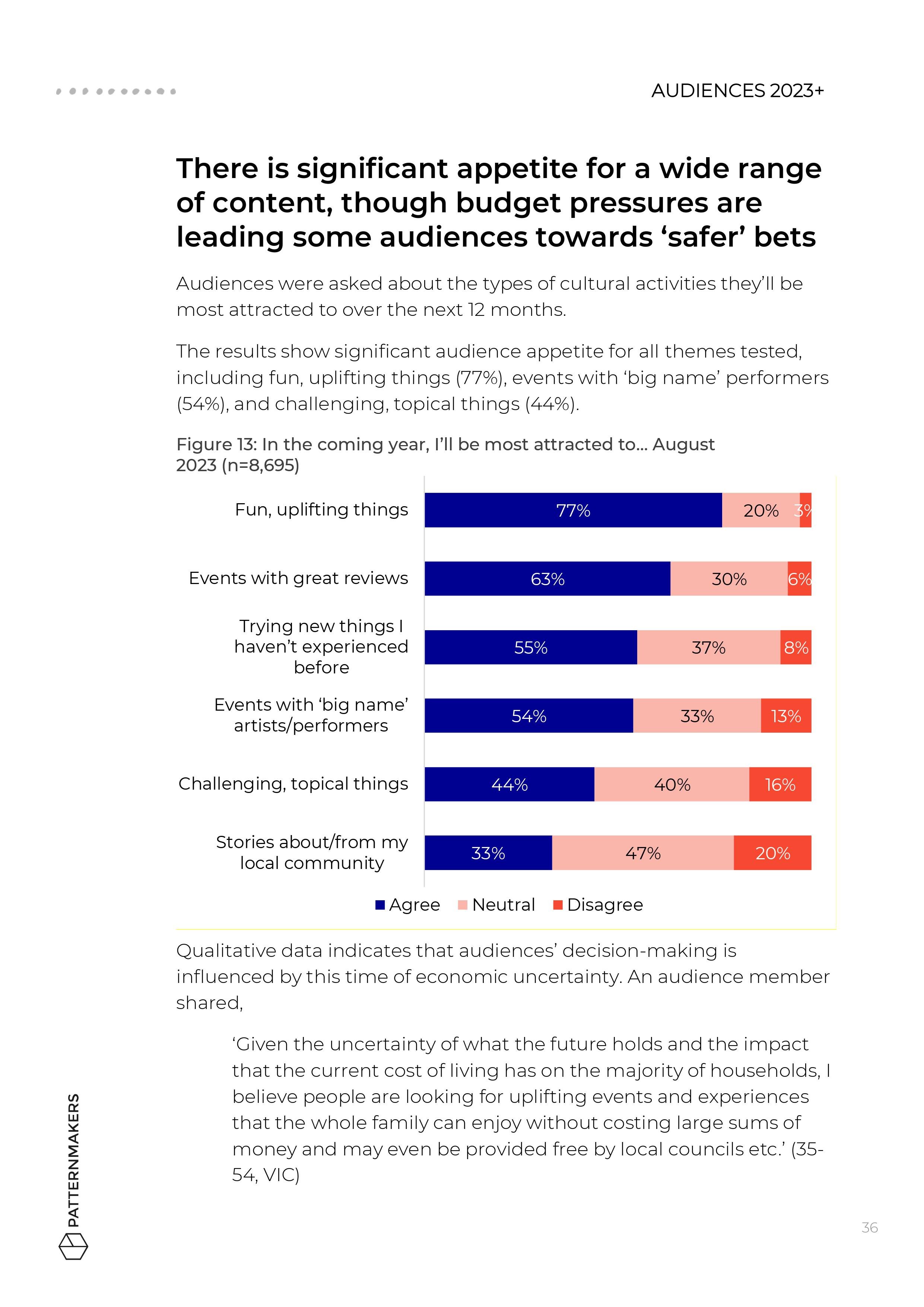







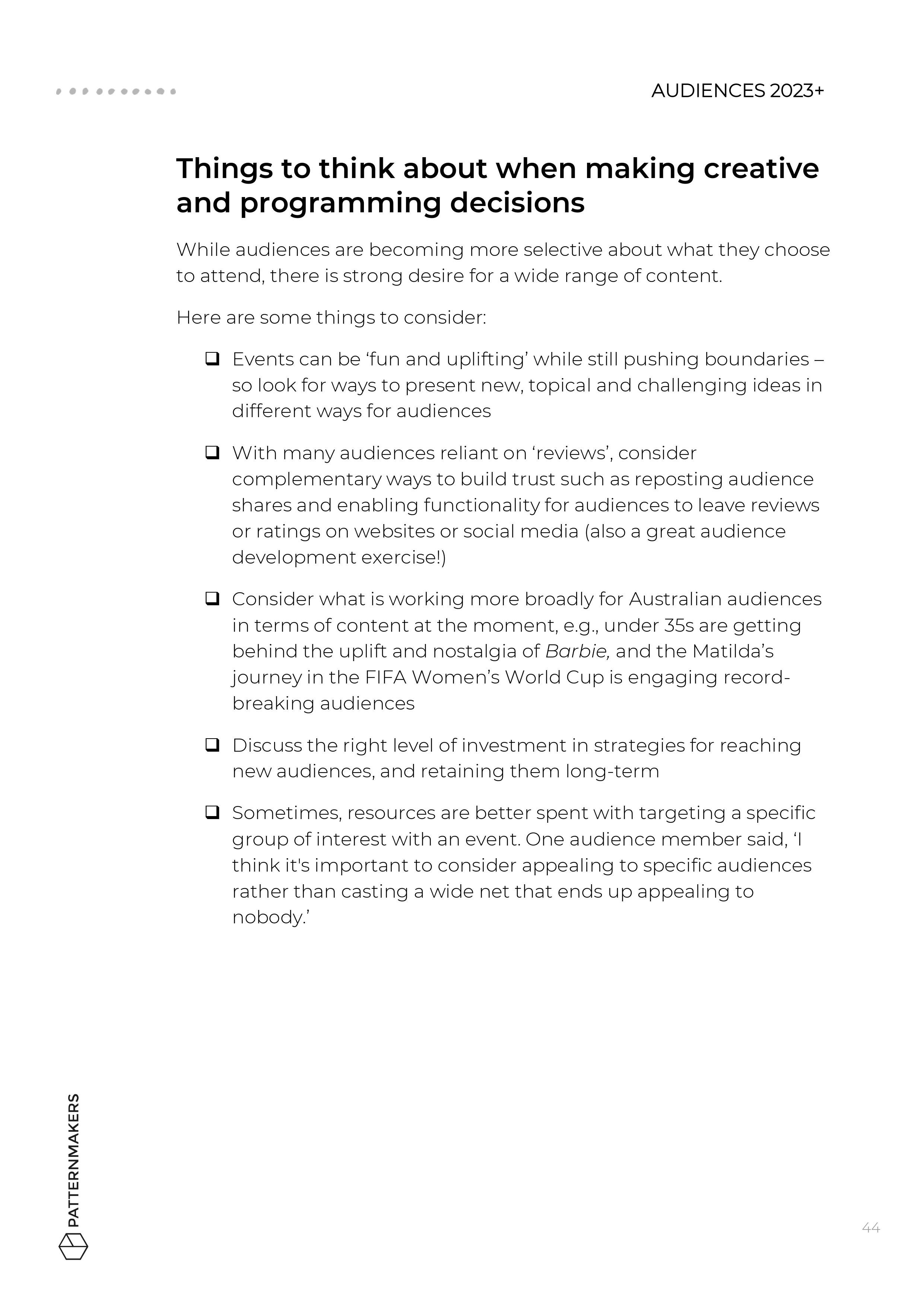
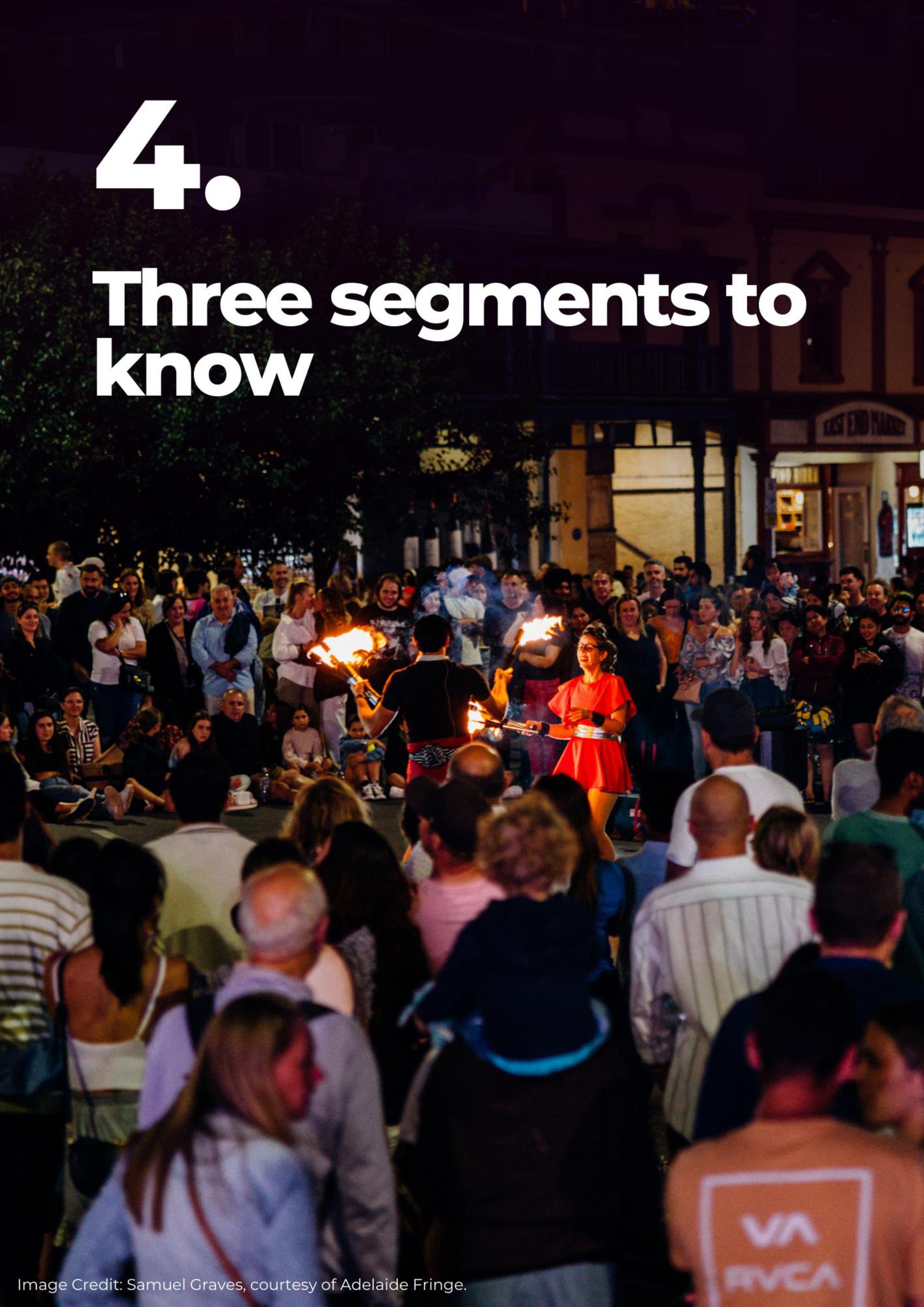






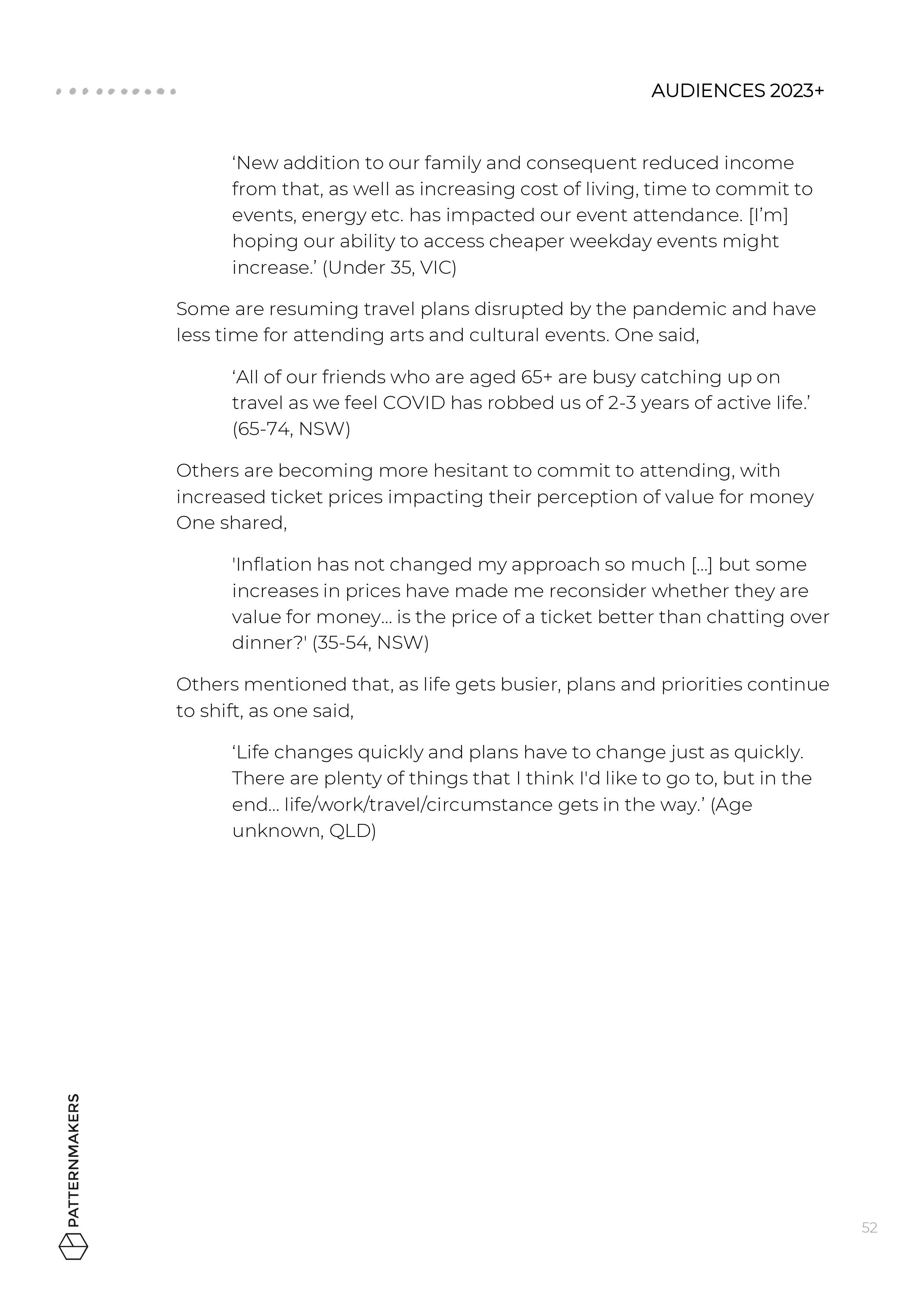

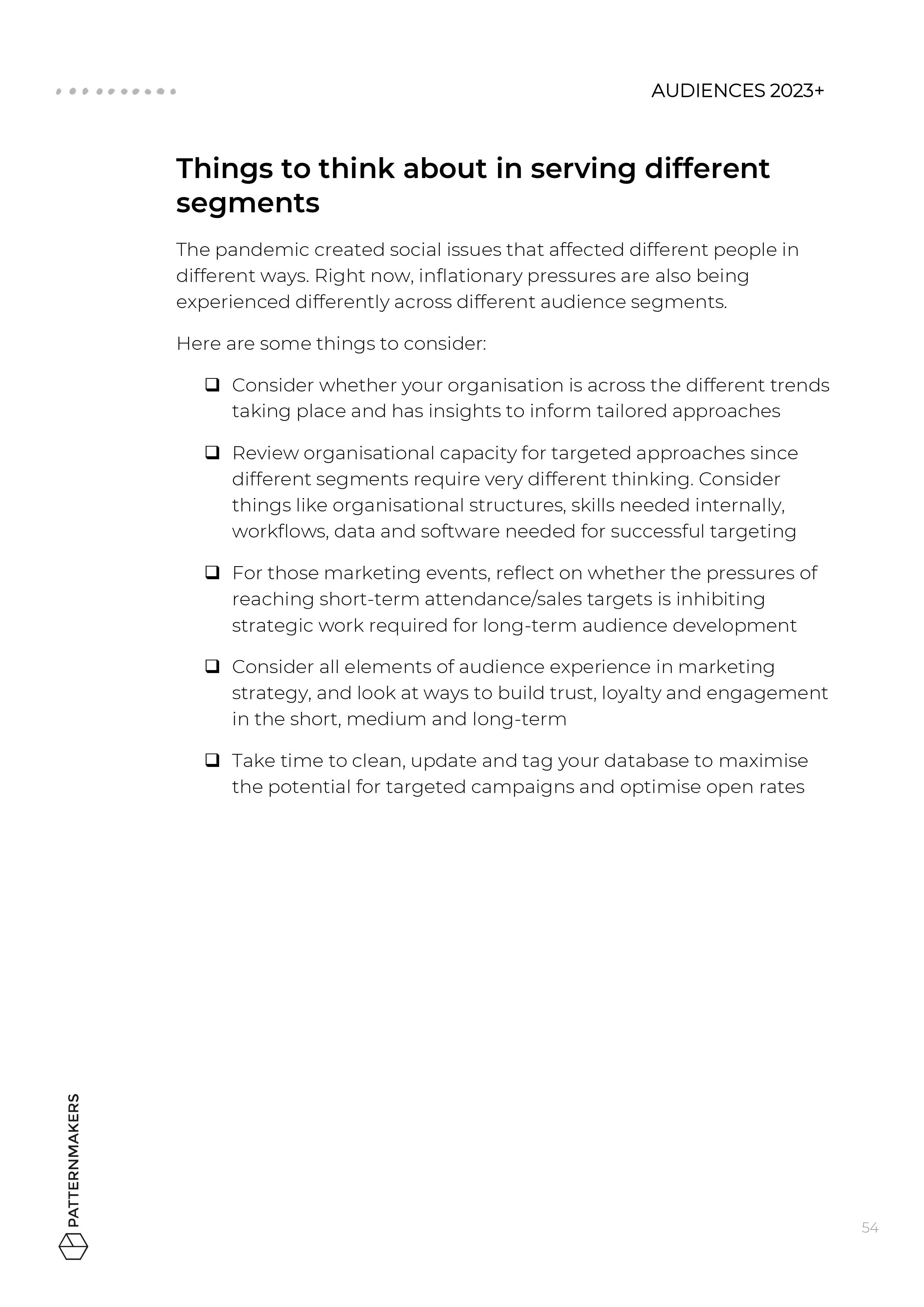
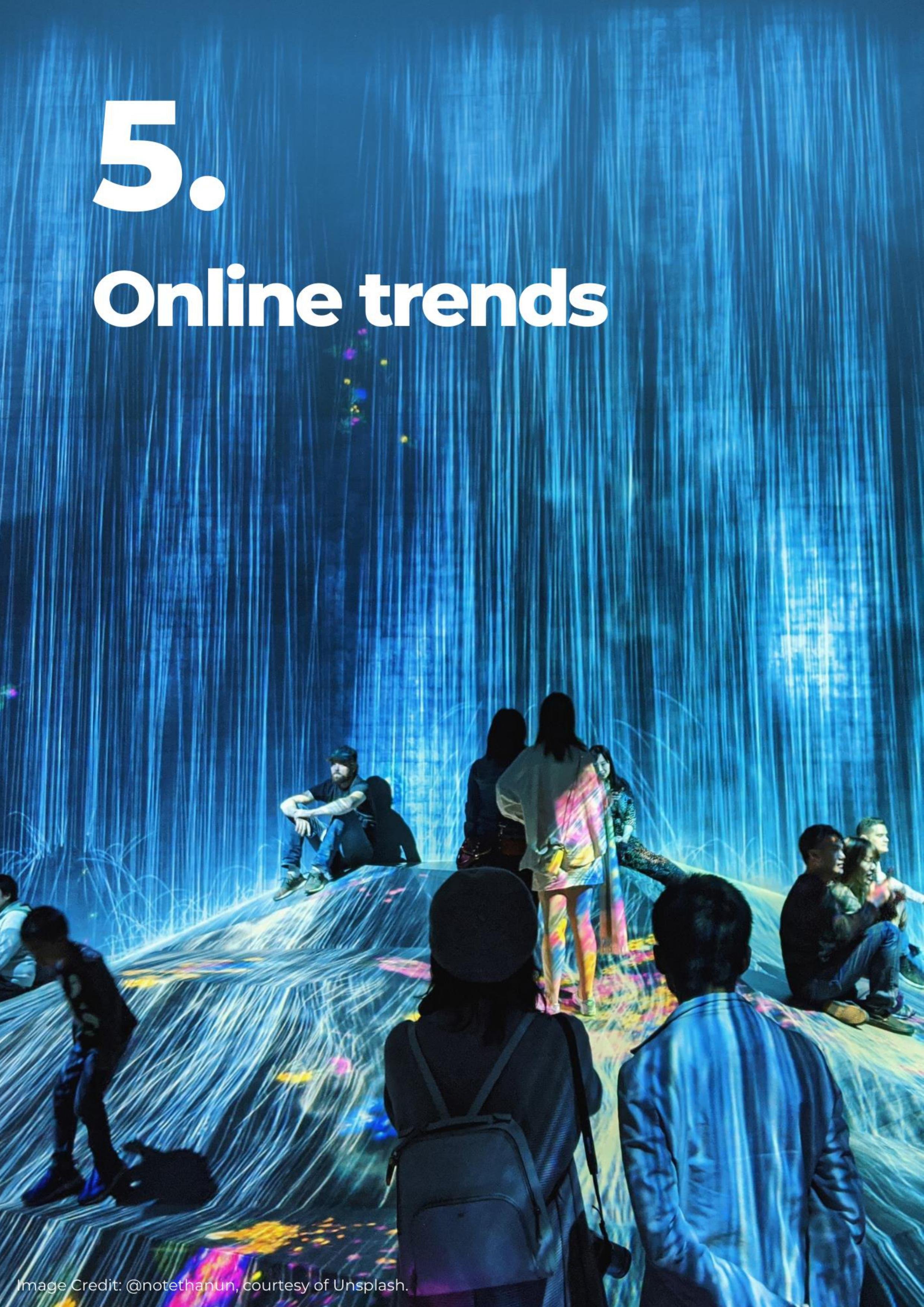
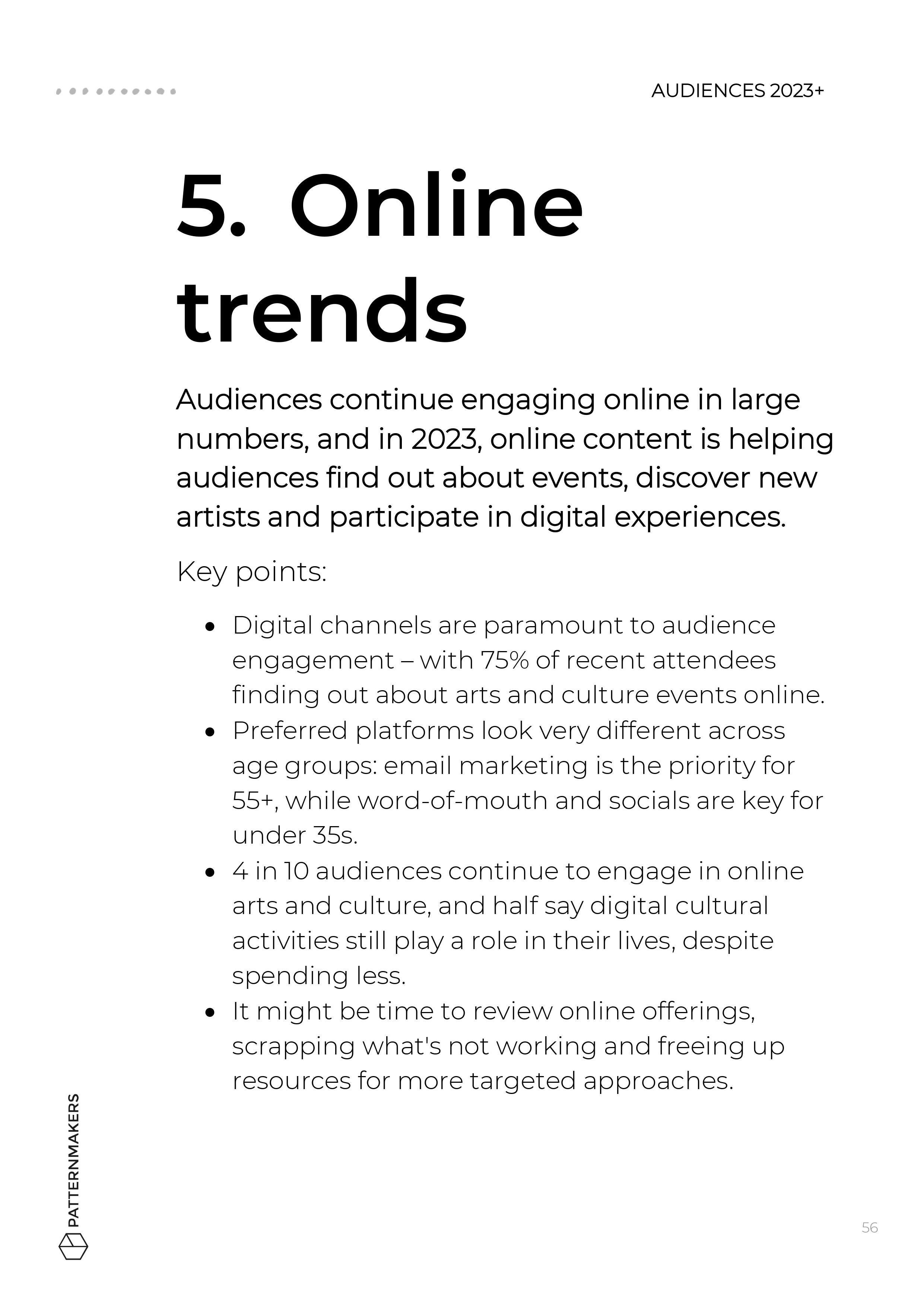
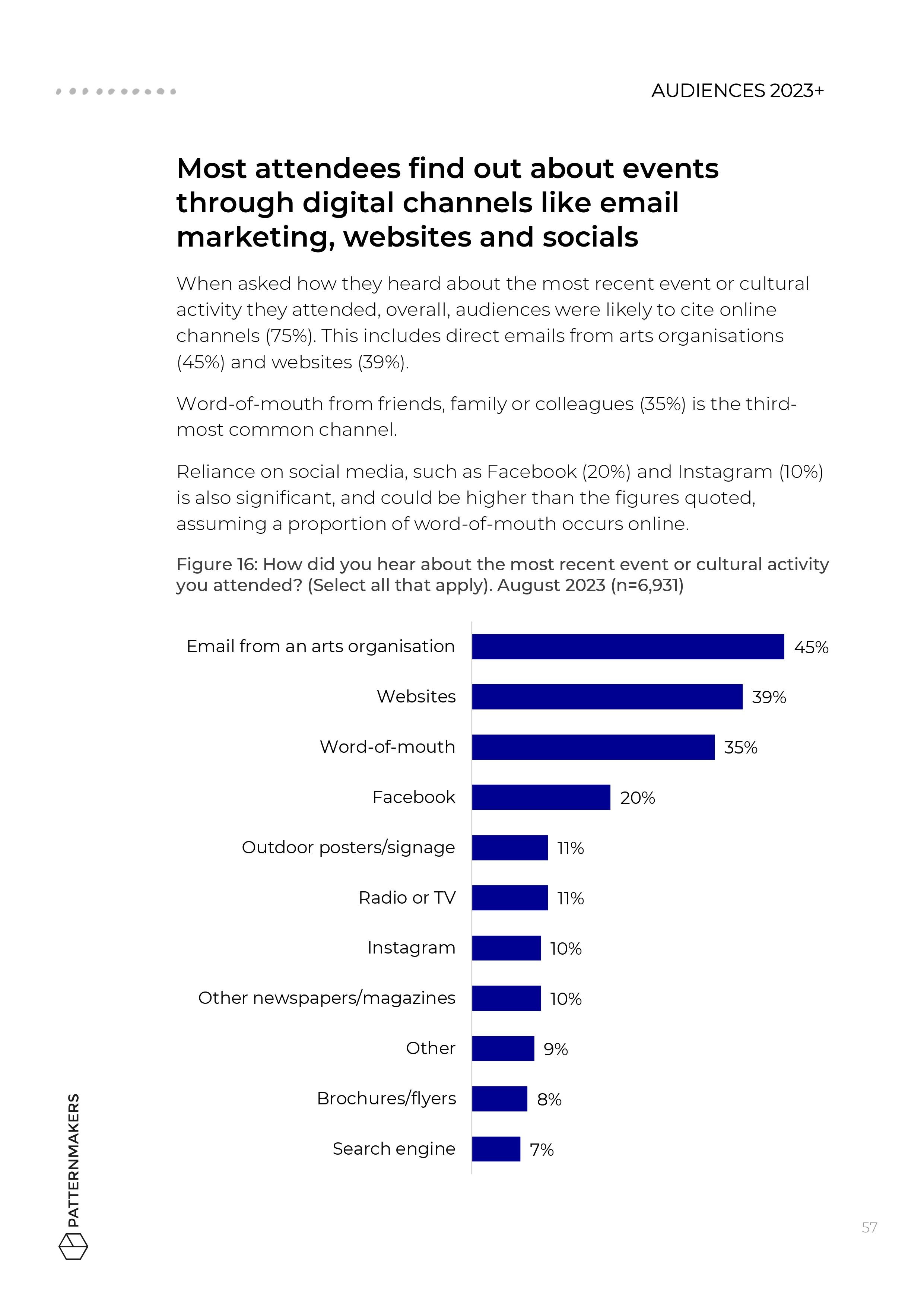
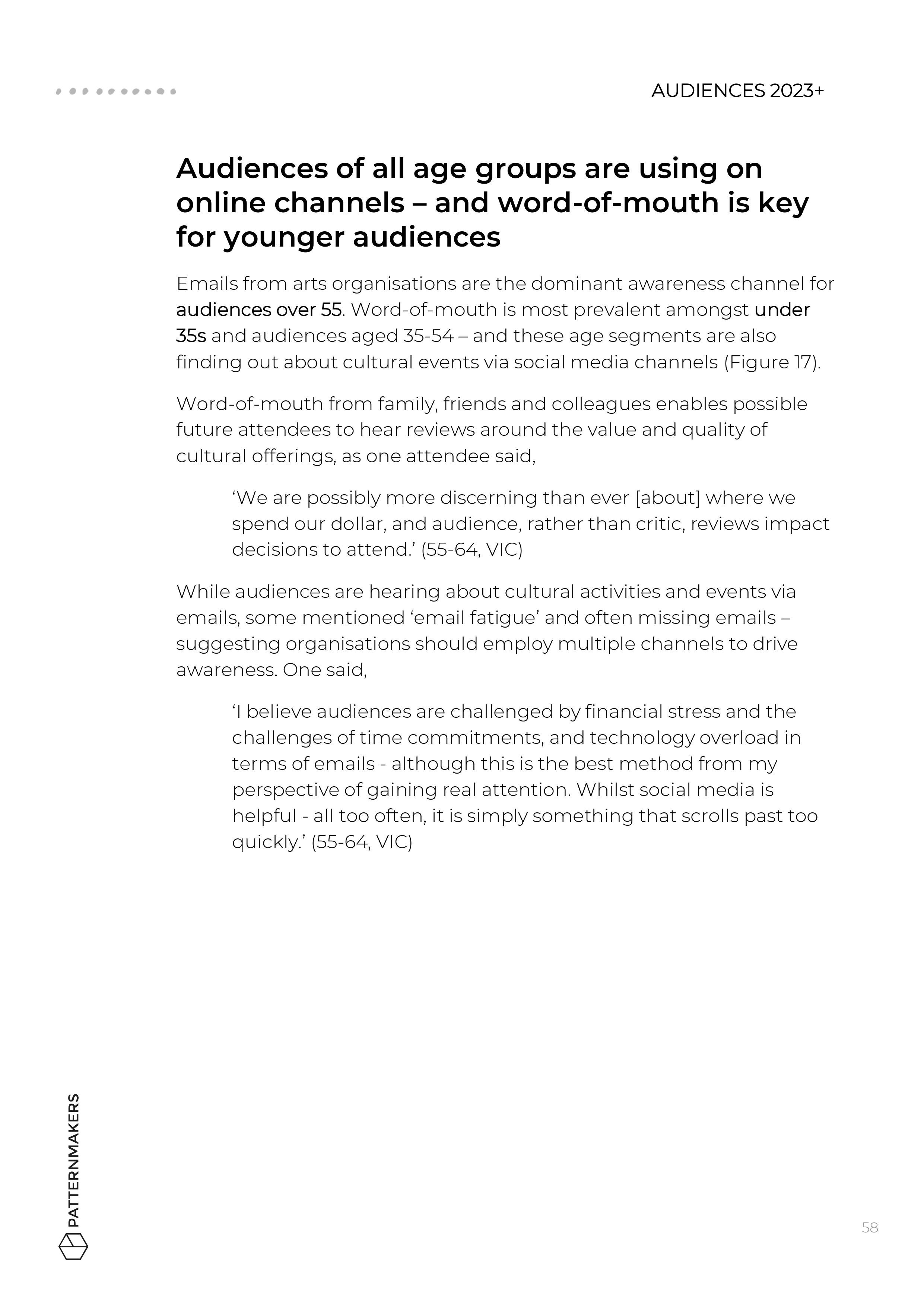
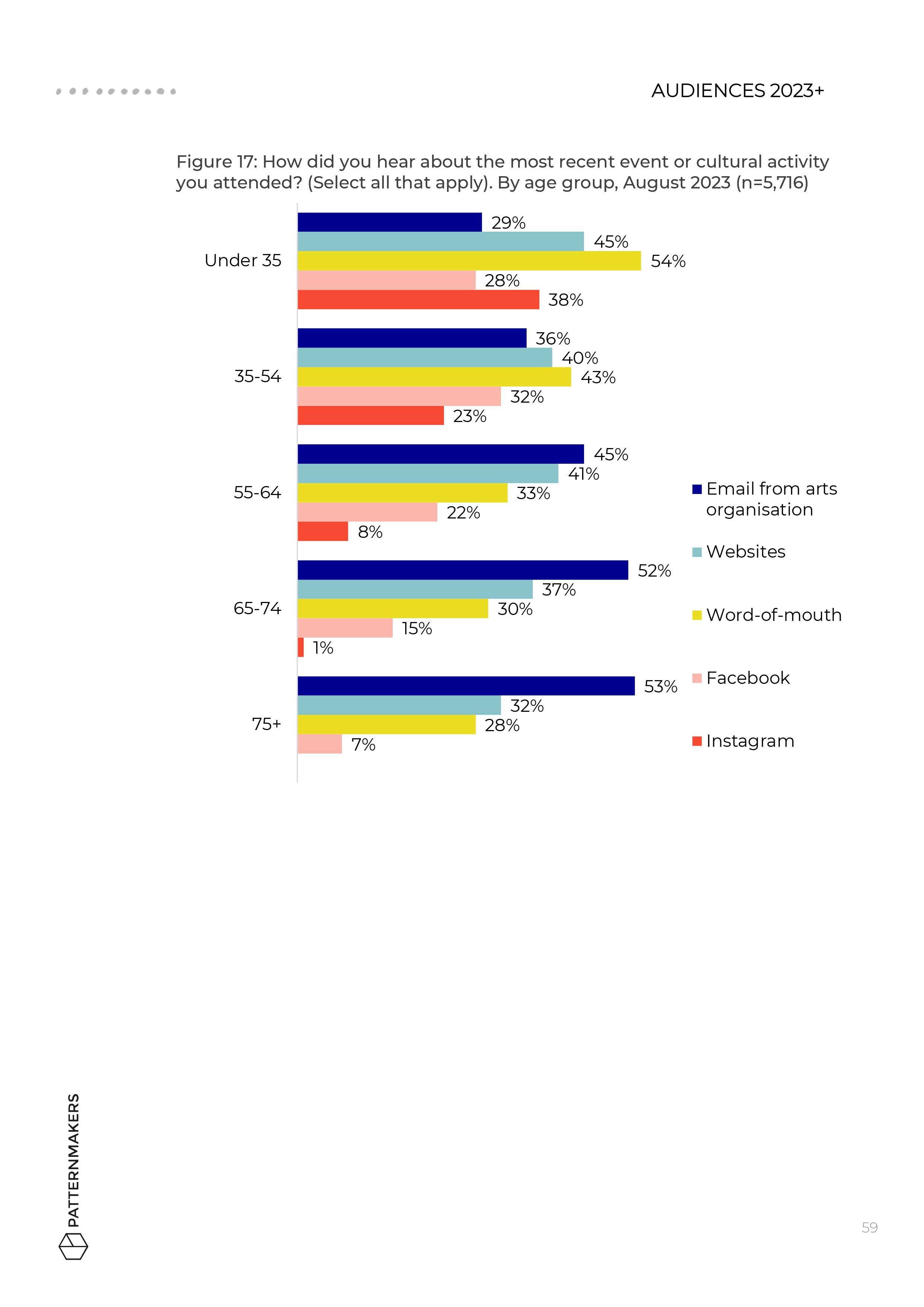
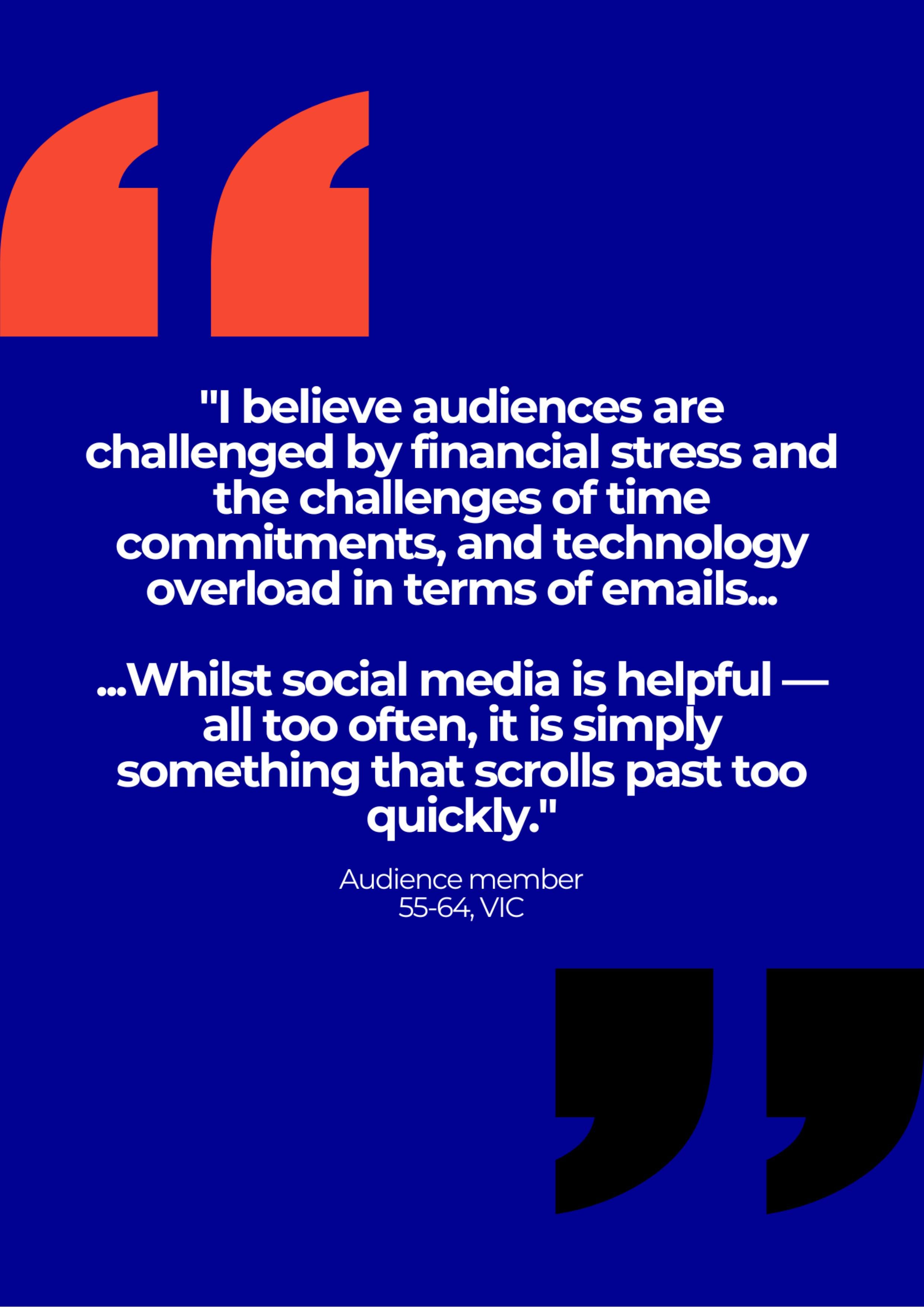
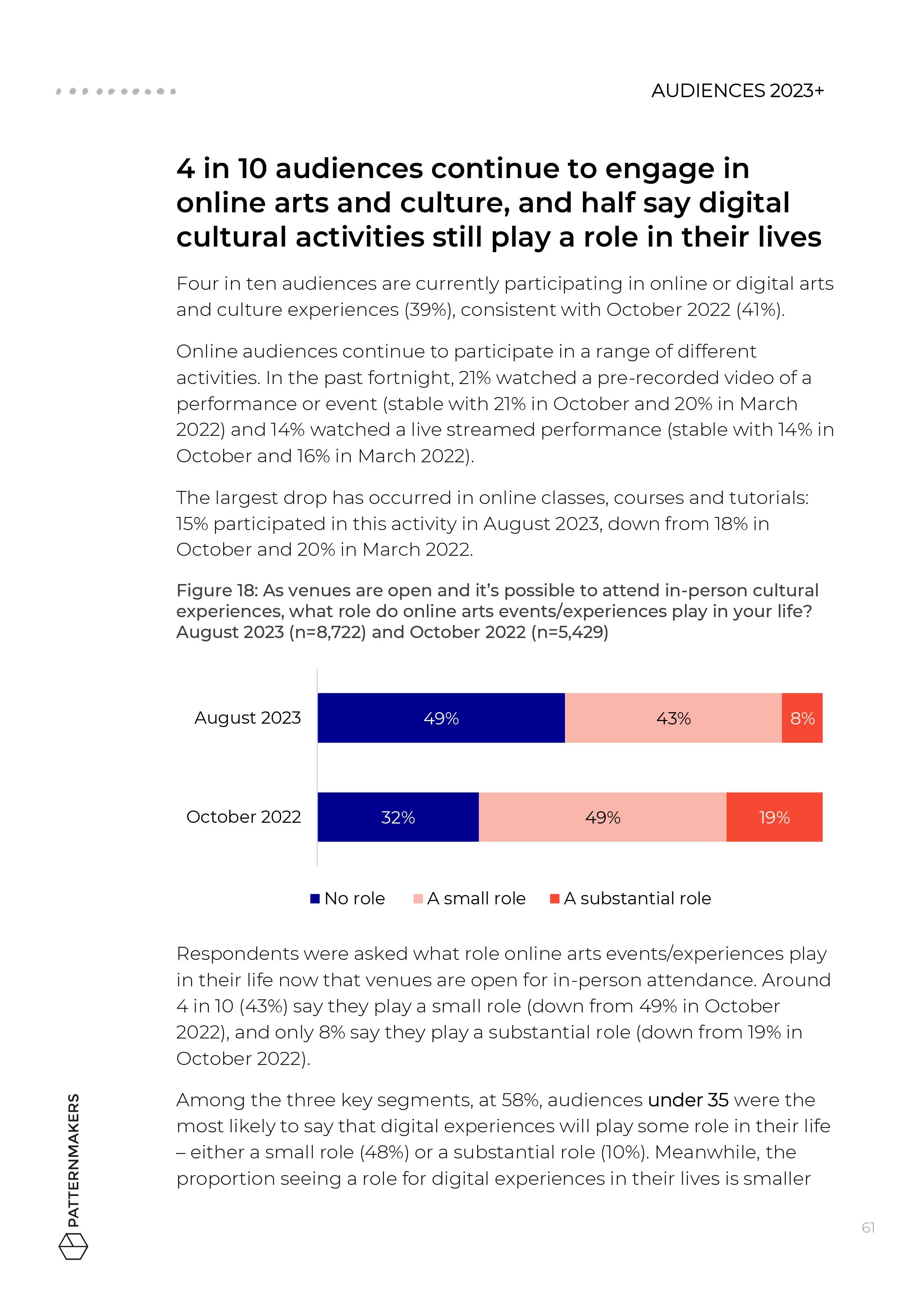

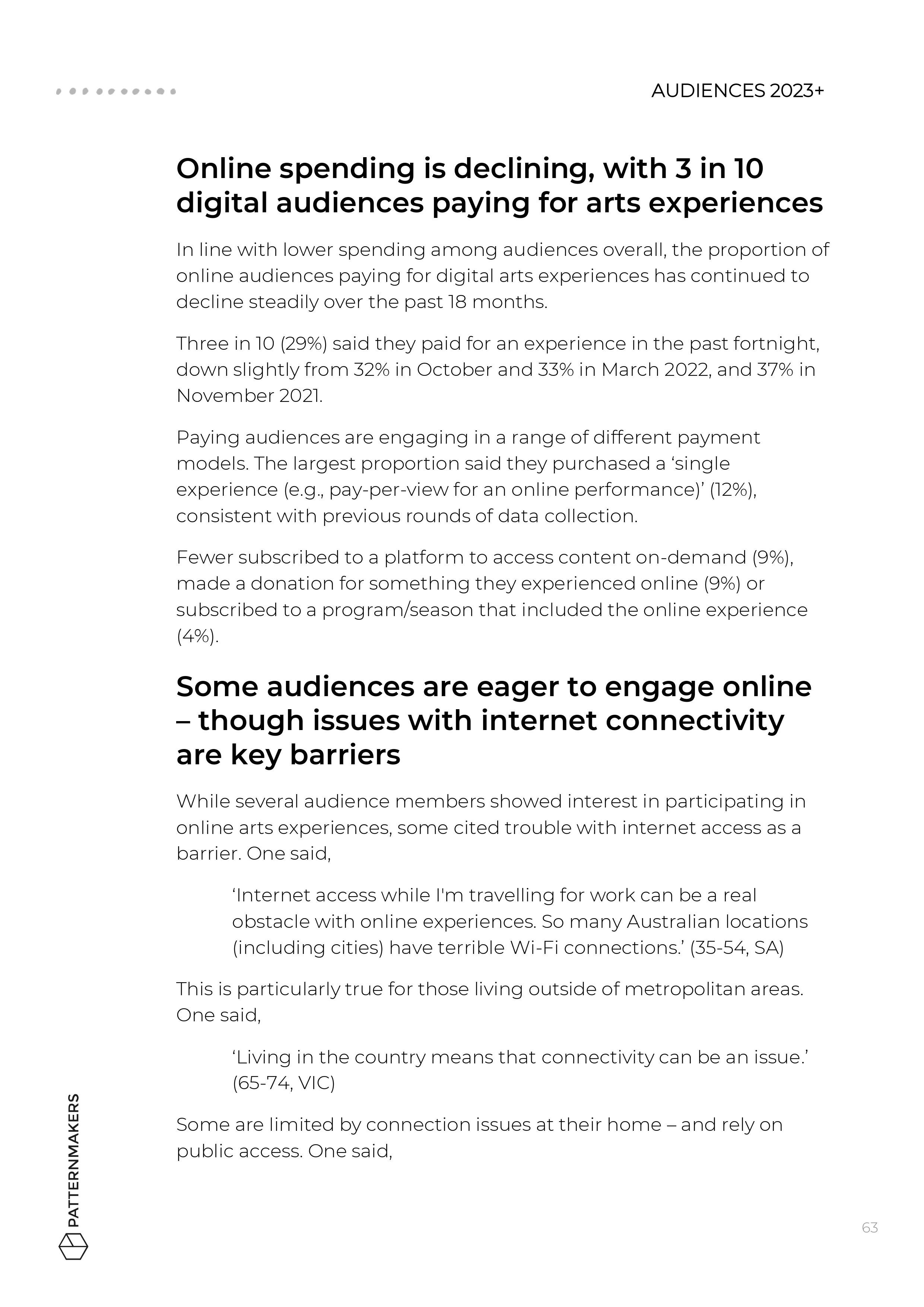

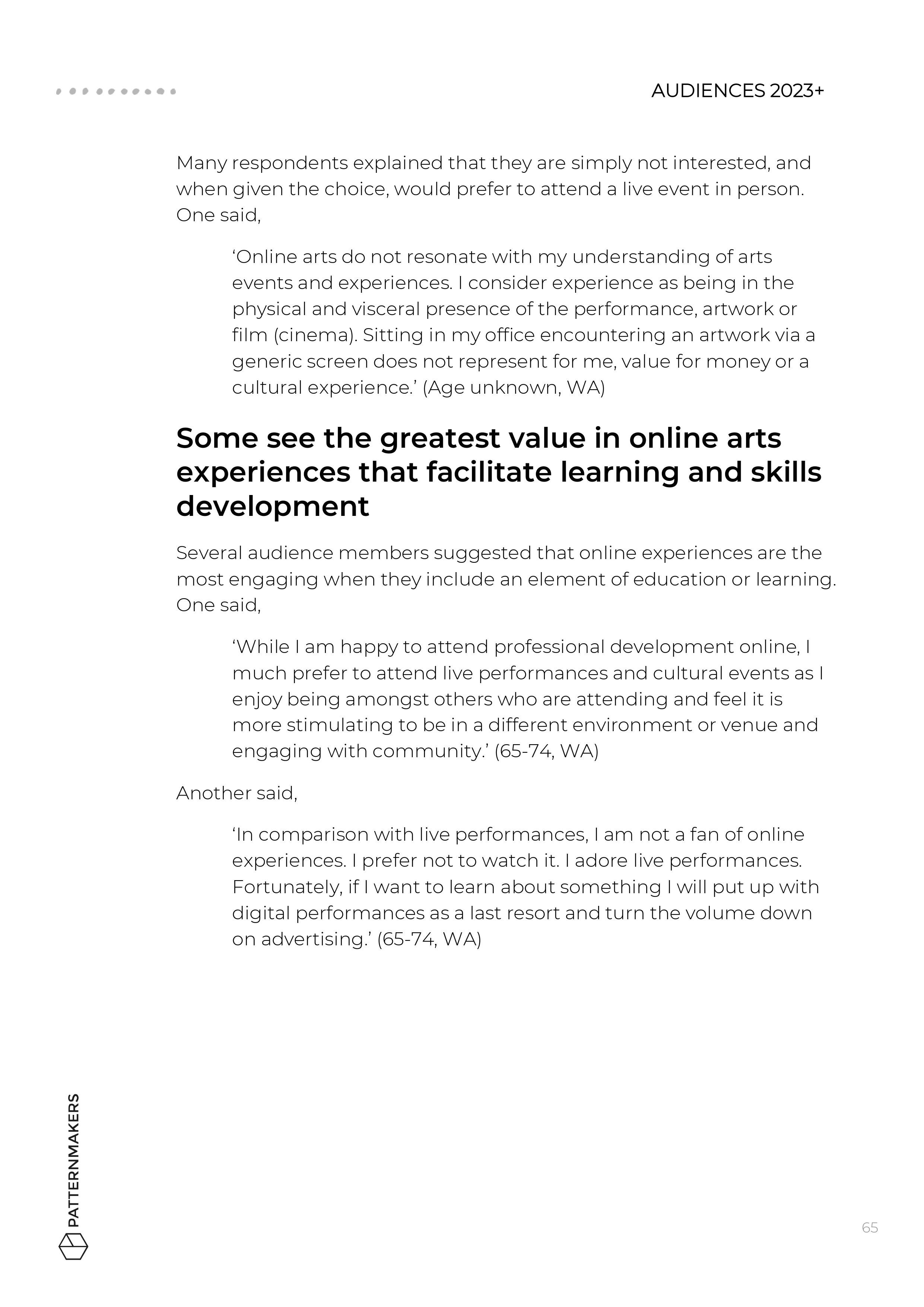

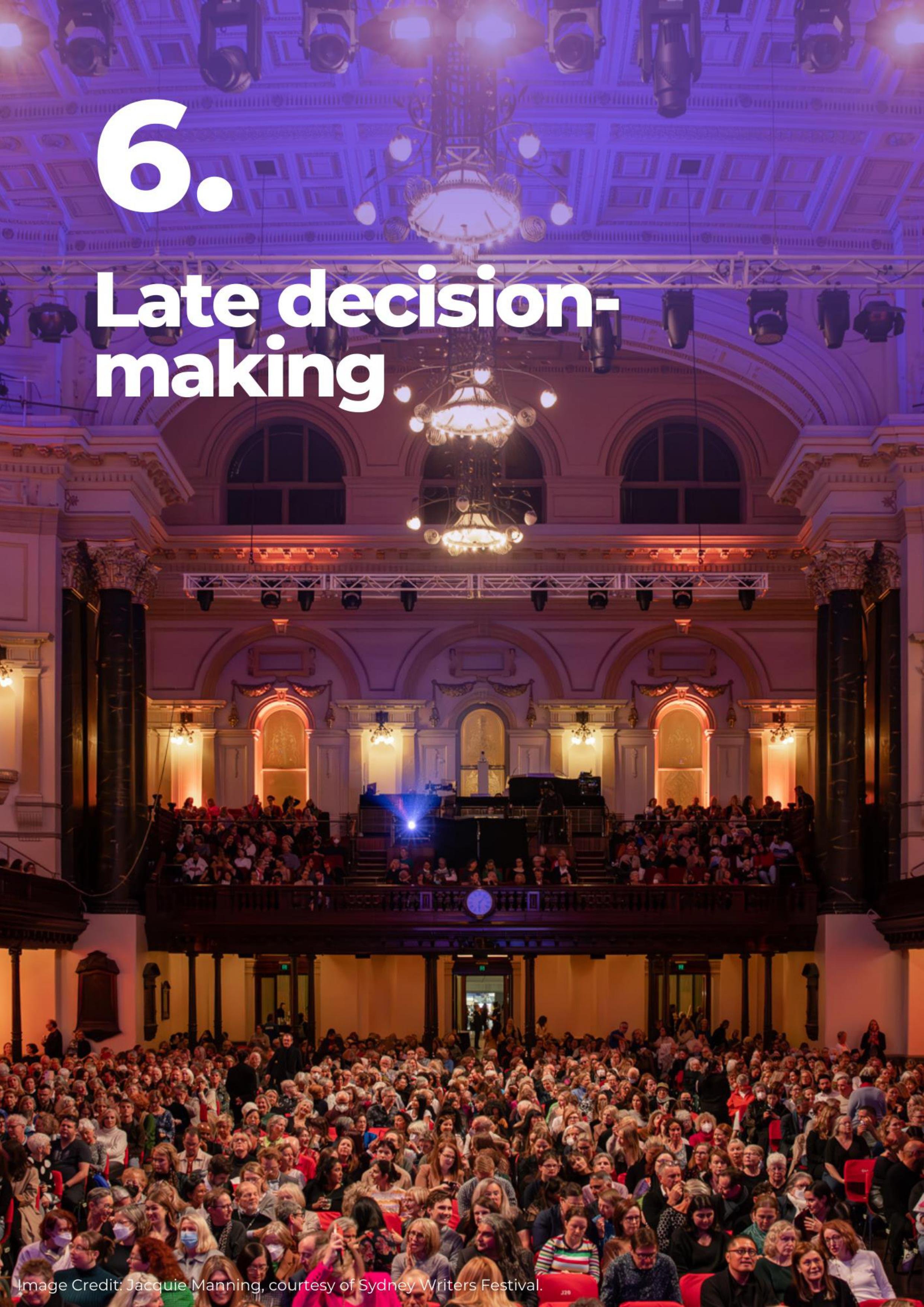
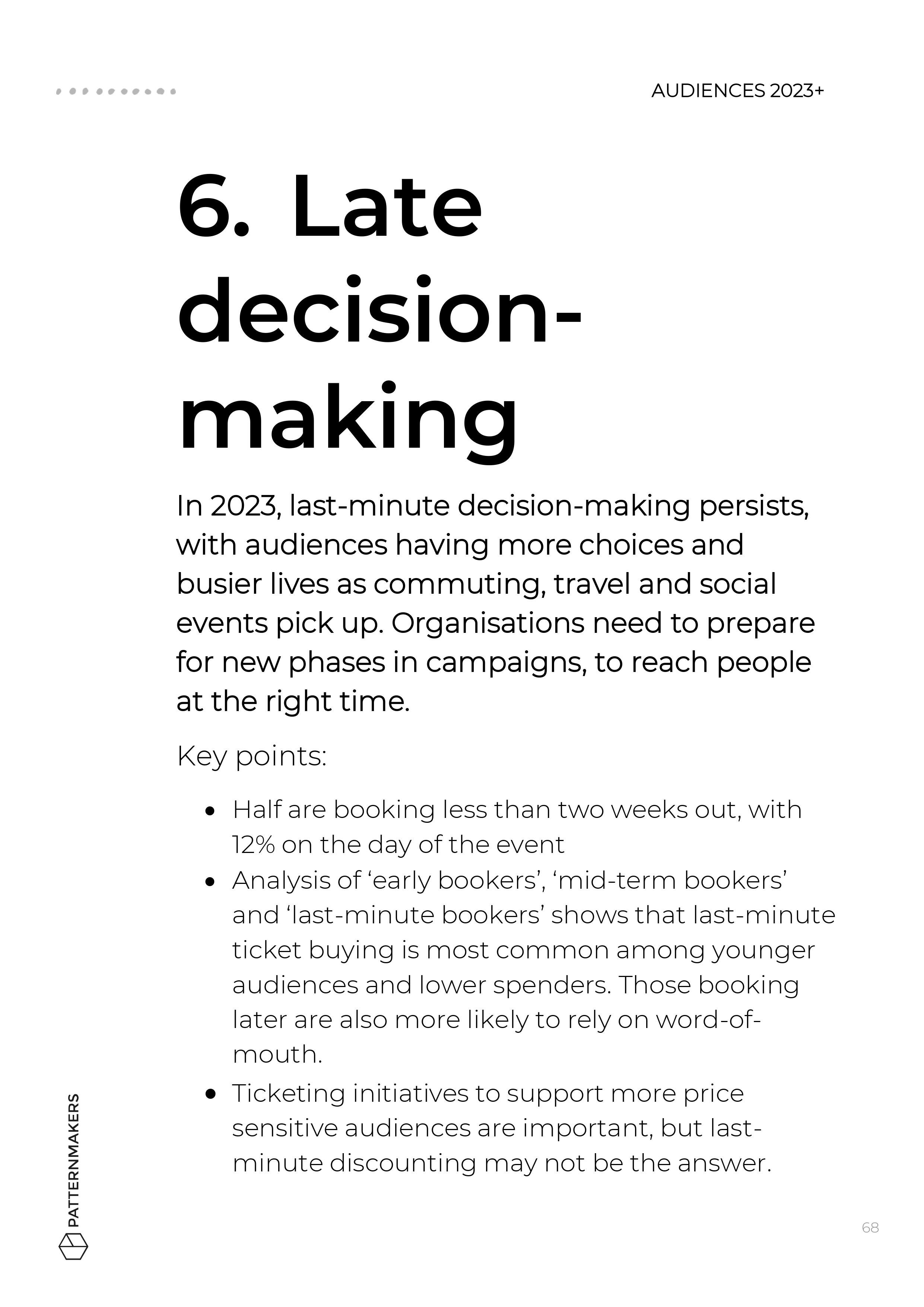
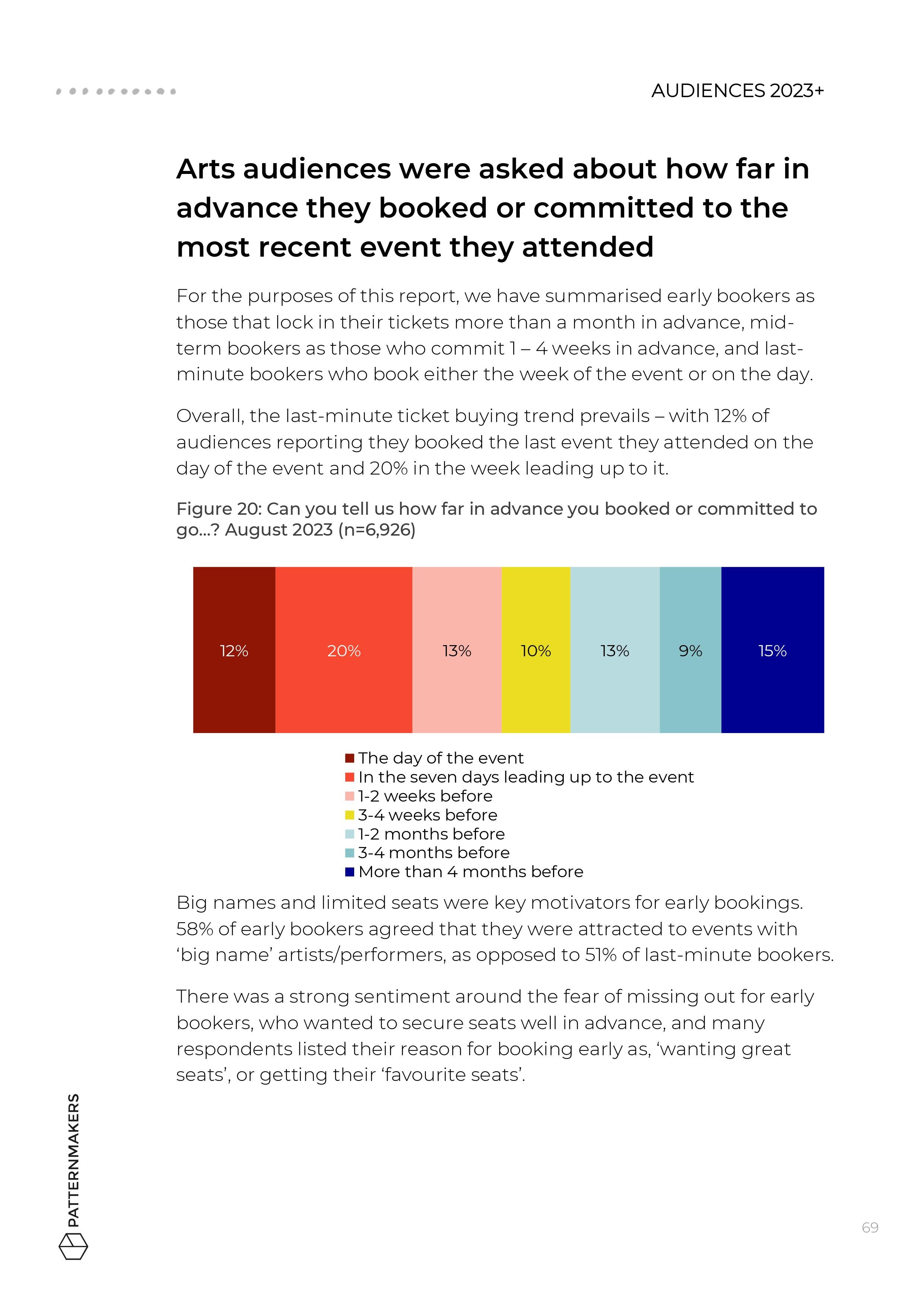
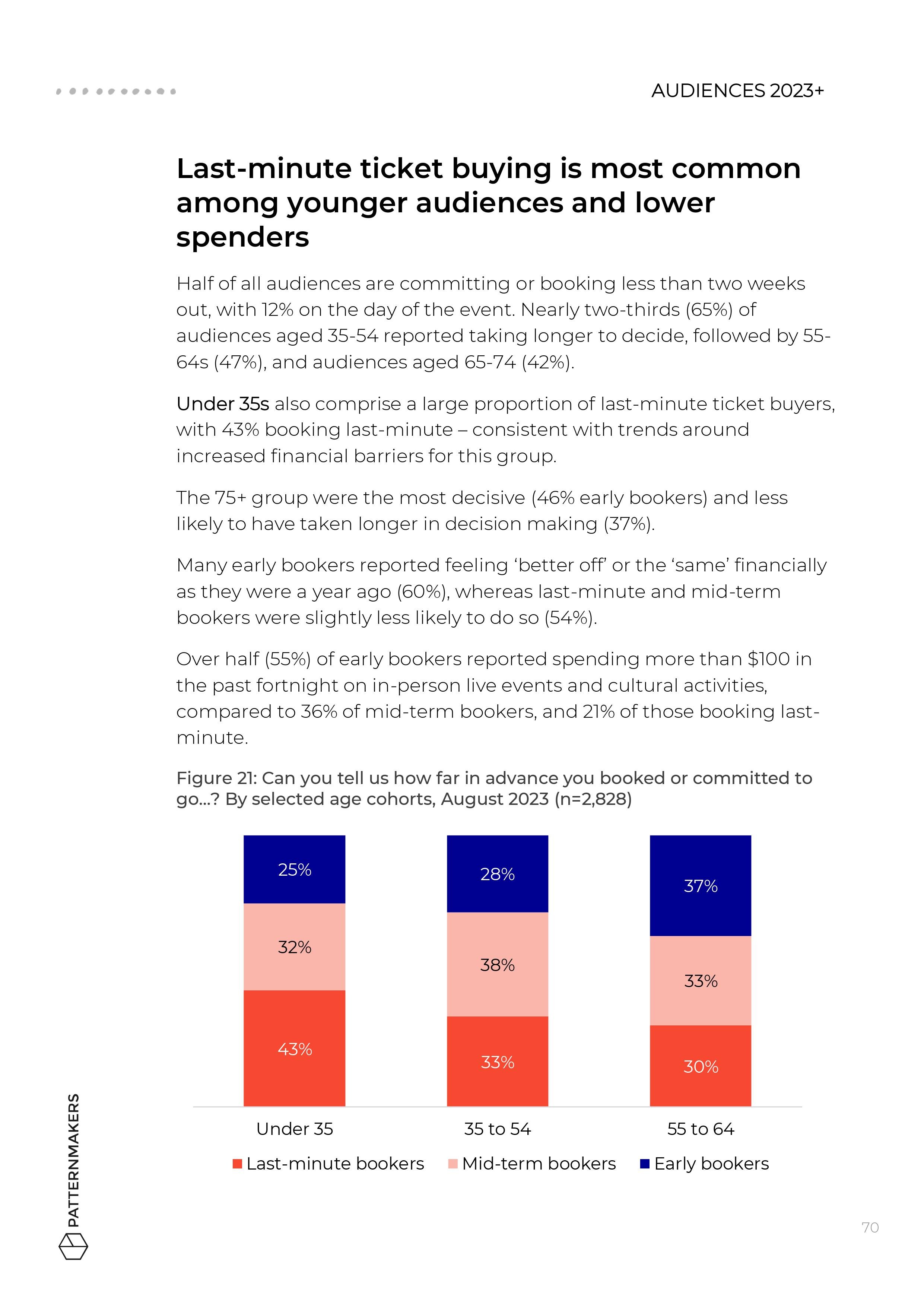
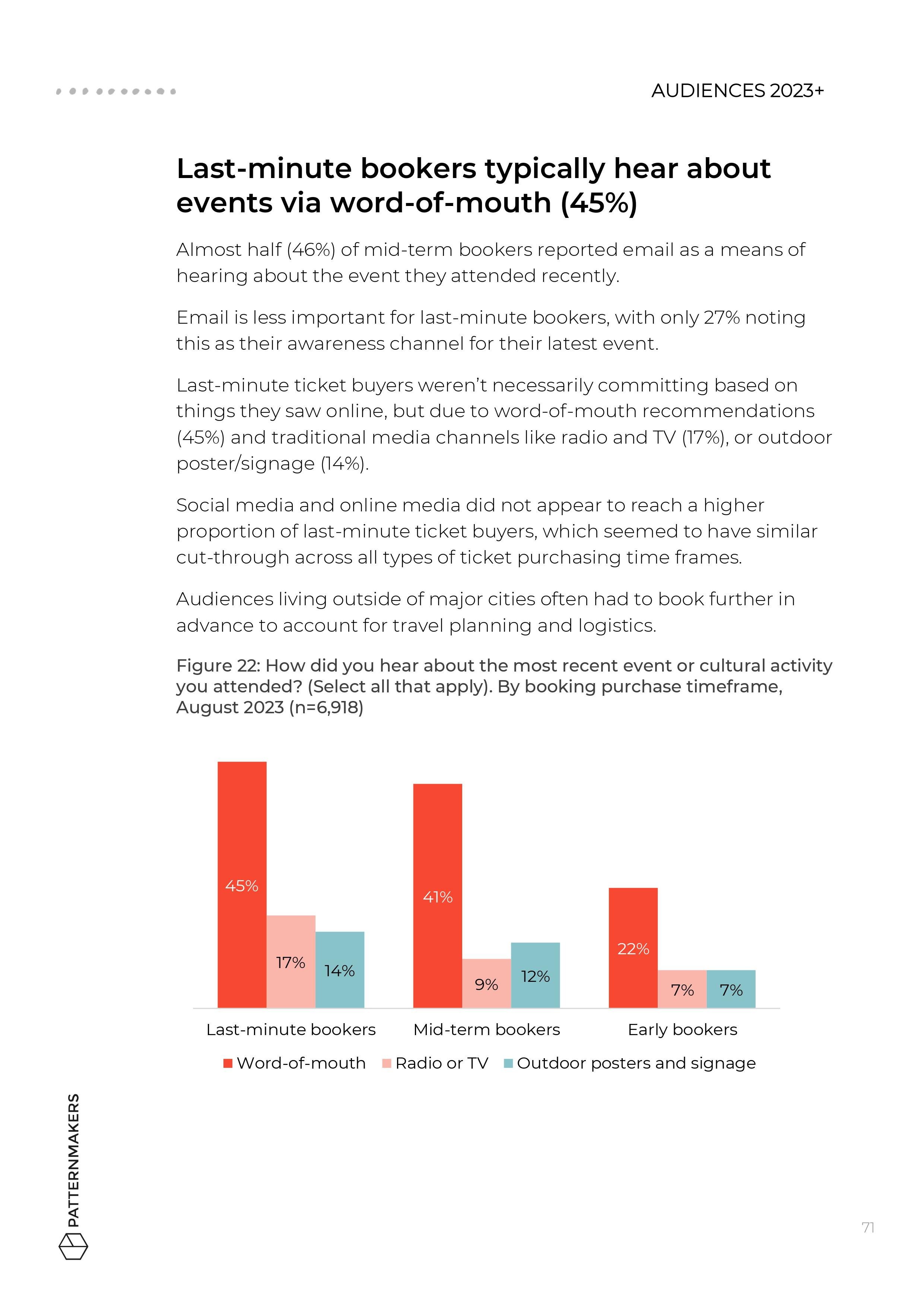
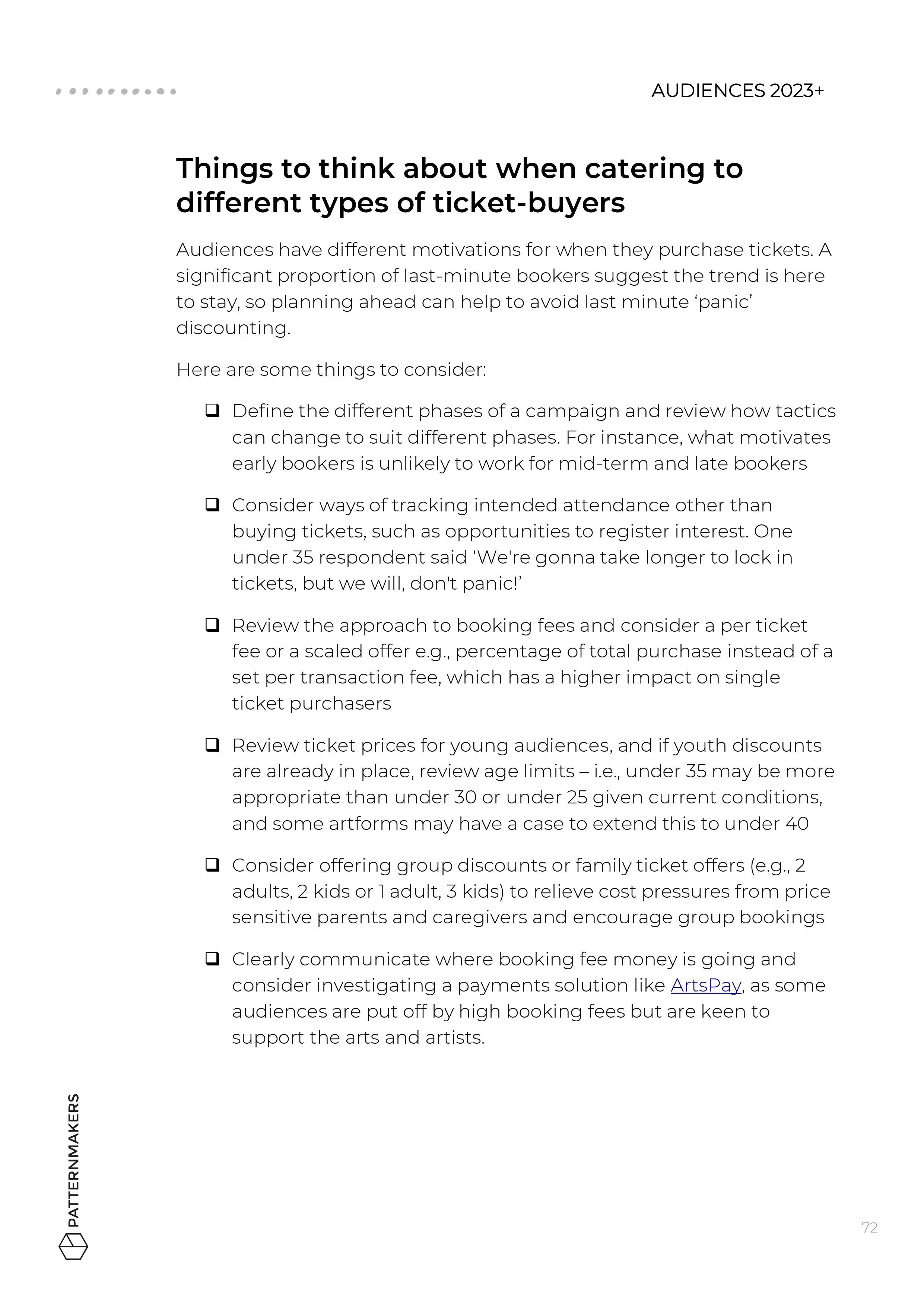
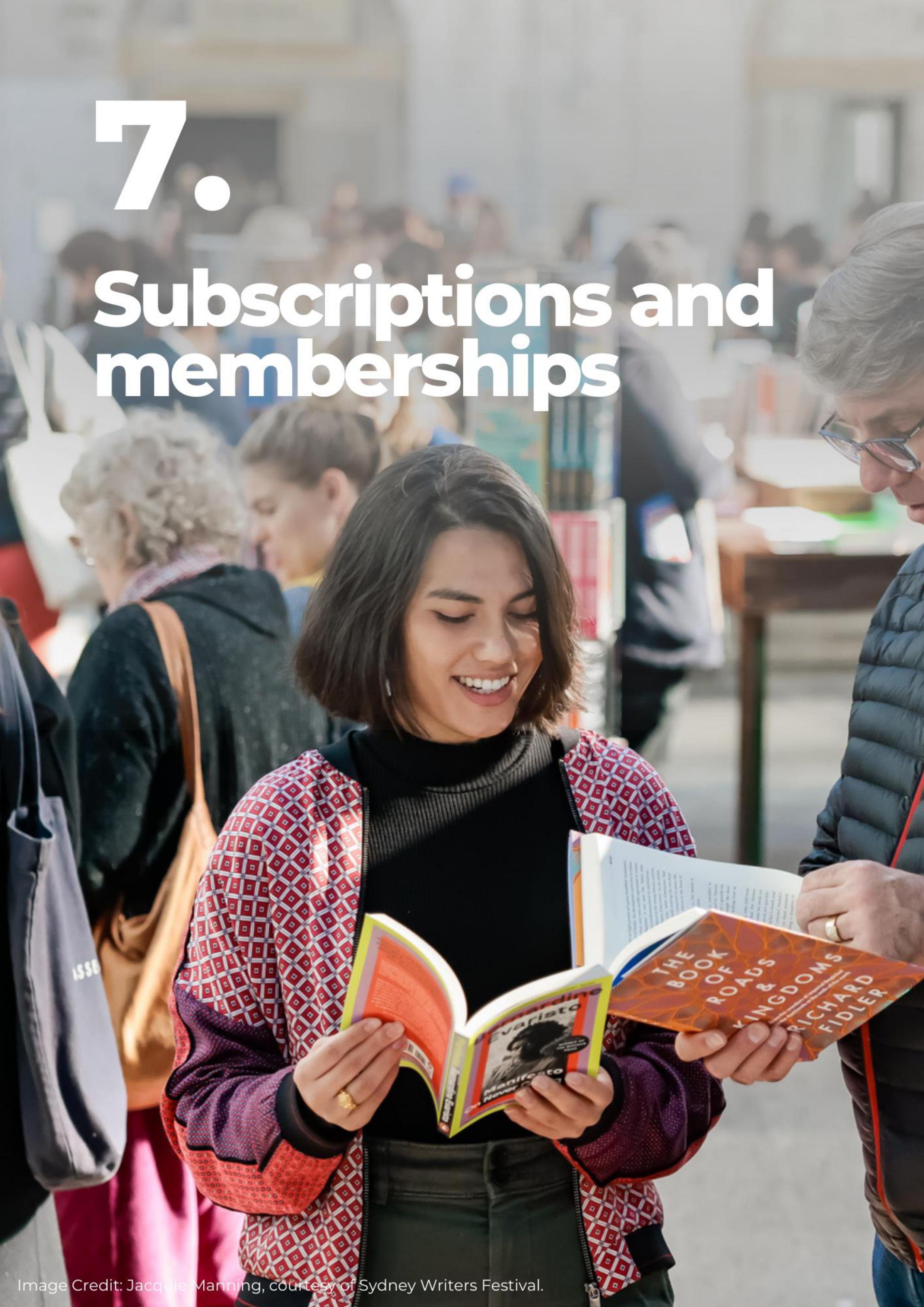
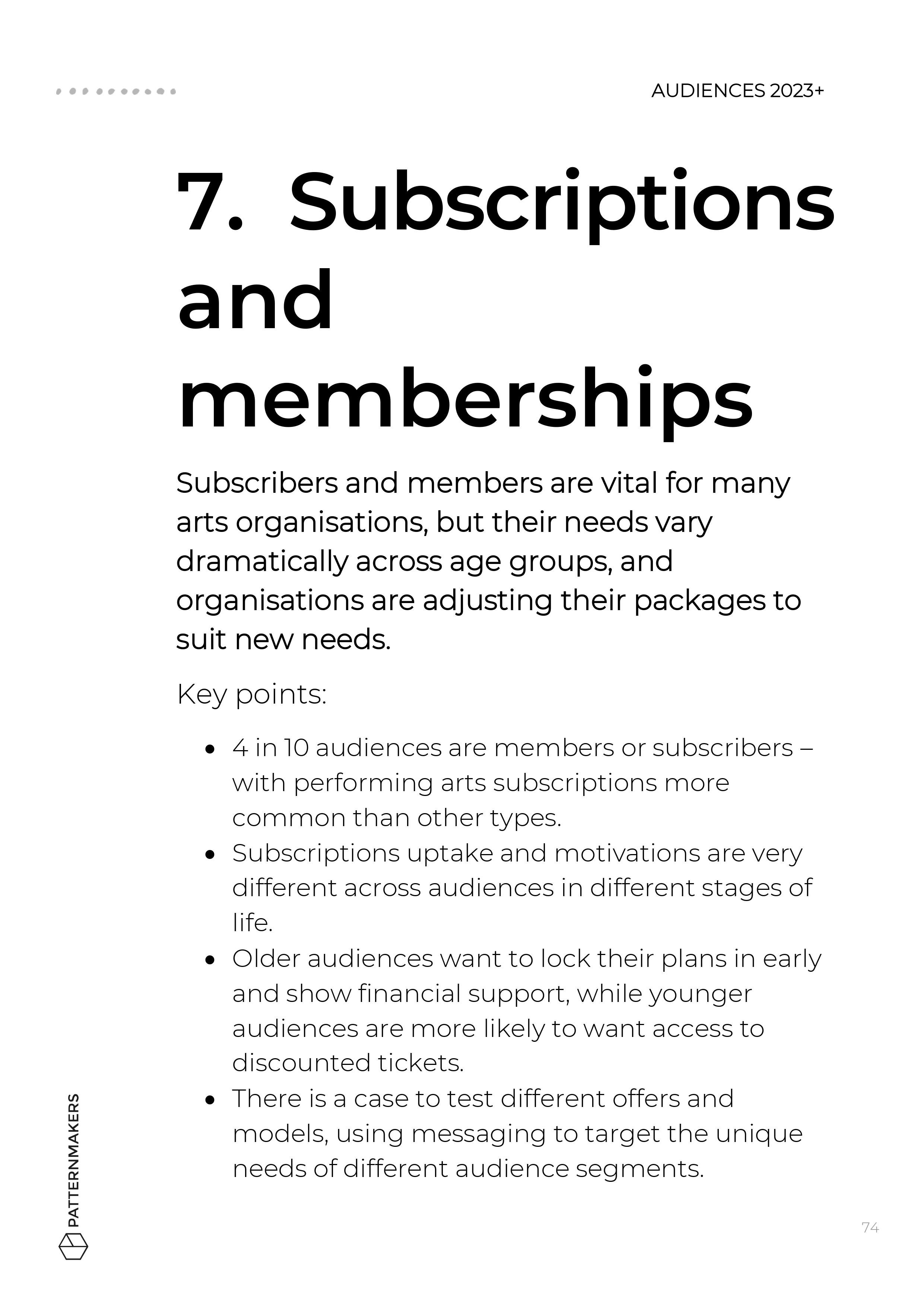
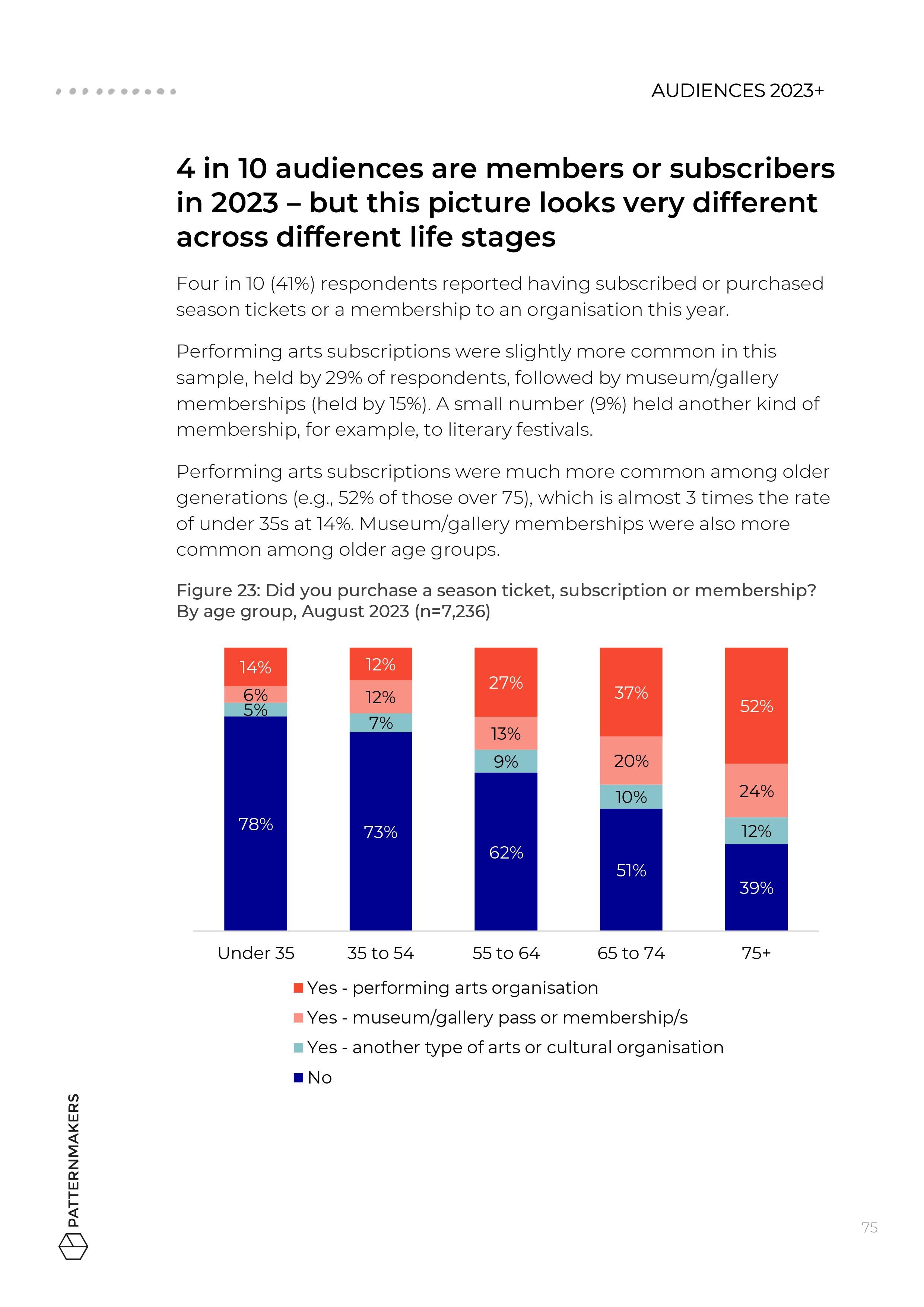

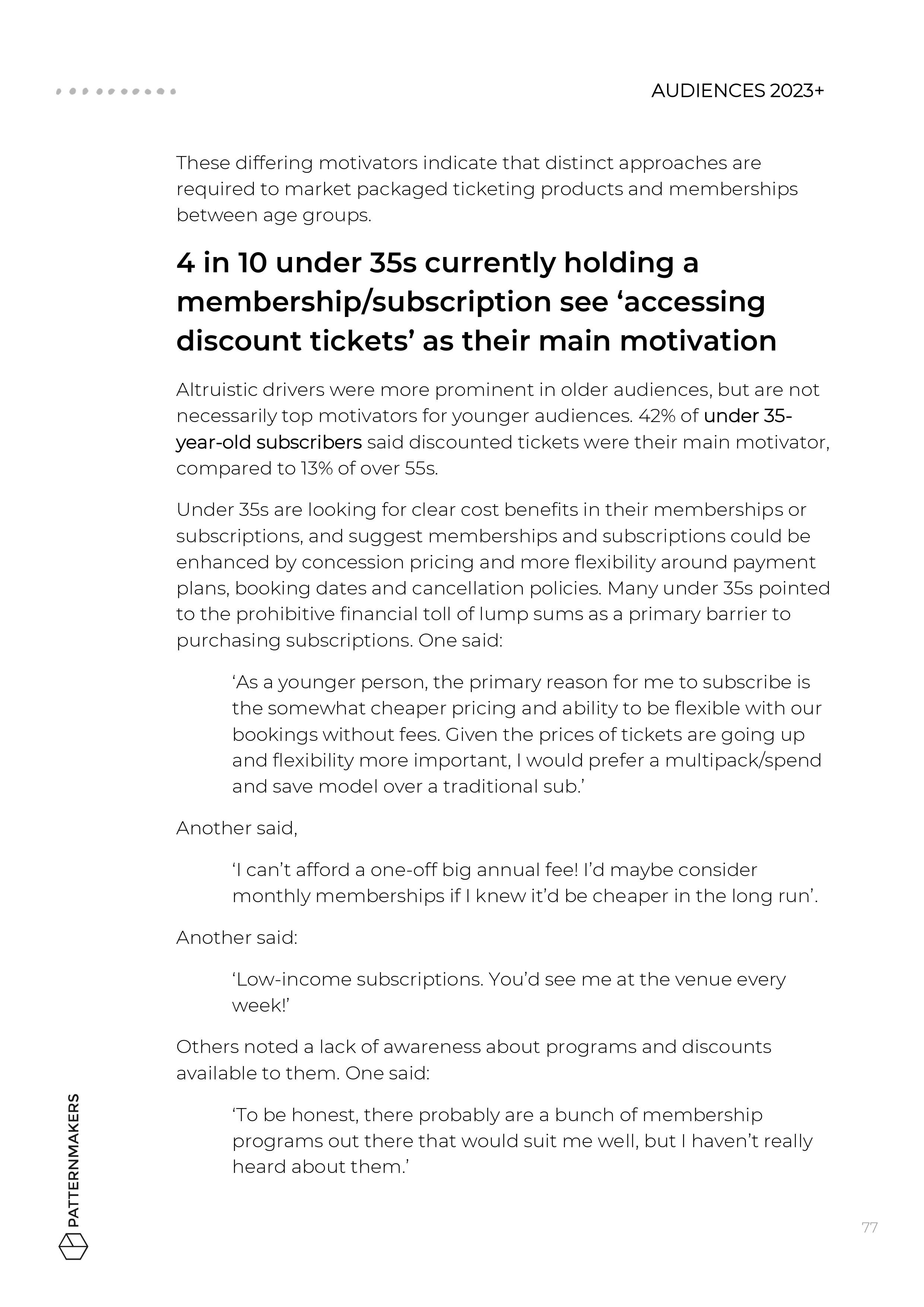
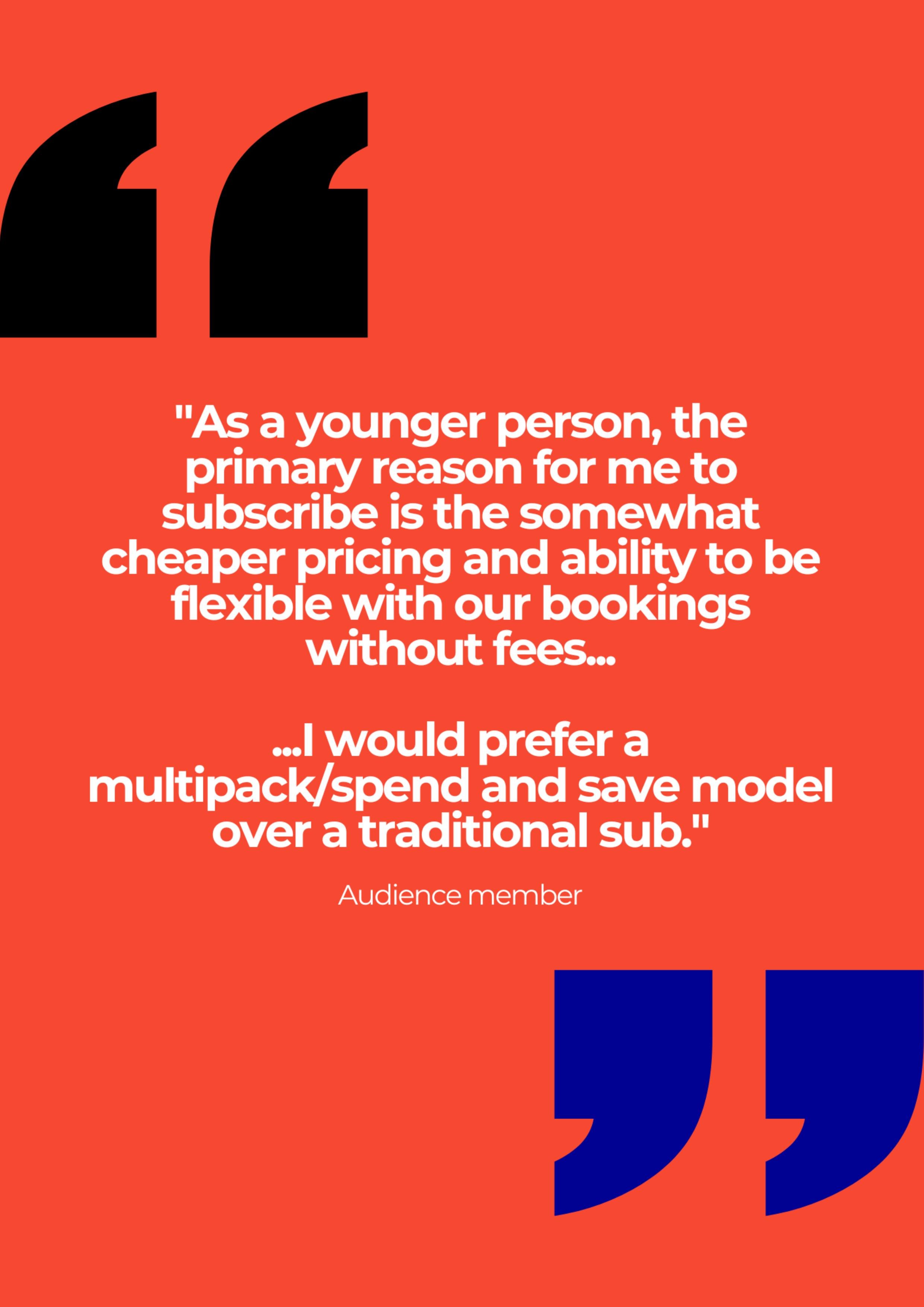
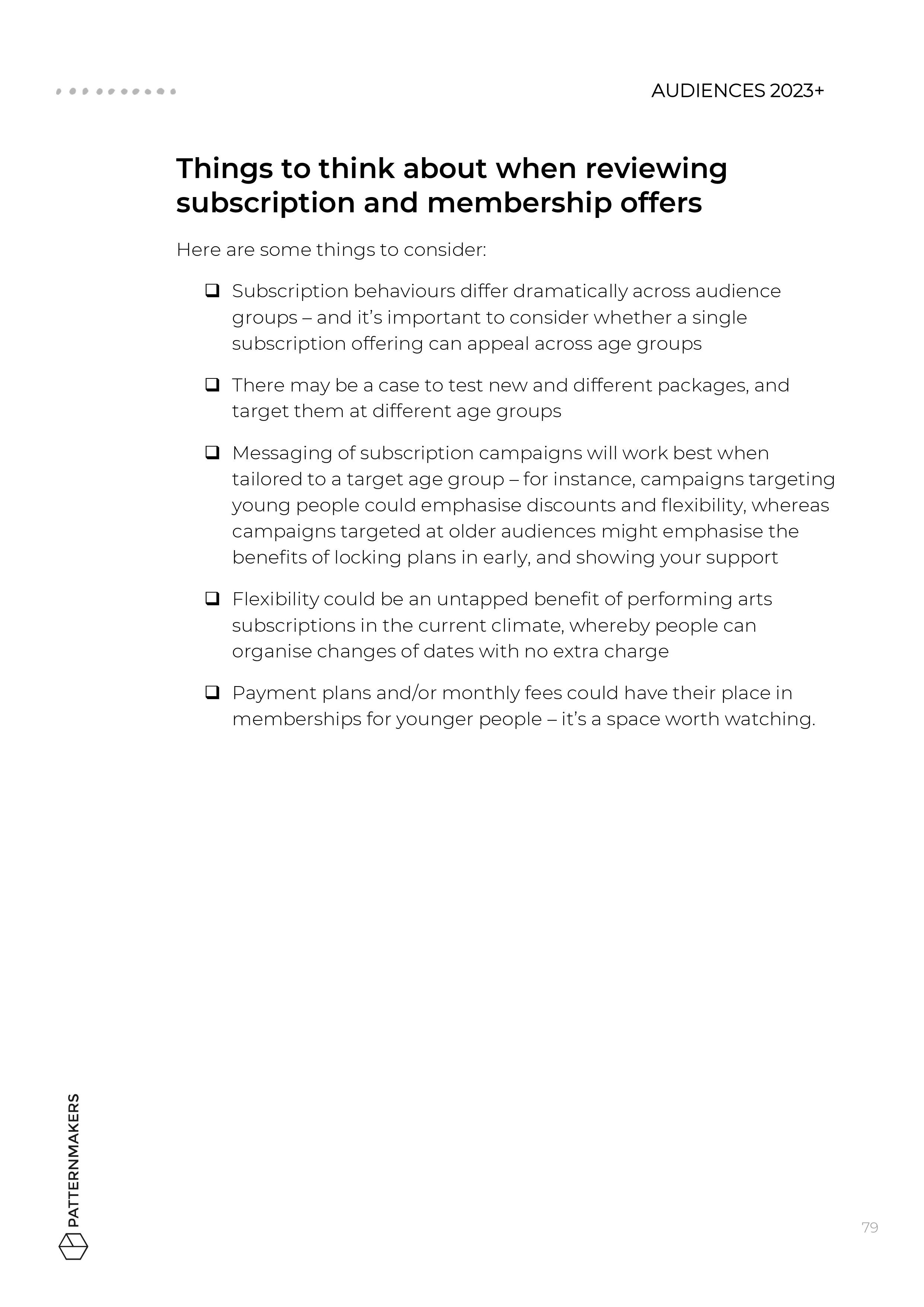

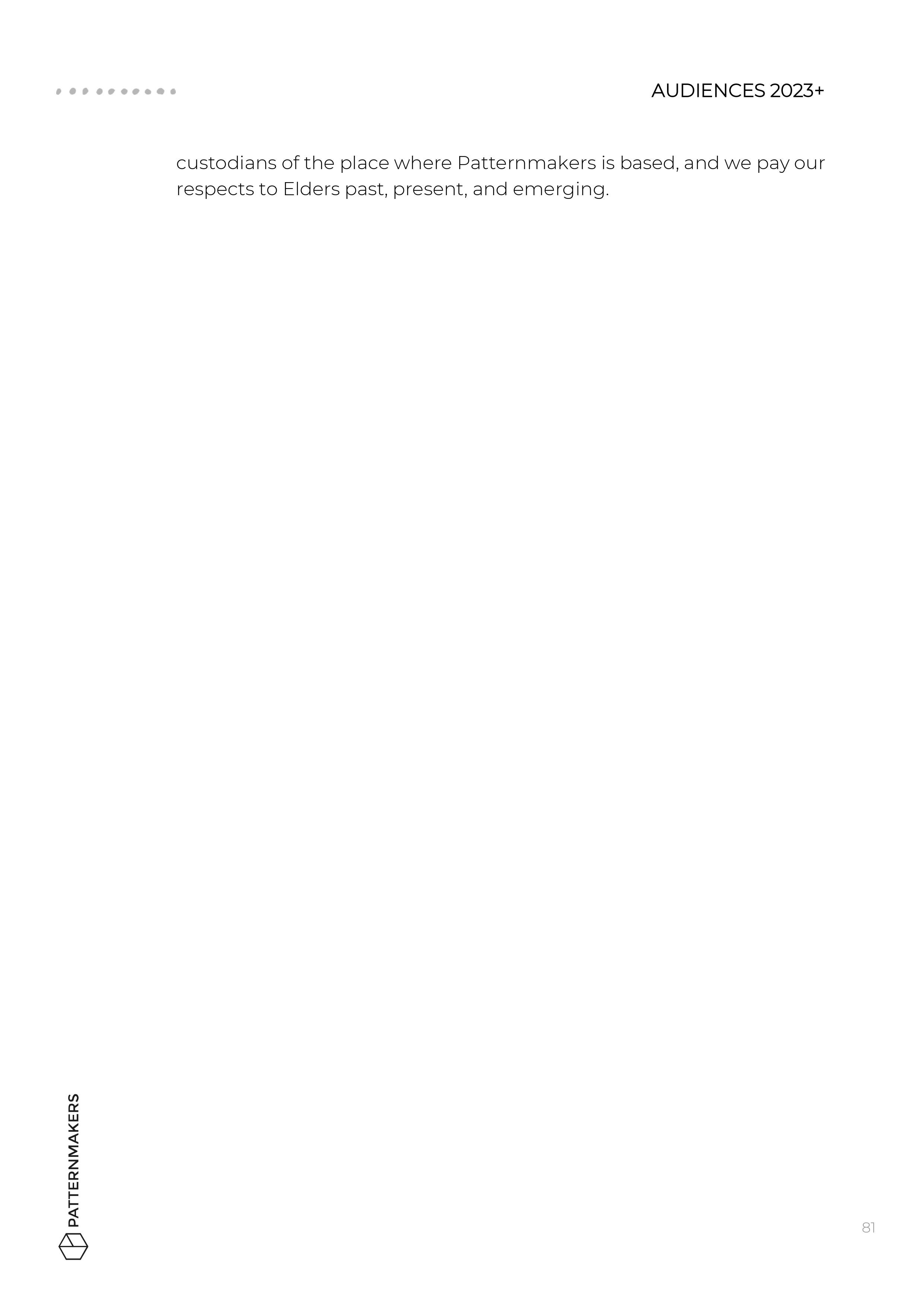
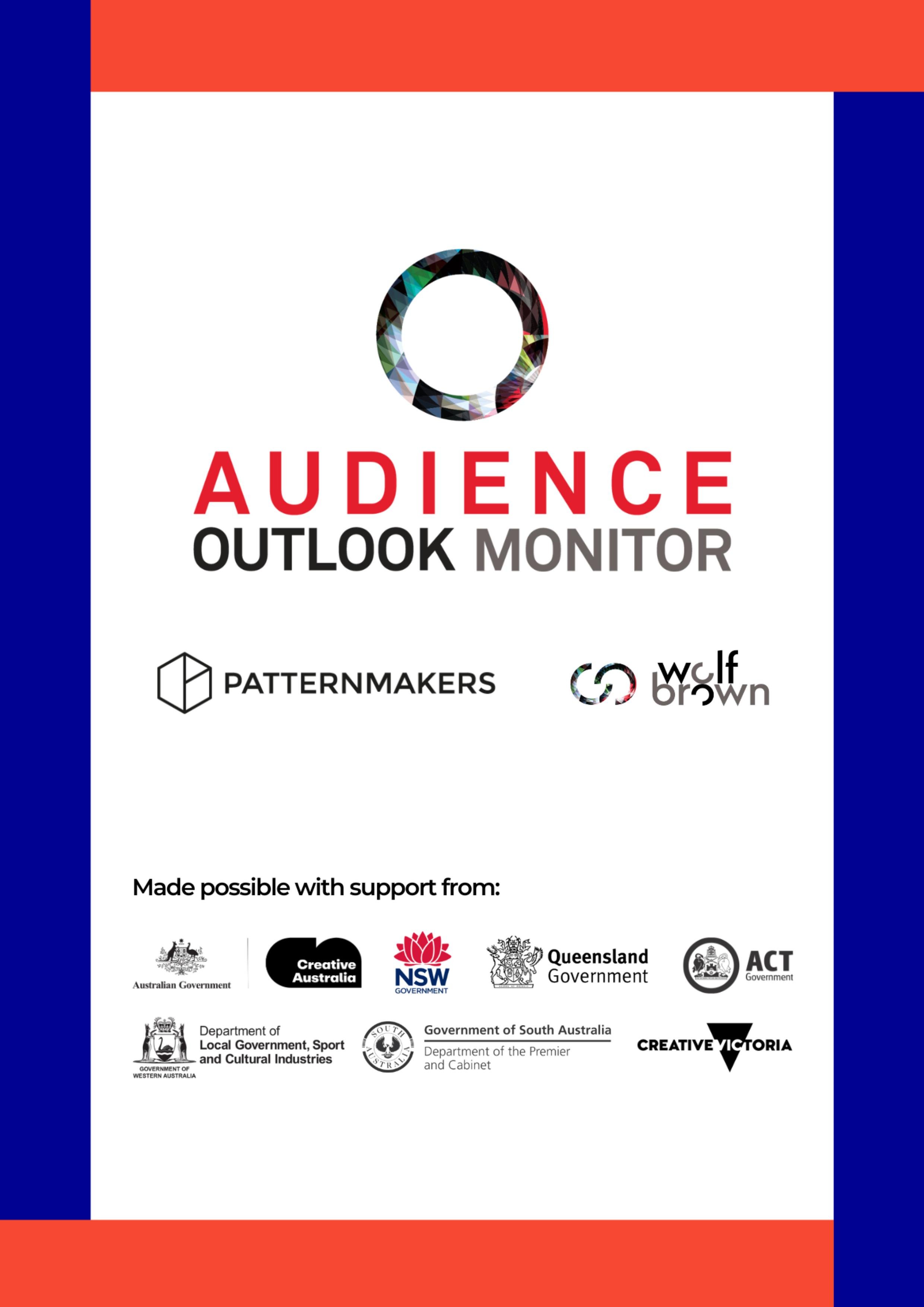
2. Inflationary pressures and pricing
Economic conditions are limiting what Australian audiences can spend on events, and some segments need targeted thinking to ensure access to arts and culture.
-
Financial reasons are the top barrier to attendance, and inflationary pressures are expected to continue in 2023 and 2024.
Spending levels at arts and culture events are not growing, as audiences weigh up value for money and take longer to make decisions.
Younger audiences and families continue to be the most impacted.
A key opportunity is developing sustainable strategies for targeting disadvantaged segments.
3. The desire to inspire
In the wake of the pandemic, audiences are in the mood for uplifting experiences — requiring event organisers to think strategically about creating meaning and building trust in difficult times.
-
Australian audiences are showing significant appetite for a wide range of content, though budget pressures are leading some audiences towards ‘safer’ bets or ‘guaranteed fun’.
Social, uplifting experiences and events with great reviews will continue to reach the widest audience in the coming year.
Many audiences are hungry for meaning, but care and tact may be needed to when approaching challenging topics.
Organisations that understand the mood can please crowds today while building trust for tomorrow.
“The arts are so important to keeping my spirits up and my mental health well.
It’s really challenging when you can’t afford to go to an event every now and again that you know will keep you well.”
4. Three segments to know
Younger audiences, families and older audiences are thinking and behaving very differently in 2023, and organisations must build capacity for new ways of working.
-
Social and economic pressures impact different generations in different ways, and this is reflected in three key audience segments.
Young people, families and older audiences show stark differences in mood, entertainment priorities, spending patterns and media consumption.
Organisations must consider how to create and execute strategies for different segments and build in flexibility to adapt as conditions evolve.
For easy viewing, click below to download the summary of all three key segments.
5. Online trends
Audiences continue engaging online in large numbers, and in 2023, online content is helping audiences find out about events, discover new artists and participate in digital experiences.
-
Digital channels are paramount to audience engagement – with 75% of recent attendees finding out about arts and culture events online.
Preferred platforms look very different across age groups: email marketing is the priority for 55+, while word-of-mouth and socials are key for under 35s.
4 in 10 audiences continue to engage in online arts and culture, and half say digital cultural activities still play a role in their lives, despite spending less.
It might be time to review online offerings, scrapping what's not working and freeing up resources for more targeted approaches.
“Australian arts audiences are intelligent and open to be challenged...
...This is essential for the future health and development of arts in this country.”
6. Late decision-making
In 2023, last-minute decision making persists, with audiences facing more choices, and busier lives, as commuting, travel and social events pick up. Organisations need to prepare for new phases in campaigns, to reach people at the right time.
-
Half are booking less than two weeks out, with 12% on the day of the event
Analysis of ‘early bookers’, ‘mid-term bookers’ and ‘last-minute bookers’ shows that last-minute ticket buying is most common among younger audiences and lower spenders. Those booking later are also more likely to rely on word-of- mouth.
Ticketing initiatives to support more price sensitive audiences are important, but last- minute discounting may not be the answer.
7. Subscriptions and memberships
Subscribers and members are vital for many arts organisations, but their needs vary dramatically across age groups, and organisations are adjusting their packages to suit new needs.
-
4 in 10 audiences are members or subscribers– with performing arts subscriptions more common than other types.
Subscriptions uptake and motivations are very different across audiences in different stages of life.
Older audiences want to lock their plans in early and show financial support, while younger audiences are more likely to want access to discounted tickets.
There is a case to test different offers and models, using messaging to target the unique needs of different audience segments.
Cover Image Credit: Jacquie Manning, courtesy of Sydney Writers Festival.
Watch us launch the findings at APAX 2023
Our Managing Director, Tandi Palmer Williams, and Research Analyst, Peta Petrakis, travelled to Cairns to present the data from Audiences 2023+ at APAX 2023, PAC Australia’s annual conference.
Click the image below to watch the recording of the livestream. Simply register to make a free account and press play!
Use the dashboard to get results for your artform and region
Survey data from over 8,800 respondents has been uploaded to the dashboard, which now contains insights from over 100,000 Australian participants.
You can use the dashboard to explore the findings by state/territory, artform and audience segment.
It’s freely available to access, just click the image below and use the login details provided on the dashboard page.
About the Audience Outlook Monitor
The Audience Outlook Monitor provides the results of a study that has tracked audience sentiment over the course of the COVID-19 pandemic.
Data was collected in six phases throughout 2020-2022 and is again being tracked in 2023.
Government agencies across Australia are collaborating with research agencies Patternmakers (Sydney) and WolfBrown (USA) to produce this resource. The dashboard is freely accessible and designed to help artists and cultural organisations of all kinds to make the best possible decisions.
How to find out more
To receive new releases directly into your inbox, as soon as they are available, you can opt in to receive Audience Outlook Monitor news below.
Subscribers to our regular Culture Insight & Innovation Updates will need to update their preferences to receive all updates about the Audience Outlook Monitor. Just enter your email below and follow the instructions provided.
If you have a question, or an idea for using this data, please contact Patternmakers at info@thepatternmakers.com.au
Delivery partners
Supporting partners
Past posts on this blog
Archive
- 2023 21
- Dance 3
- Research 99
- Audience development 79
- Arts 73
- COVID-19 70
- Culture 72
- Data culture 69
- Evaluation 75
- Innovation 78
- Thought leadership 16
- About Patternmakers 35
- Privacy 6
- Project updates 25
- Culture Panel 1
- Resources 6
- Toolkit 5
- Beyond the Bio 8
- 2022 23
- Career Advice 9
- Opportunities 4
- Tips & Tricks 13
- 2021 7
- 2024 1
- First Nations 3
- Indigenous 2
- Strategic Planning 5
- Trends 3
- Performing Arts 5
- Manifesto 1
- Education 2
- Capacity building 3
- Digital art 4
- Interviews 3
- Coronavirus 2
- 2020 3
- Tandi Palmer Williams 7
- Theory of Creativity Podcast 1
- 2019 11
- Top 5 2
- 2018 12
- Case Studies 2
- Our services 4
- Postcode Analysis 1
- Accessibility 4
- Touring 3
- Publications 1
- 2017 8
- Data art 2
- 2016 5
Use the dashboard
Data is available to explore in a dynamic dashboard, which can be filtered by artform and region.
The dashboard is publicly available, click more to find out how to login.
Use the dashboard to see how audiences feel about attending events in your artform and region
Survey data from over 100,000 Australian respondents has been aggregated in a freely available dashboard, to assist artists and cultural organisations of all kinds to understand how audiences feel about attending events again. You can access the dashboard at anytime - click the button below to get started in the dashboard.
Enter the following login details:
User: access@AOM.com.au
Password: Australia
Watch the tour
In the video below, you’ll hear about the data that’s available in the dashboard, how to navigate it and how to apply filters to see the results most relevant to you.
Download the guide
You can also download a short written guide for using the dashboard.
More about the data
Each Phase, data is collected in a cross-sector collaborative survey process involving 130 arts and culture organisations, including museums, galleries, performing arts organisations and festivals.
These organisations simultaneously send a survey to a random sample of audience members who had attended a cultural event since January 2018. Read more about the methodology and the types of events that are included.
By aggregating the data from over 120 participating organisations, this study provides a detailed resource with insights about all different artforms, types of events and demographic groups in all parts of Australia. No individual respondents or organisations are identified.
Join the conversation
Share your insights and reflections on social media using the hashtag #audienceoutlookmonitor
For questions, contact the researchers directly at info@thepatternmakers.com.au
Subscribe for updates
Periodically we publish new factsheets and snapshot reports. To hear of future announcements about the study, subscribe by entering your email address below.
About the Author
Tandi Palmer Williams
Managing Director
Tandi is Founder and Managing Director of Patternmakers. She’s an arts research specialist and leader of the agency’s research projects.
Delivery partners
Supporting partners
Past posts on this blog
Archive
- 2023 21
- Dance 3
- Research 99
- Audience development 79
- Arts 73
- COVID-19 70
- Culture 72
- Data culture 69
- Evaluation 75
- Innovation 78
- Thought leadership 16
- About Patternmakers 35
- Privacy 6
- Project updates 25
- Culture Panel 1
- Resources 6
- Toolkit 5
- Beyond the Bio 8
- 2022 23
- Career Advice 9
- Opportunities 4
- Tips & Tricks 13
- 2021 7
- 2024 1
- First Nations 3
- Indigenous 2
- Strategic Planning 5
- Trends 3
- Performing Arts 5
- Manifesto 1
- Education 2
- Capacity building 3
- Digital art 4
- Interviews 3
- Coronavirus 2
- 2020 3
- Tandi Palmer Williams 7
- Theory of Creativity Podcast 1
- 2019 11
- Top 5 2
- 2018 12
- Case Studies 2
- Our services 4
- Postcode Analysis 1
- Accessibility 4
- Touring 3
- Publications 1
- 2017 8
- Data art 2
- 2016 5
State Snapshots on cost-of-living pressures
Download the April 2023 State Snapshot reports to see how inflationary pressures are being experienced differently across the country.
Read our snapshot reports to discover the nuances in audience behaviour at a state-level.
Based on data from the April 2023 Audience Outlook Monitor, find out how audiences across Australia’s states are responding to increasing interest rates and cost-of-living pressures.
While audiences in New South Wales are spoiled for choice right now – almost half are taking longer to make decisions about attending, and they’re taking into account 3 key factors more than usual.
Victorian and South Australian audiences are the most likely to be staying closer to home to keep costs down. There are certain offers marketers need to be aware of.
Things appear most stable in Queensland and Western Australia, with these audiences feeling the most optimistic about the country’s economic outlook. However, half are looking for cheap/free things to do currently, validating the need for certain ticketing initiatives.
Scroll down to access the snapshot reports for key states, VIC, QLD, NSW and SA. Keep an eye out for news about the WA snapshot in the coming weeks.
Download the snapshots
Click the buttons below to access the snapshots for each state.
The state snapshots are also available to download in an accessible version:
Thank you to the following state arts agencies for their support in delivering the State Snapshots: Creative Victoria, Create NSW, Arts Queensland, Department of the Premier and Cabinet (Arts SA) and Department of Local Government, Sport and Cultural Industries (WA).
Cover Image Credit: Concert for the Planet, courtesy of HOTA.
Read the National Snapshot Report
In case you missed it, click the button below for the key national insights from the April 2023 Pulse Check.
Use the dashboard to get results for your artform and region
Survey data from over 1,300 respondents has been uploaded to the dashboard, which now contains insights from 100,000 Australian participants.
You can use the dashboard to explore the findings by state, artform and audience segment.
It’s freely available to access, just click the image below and use the login details provided on the dashboard page.
About the Audience Outlook Monitor
The Audience Outlook Monitor provides the results of a study that has tracked audience sentiment over the course of the COVID-19 pandemic.
Data was collected in six phases throughout 2020-2022 and is again being tracked in 2023.
Government agencies across Australia are collaborating with research agencies Patternmakers (Sydney) and WolfBrown (USA) to produce this resource. The dashboard is freely accessible and designed to help artists and cultural organisations of all kinds to make the best possible decisions.
How to find out more
To receive new releases directly into your inbox, as soon as they are available, you can opt in to receive Audience Outlook Monitor news below.
Subscribers to our regular Culture Insight & Innovation Updates will need to update their preferences to receive all updates about the Audience Outlook Monitor. Just enter your email below and follow the instructions provided.
If you have a question, or an idea for using this data, please contact Patternmakers at info@thepatternmakers.com.au
Subscribe for updates
About the Author
Bianca Mulet
Senior Research Analyst
Delivery partners:
Supporting partners:
Past posts on this blog
Archive
- 2023 21
- Dance 3
- Research 99
- Audience development 79
- Arts 73
- COVID-19 70
- Culture 72
- Data culture 69
- Evaluation 75
- Innovation 78
- Thought leadership 16
- About Patternmakers 35
- Privacy 6
- Project updates 25
- Culture Panel 1
- Resources 6
- Toolkit 5
- Beyond the Bio 8
- 2022 23
- Career Advice 9
- Opportunities 4
- Tips & Tricks 13
- 2021 7
- 2024 1
- First Nations 3
- Indigenous 2
- Strategic Planning 5
- Trends 3
- Performing Arts 5
- Manifesto 1
- Education 2
- Capacity building 3
- Digital art 4
- Interviews 3
- Coronavirus 2
- 2020 3
- Tandi Palmer Williams 7
- Theory of Creativity Podcast 1
- 2019 11
- Top 5 2
- 2018 12
- Case Studies 2
- Our services 4
- Postcode Analysis 1
- Accessibility 4
- Touring 3
- Publications 1
- 2017 8
- Data art 2
- 2016 5
How rising inflation is impacting audiences
April 2023 results from the Audience Outlook Monitor are now available. Get the details on how the attendance outlook varies across three key audience segments and the programming, marketing, and ticketing opportunities that exist to improve consumer confidence.
Read about the findings and download the Live Attendance Update.
Rising inflation has put pressure on household budgets, with audiences attending slightly fewer events and spending less
-
Increasing interest rates and cost-of-living pressures are impacting consumer confidence around the country. This ‘Pulse Check’ explores how Australian arts audiences are responding to changing economic conditions, based on data from 1,318 past attendees.
Around 4 in 10 (42%) audience members surveyed say they are ‘worse off’ financially compared to one year ago. 1 in 10 (7%) are ‘better off’ and 5 in 10 (51%) are ‘the same'.
Arts attendees appear to be faring slightly better than the general population, on average, but are more cautious about the country’s economic outlook, based on comparison of the results with the ANZ-Roy Morgan' Consumer Confidence index.
Trends vary across segments, confirming the need to tailor strategies for different audiences and events. Older audiences are the most likely to say their situation is the same (58%), while parents are the most likely to say they are ‘worse off’ (57%). Young audiences under 35 are most negative about the economic outlook.
While three-quarters of past attendees (76%) attended a cultural event in the fortnight before data collection (19-23 April), consistent with October (75%) and August 2022 (76%), the profile of those attending, and their attendance preferences are changing.
Average spending levels are decreasing, with 6 in 10 (59%) of those attending in the past fortnight spending over $50 or more, down slightly from August (63%) and October 2022 (63%). However, averages should be interpreted with caution, as some segments are actually spending more, and others less.
Read on or download the report for details on how different segments are behaving.
Click the buttons below to download the April 2023 Snapshot Report, as a PDF or the accessible Word version, or read on for more of the findings.

































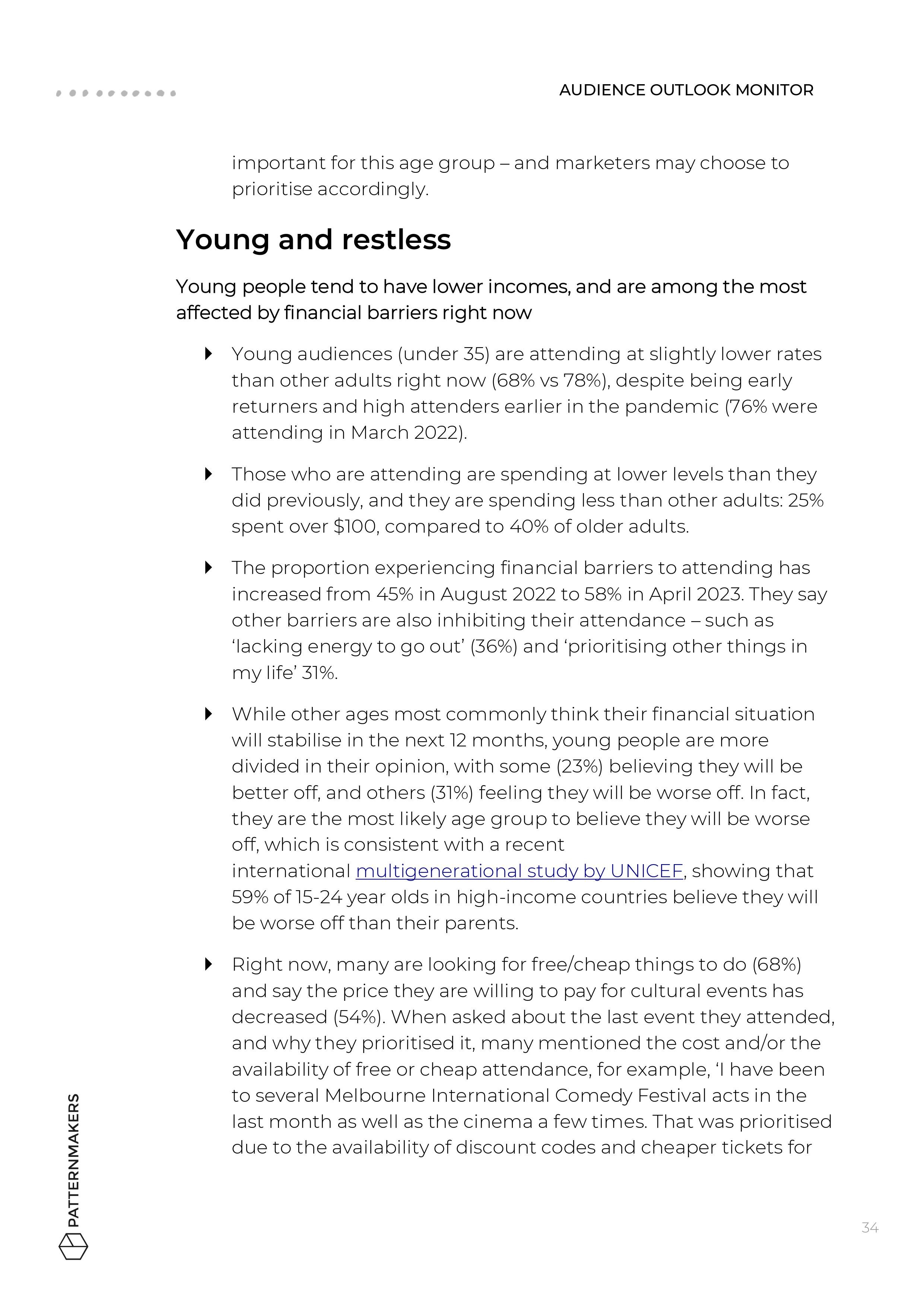



With financial limitations top of mind, many audiences are deliberating longer on factors such as price, location and overall value
-
As COVID-related concerns continue to fade, financial reasons are the top barrier to attendance, affecting 4 in 10 audience members.
A lack of money is not the only consideration – the data also suggests a perceived lack of time and a lack of energy, as lifestyles continue to evolve after the pandemic. Many report feeling busier with the return of office working, commuting, travel and social events – and 24% say they are inhibited by ‘prioritising other things’.
When asked about their cultural spending over the past 6 months, sizeable numbers say the price they are willing to pay to attend (35%) and/or their frequency of attendance (48%) have decreased.
When reflecting on the most recent event they attended, 4 in 10 audiences said that price influenced them ‘more than usual’ (39%).
Around half are looking for free and cheap things to attend (54%) and qualitative data shows that discounts and pricing offers are factoring into a high number of decisions, particulary among families and young people.
People from different socio-economic backgrounds are ‘splurging’ and ‘saving’ to different degrees – and some are doing both, opting to splash out on events that are important to them, while making savings elsewhere by looking for free or low-cost alternatives.
Audiences say they have decreased spending on events (50%), donations (36%) and subscriptions/memberships (31%) – though many who engage in these forms of support say they plan to continue, acknowledging tough conditions for artists and a desire to show their support in tough times.
The uncertain economic outlook requires tailored strategies for different segments and scenarios
-
Many are taking longer to make decisions (50%), and last-minute ticket-buying appears here to stay for the time being.
The location of events is also impacting 33% of audiences more than usual and 45% say they are staying closer to home. Qualitative data suggests that proximity to events plays an important role – with costs of parking, fuel, air tickets and hospitality all increasing.
Some segments are more disadvantaged by travel costs than others, and logistical considerations in scheduling events will be important for catering to a range of audiences.
When asked about the next 12 months, audience responses confirm enduring appetites for new (53%), uplifting (68%) and challenging arts experiences (42%). Balanced programs are as important as ever.
When asked to share what they’ve attended recently, and why they prioritised those things, some common themes include a desire to support artists and organisations they value and wanting to return to the works they know and love. Some appear to want a ‘safe bet’ that they will have an enjoyable experience with friends/family.
Economic conditions are complex, and affect every household differently. However, looking at the trends in three key segments can assist with understanding some of the differences and identifying practical implications (overleaf).
With an uncertain outlook, and the possibility of a recession, it’s wise to stay flexible and consider how strategies and tactics can be adjusted as conditions change.




Summary of segments
Inflationary pressures are experienced differently across the population. Three key audience segments are presented below.
-
Arts audiences aged 55+
After several years shaped by virus concerns and mask-wearing, older audiences are now enjoying higher attendance levels and spending.
As the most likely audiences to experience no barriers to attending right now, this group is open to a range of experiences and are the most likely to seek out challenging, topical works in the next 12 months.
Email is the top way they find out about events, so consider ways to continually improve your databases and eDMs.
-
Arts audiences aged 35-55 with children living at home
Rising housing costs are affecting families more than households without children, and audiences with children at home have reduced their cultural spending more than other adults.
High numbers are staying closer to home, looking for free/cheap things to do and taking longer to commit, as they weigh up costs for 3 or more people.
Families see the arts as important for their children – and many are prioritising it within their budget.
For Kids and Family shows, consider a pricing and promotion strategy tailored to this group (they’re the most likely group to find out about events on Facebook!).
-
Arts audiences under 35
Despite being eager to get out and about, young people are attending at slightly lower levels than they did 12 months ago and are spending less too.
They’re facing financial barriers at twice the rate of their parents’ generations – and feel more down about their economic future.
They’re eager to connect socially, attend fun/uplifting events and try new things they haven’t experienced before, but may need support to attend.
Some are looking with keen eyes for student or youth discounts – and ways to cover the costs of travel and eating out.

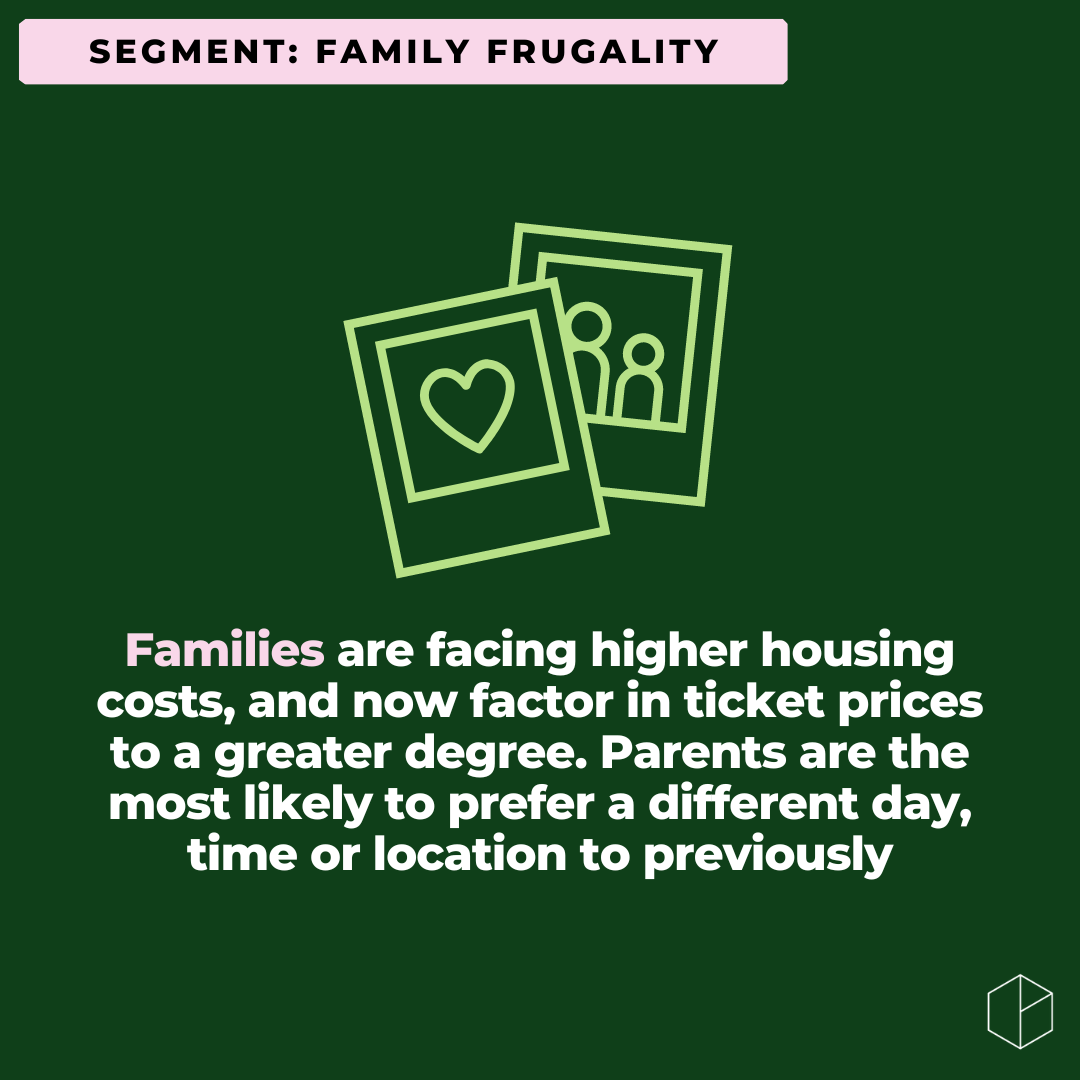

Opportunities
As conditions continue to change, opportunities exist in terms of programming, marketing and ticketing. However, the right solutions will look different for every organisation. The ideas outlined below are put forward to get you thinking, and any action should be considered in terms of what’s right for you and your audience.
Programs featuring diverse topics and different price points are likely to reach the broadest audiences.
-
Keep in mind audiences’ desire for fun, uplifting events in the post-pandemic era, but don’t forget there are sizeable numbers wanting new, topical and/or challenging things – some audiences have expressed wariness of commercialisation or softening of the cultural activities they love at the expense of creative innovation
Review the price points of your offerings and consider how audiences in different segments will assess value for money
Research the demographic shifts affecting your area and explore as a team how behaviours like working from home, commuting and travel are changing
Keep on top of transport options to your area, such as public transport schedules and initiatives, and consider these when scheduling events
Consider programming earlier event options/matinees to encourage attendance among cost-conscious parents or outer metro/regional audiences who might catch public transport or drive but want to avoid travel rush or late-night travel
Looking ahead, consider the right frequency and volume of events for the economic conditions. It might be helpful to plan for different scenarios such as a fast rebound or prolonged recession.
Clear and helpful marketing campaigns can help get indecisive audiences over the line.
-
Look at ways to take pressure off audiences by spelling out instructions on how to get to and from events, on your websites, newsletters or pre-event emails
Consider researching and promoting any money saving transport or parking initiatives, to encourage regional or outer metro attendance at inner city events, or metropolitan attendance at regional or outer metro events
Consider creating and promoting itineraries for a ‘night out’ based on different budgets e.g., suggested transport, pre-show drink destination and post-show dinner destination
Take time to get digital marketing right and wherever possible tailor the words, imagery and channel, based on things like prior attendance, post code, age, family status or income (sometimes reaching a smaller group with the right campaign will deliver better engagement than a broad campaign to a bigger group)
Where one event ticks various boxes, consider A/B marketing tactics to communicate the same event to different segments in different ways – for example, highlight the ‘challenging, topical’ content of a show in an email to over 55s, while featuring any ‘big name artists’ in an email to under 55s.
Ticketing initiatives to support more price sensitive audiences are important, but last-minute discounting may not be the answer. Also, with some arts audiences doing well financially and others struggling, it might be time to introduce alternative payment models.
-
Look at ways of rewarding early bookers with earlybird discounts or newsletter subscriber pre-sales, rather than resorting to last minute ‘panic’ discounting
Consider offering cheaper ticket prices for young audiences and reviewing age limits – i.e. under 35 may be more appropriate than under 30 or under 25 given current conditions, and some artforms may have a case to extend this to under 40
Consider offering group discounts or family ticket offers (e.g., 2 adults, 2 kids or 1 adult, 3 kids) to relieve cost pressures from price sensitive parents and caregivers, and encourage group bookings
Review the approach to booking fees and consider a per ticket fee or a scaled offer e.g. percentage of total purchase instead of a set per transaction fee, which has a higher impact on single ticket purchasers
Clearly communicate where booking fee money is going, and consider investigating a payments solution like ArtsPay, – some audiences are put off by high booking fees but many are keen to support the arts and artists
Investigate ways to facilitate ‘pay it forward’ tickets, where people in more comfortable financial positions can purchase or subsidise tickets for people more affected by cost of living pressure
If feasible, options to pay in instalments could take the pressure off audiences splashing out big purchases, and encourage more to book in advance
For lower cost events, consider a ‘pay what you want’ model with a small pre-purchase deposit to encourage more risktaking from audiences to see something new, topical or challenging, but avoiding risks around no-shows
Cover Image Credit: Audience at Future History Runway. Melbourne Fringe Festival 2022. Photo by Duncan Jacob, courtesy of Melbourne Fringe.
Want to hear more about the findings? Join us for a webinar with the Australia Council on 17 May, 12:00 PM AEST.
Click the button below to register your attendance.
Use the dashboard to get results for your artform and region
Survey data from over 1,300 respondents has been uploaded to the dashboard, which now contains insights from 100,000 Australian participants.
You can use the dashboard to explore the findings by state/territory, artform and audience segment.
It’s freely available to access, just click the image below and use the login details provided on the dashboard page.
About the Audience Outlook Monitor
The Audience Outlook Monitor provides the results of a study that has tracked audience sentiment over the course of the COVID-19 pandemic.
Data was collected in six phases throughout 2020-2022 and is again being tracked in 2023.
Government agencies across Australia are collaborating with research agencies Patternmakers (Sydney) and WolfBrown (USA) to produce this resource. The dashboard is freely accessible and designed to help artists and cultural organisations of all kinds to make the best possible decisions.
How to find out more
To receive new releases directly into your inbox, as soon as they are available, you can opt in to receive Audience Outlook Monitor news below.
Subscribers to our regular Culture Insight & Innovation Updates will need to update their preferences to receive all updates about the Audience Outlook Monitor. Just enter your email below and follow the instructions provided.
If you have a question, or an idea for using this data, please contact Patternmakers at info@thepatternmakers.com.au
Subscribe for updates
About the Author
Bianca Mulet
Senior Research Analyst
Delivery partners
Supporting partners
Past posts on this blog
Archive
- 2023 21
- Dance 3
- Research 99
- Audience development 79
- Arts 73
- COVID-19 70
- Culture 72
- Data culture 69
- Evaluation 75
- Innovation 78
- Thought leadership 16
- About Patternmakers 35
- Privacy 6
- Project updates 25
- Culture Panel 1
- Resources 6
- Toolkit 5
- Beyond the Bio 8
- 2022 23
- Career Advice 9
- Opportunities 4
- Tips & Tricks 13
- 2021 7
- 2024 1
- First Nations 3
- Indigenous 2
- Strategic Planning 5
- Trends 3
- Performing Arts 5
- Manifesto 1
- Education 2
- Capacity building 3
- Digital art 4
- Interviews 3
- Coronavirus 2
- 2020 3
- Tandi Palmer Williams 7
- Theory of Creativity Podcast 1
- 2019 11
- Top 5 2
- 2018 12
- Case Studies 2
- Our services 4
- Postcode Analysis 1
- Accessibility 4
- Touring 3
- Publications 1
- 2017 8
- Data art 2
- 2016 5
Webinar: How rising inflation is impacting audiences
Join Tandi Palmer Williams from Patternmakers and a special guest as they discuss the latest insights related to arts audiences and the economic outlook in 2023.
Economic uncertainty, being the current top barrier to attending, is impacting audiences in different ways.
This webinar explored how various audience segments are responding to rising cost-of-living pressures and dive into suggestions for how arts organisations can augment their marketing, programming and ticketing initiatives to best engage audiences at this time.
Watch Tandi Palmer Williams, Managing Director at Patternmakers, and Ella Huisman, Executive Director - Audience at Adelaide Fringe, as they discuss the main findings and results from the April 2023 phase of data collection.
This round of data collection was conducted between 19 - 23 April 2023.
The webinar is live captioned and Auslan interpreted.
About the Audience Outlook Monitor
The Audience Outlook Monitor provides the results of a study that has tracked audience sentiment over the course of the COVID-19 pandemic.
Data was collected in six phases throughout 2020-2022 and is again being tracked in 2023.
Government agencies across Australia are collaborating with research agencies Patternmakers (Sydney) and WolfBrown (USA) to produce this resource. The dashboard is freely accessible and designed to help artists and cultural organisations of all kinds to make the best possible decisions.
How to find out more
To receive news and updates directly into your inbox, as soon as they are available, you can opt in to receive Audience Outlook Monitor news below.
If you have a question, or an idea for using this data, please contact Patternmakers at info@thepatternmakers.com.au
Subscribe for updates
About the Author
Tandi Palmer Williams
Managing Director
Tandi is Founder and Managing Director of Patternmakers. She’s an arts research specialist and leader of the agency’s research projects.
Delivery partners
Supporting partners
Past posts on this blog
Archive
- 2023 21
- Dance 3
- Research 99
- Audience development 79
- Arts 73
- COVID-19 70
- Culture 72
- Data culture 69
- Evaluation 75
- Innovation 78
- Thought leadership 16
- About Patternmakers 35
- Privacy 6
- Project updates 25
- Culture Panel 1
- Resources 6
- Toolkit 5
- Beyond the Bio 8
- 2022 23
- Career Advice 9
- Opportunities 4
- Tips & Tricks 13
- 2021 7
- 2024 1
- First Nations 3
- Indigenous 2
- Strategic Planning 5
- Trends 3
- Performing Arts 5
- Manifesto 1
- Education 2
- Capacity building 3
- Digital art 4
- Interviews 3
- Coronavirus 2
- 2020 3
- Tandi Palmer Williams 7
- Theory of Creativity Podcast 1
- 2019 11
- Top 5 2
- 2018 12
- Case Studies 2
- Our services 4
- Postcode Analysis 1
- Accessibility 4
- Touring 3
- Publications 1
- 2017 8
- Data art 2
- 2016 5
Evolving the Audience Outlook Monitor in 2023
The wild ride of the lockdown era is now behind us, so it’s time for a clear-eyed look at where we’ve landed. In this article, we share the topics that we’ll be researching this year, to ensure you can plan for the challenges and opportunities of the post-pandemic years.
The wild ride of the lockdown era is now behind us, so it’s time for a clear-eyed look at where we’ve landed.
In this article, I share the topics that we’ll be researching this year, to ensure you can plan for the challenges and opportunities of the post-pandemic years.
Over the past few months, our team has been out and about at performances, museums and festivals.
In Sydney alone, it’s been sensational to see the city come alive with World Pride and the excitement of a new flagship gallery Sydney Modern.
Around the country, we’ve seen record sales in the Adelaide festival season, new projects funded and of course Revive, the National Cultural Policy.
So, things have vastly improved over the past 3 years.
But not all parts of the sector are recovering at the same pace. Some concert halls remain stubbornly hard to fill, and some tours are still being cut short after cancelled shows.
In the US, forecasting by IMPACTS Experience projects that while the museum sector may reach almost back to pre-pandemic levels by the end of 2023, performing arts attendances will only reach 78% of 2019 levels.
Our own research shows that some segments in our community are behaving very differently right now. For instance:
Disabled and immunocompromised audiences are the most likely to be participating in online cultural activities (47%, compared to 39% of audiences without access needs)
Young people under 25 are participating in most types of cultural activities more than older audiences — particularly live performance (85%, compared to 75% of older audiences)
Families are more likely to be facing financial barriers at the moment (49%, compared to 38% of other audiences) – and this trend is likely to continue into 2023.
While there’s lots to celebrate, the picture is complex, and I believe it’s vital we look at where we are with clear eyes. Simply waiting for attendances to build further is not a sound strategy.
This year we will be undertaking three projects as part of the Audience Outlook Monitor. We’re delighted to be working with US agency WolfBrown for the fourth year, with support from the Australia Council for the Arts and state arts agencies around Australia.
1. Pulse Check on audiences amid cost-of-living pressures
Right now, our primary interest is the economic outlook, and how Australian audiences are responding amid cost of living pressures.
Before the autumn is out, we’ll be conducting a ‘Pulse Check’ survey of past participants to get an updated picture of their spending, and explore how arts and culture events are faring in a range of household budgets.
It will be interesting to see the segments that are continuing to spend, who is feeling pained but patient, and who is out of the market altogether.
Our sector has been through recessions before, but this situation is unique in that it comes following three years of a pandemic.
As reported in HBR, ‘The deeper and more prolonged a recession is, the greater the possibility that there will be profound transformations in consumers’ attitudes and values.’
The smartest organisations will stay flexible, strategising on the assumption of a worsening slump, but being ready to respond when the upturn comes. Past downturns suggest audiences may be likely to branch out and try a variety of new experiences once the economy improves.
Make sure you’re subscribed to our Culture Insight & Innovation Updates to hear when the insights are available.
2. Full round of the AOM, tracking audience sentiment on a wide range of topics
Alongside the Pulse Check, we’ll also begin working towards a full round of the AOM in July. Full rounds are where we execute a survey in partnership with around 100 Participating organisations nationally. In contrast with our more targeted Pulse checks, our full rounds explore a broad range of topics, from digital attendance to cultural tourism and subscriptions and memberships.
Organisations that have participated in the past will be invited to continue - and we’ll be reaching out to some new organisations to join the cohort.
This year, participating organisations will also be invited to share their situation in an optional benchmarking exercise. By anonymously sharing their attendance results, top challenges and strategies, we’re aiming to provide a stronger picture of recovery across the arts.
We’re excited to see what emerges when we combine audience data with organisation statistics - and hope it will deliver a useful resource for everyone working on audience development.
3. Pulse Check on diverse audiences
For us at Patternmakers, it’s vital that we continue reaching out to different parts of our audience and community, and we’re excited to see what we can learn this year.
Later in the year, we’ll be exploring audience sentiment in a new segment of our audience - stay tuned for that announcement soon.
Research with diverse audiences requires extra time and care, and it’s important not to shy away from challenging topics. We seek advice and input from those with lived experience to ensure our process is appropriate, accessible and ethically sound.
In 2023, I feel like it’s time to tabulate our gains and losses, take stock of everything that we have learned, and strategise for the next chapter. We have left our ‘panic stations’, and are charting a new course in calmer waters.
A lot of organisations will be forming new strategic plans, or updating old ones. It’s a good time for leaders to be recharging their batteries, thinking deeply and marshalling their resources for the next charge.
It feels like there is A LOT going on, a lot of volume returning to our plates and we are wise to pace ourselves.
I hope the research we provide will be helpful to you.
If you have any suggestions or questions for us, please don’t hesitate to get in touch with us at info@thepatternmakers.com.au
Image Credit: Nicole Reed and Michael Oulton, courtesy of ACMI.
How the pandemic has changed audience accessibility
Download the Access Report to find out more about how the state of access in our sector has changed, case studies to demonstrate the data through lived experience, and resources and tips to prioritise the access needs of audiences.
Attendance by audiences with access needs is recovering – but at a slower rate than average
In our latest Audience Outlook Monitor publication, we take a look at the attendance insights and barriers for audiences affected by access issues, including the return of crowds, the cost of living crisis and the success and sustainability of digital events.
Click the images below to download a PDF of the full report and an infographic of the key facts:
The findings are also available in the following accessible versions:
Read on for the key insights:
Attendance levels among audiences with access needs have fluctuated during the pandemic. Data from October 2022 shows that 7 in 10 (69%) disabled audience members attended a cultural event recently – more than three times the level seen in July 2020 (19%). However, these attendance levels are increasing at a slower rate than average.
The fact that arts spaces, including museums, have been less busy has offered some disabled and immunocompromised audiences improved access to cultural activities at certain points in the pandemic.
The availability of digital events dramatically improved access for some segments. In October, 47% said they participated online recently, compared to 39% of those without access needs, though some note a dramatic reduction in the availability of online events.
Attendance has yet to return to pre-pandemic levels – and may take longer than audiences without access needs. 6 in 10 (58%) audiences with access needs are attending performing arts less than they used to, pre-pandemic, compared to 41% of audiences without access needs.
This report highlights insights from the Audience Outlook Monitor surveys, along with four case studies of audiences with access needs. They show that access needs continue to vary widely – and that more work is needed to address continuing and new barriers.
Audiences with access needs are changing their behaviour and require updated strategies
While in general disabled audiences are more likely to face barriers to attending cultural events, the pandemic has led to new and heightened access needs. 26% of audiences surveyed identify as being disabled (10%) or immuno-compromised themselves (10%), or close to someone who is (9%), showing the impact of these issues.
There are signs that more people may be experiencing access challenges due to factors such as long COVID, reduced energy levels and re-entry anxiety.
Audiences with access needs are twice as likely to say their scheduling preferences have changed in light of the pandemic . 1 in 3 (32%) say there has been a change in the time, day or location of events, compared to 17% of audiences without access needs.
Some audiences say that they’re now more likely to attend during the daytime and/or weekdays to avoid crowded times or places, minimise fatigue, and consider the availability of public transport when planning their attendance.
Financial pressures disproportionally affect audiences with access needs. The proportion citing financial reasons as a barrier to attendance is larger among audiences with access needs (49%), compared to those without (39%).
Although digital events can help to overcome barriers to live attendance, their availability is changing, and they are not for everyone. 75% of audiences with access needs see a role for digital events in their lives, but many are eager for opportunities to reconnect with the arts in-person, especially after times of isolation.
The pandemic has shown it’s possible to challenge the status quo to make the arts more accessible
In some senses, the pandemic made the needs and experiences of people with disability more visible. Collective harm minimisation strategies, like lockdowns, encouraged the public to consider the needs of immunocompromised individuals and those at risk of serious health outcomes from COVID-19.
There are signs that work by d/Deaf and disabled artists and disability activists is contributing to a greater cultural awareness of disability and organisational capacity for access. Deaf artist Sue Jo Wright suggests even the presence of Auslan Interpreters at daily press conferences during lockdowns helped bring more exposure to the d/Deaf community.
After being advocated for by people with disability for many years, the livestreaming of arts events became a central part of cultural life during lockdowns – although there’s still work to be done to find sustainable models for digital events.
Some people with disability will be limited in their ability to participate in public life while the virus continues to circulate, and the arts has an essential role to play in maintaining social connection and reflecting these experiences.
The pandemic showed us that it’s possible to reorganise existing social practices for the collective good, especially where accessibility is concerned. Vital conversations, led by people with disability, have taken place – and the lessons learned mean the sector is better-equipped to take action to ensure the arts are accessible and inclusive.
There is an opportunity to review and update Disability Action Plans to capitalise on what has been learned and explore new strategies.
This report also includes four case studies to augment data with lived experience
A series of structured qualitative interviews were undertaken with audience members who identify as d/Deaf or disabled. Hearing from people with lived experience of inaccessibility highlights some of the challenges and opportunities for the arts and culture sector.
Opportunities exist for improving access on-site, online and organisationally
Together, the Audience Outlook Monitor and case study research reveal some practical suggestions that are relevant at this time:
On-site
Provide as much information as possible, ahead of events, whether it’s about venue accessibility, COVID-safety measures or ticketing policies, or the performance or venue itself. Providing information up-front about what to expect will help individuals with access needs plan their attendance on-site.
Check whether all Front of House staff have received Disability Awareness Training, and/or appoint a dedicated roving staff member before, during and after live events to proactively offer support. As we return to in-person events, it’s important to recognise that encountering untrained staff can have an emotional toll for audiences with disability.
With the use of QR codes becoming commonplace during the pandemic, venues might think about using this technology to offer alternative options for ordering food and drink, audio descriptions or Auslan interpretation.
Restore and increase sensory-friendly options such as relaxed performances, noise-cancelling headphones and quiet spaces to ensure audiences with sensory needs are able to fully participate. Tactile experiences weren’t possible during some stages, but most audiences say it’s now time to offer these again.
Review seating options as attendance numbers increase. Find ways to make seating available in most spaces of the event or venue – such as foyers and queuing areas – as well as performance and exhibition spaces. In addition to audiences with mobility needs, 30% of audiences say they need seating to enjoy attending.
Online
Websites:
When welcoming disabled audiences back, look into having a dedicated accessibility page on your website, so that audiences with access needs can simply and easily find the information they need. This avoids placing the ‘burden of asking’ on audiences with access needs and demonstrates a commitment to inclusivity.
Digital productions:
Now that in-person events have returned to a regular schedule, continue investing in digital work that is sustainable for your organisation. The pandemic taught us that digital events play a vital role in accessibility and overcoming barriers to participating in cultural experiences – and many want them to continue.
Hybrid events are one option, but sometimes digital attendees can feel sidelined compared to in-person attendees. Consider digital-only events, or appointing a digital facilitator to ensure people tuning in from home are given the opportunity to engage with performers/speakers and ask questions during Q&A’s.
Marketing/communications:
Use inclusive language and accessible formats in digital advertising, communications and booking systems to let potential attendees know that an event or venue is accessible to all. This includes Plain English resources or Auslan interpretation, audio descriptions, image descriptions and alternative text.
Organisationally
As we look to the next chapter, the conversation about accessibility is evolving. Consider reviewing and updating your Disability Inclusion Action Plan to address the heightened needs of audiences with access requirements.
Incorporate accessibility early, for example when planning and decision-making. Add an accessibility line to your budget templates and develop a checklist for accessibility considerations when conducting important tasks like selecting venues, programming and commissioning works, advertising opportunities, launching major marketing campaigns and ticketing major events.
Involve disabled and immunocompromised people in the planning process of your major programs and projects. This can assist in fostering allyship and creating opportunities for people without access needs to collaborate with disabled and immunocompromised people on access strategies.
With cost of living pressures disproportionately affecting disabled audiences, explore revenue models that address financial barriers such as subsidised ticketing policies, accessibility funds supported through grants, donations or fundraising, or partnering with advocacy groups and support networks.
Further resources
Below is a list of additional resources, with guidance on improving accessibility for audiences.
Accessible Arts resources: https://aarts.net.au/arts-resources/
Arts Hub Artists Essentials Toolkit #9: Accessibility for your arts project: https://www.artshub.com.au/news/career-advice/accessibility-for-your-arts-project-artists-essentials-toolkit-9-2501288/
Melbourne Fringe, Producer’s Guide to Access: https://melbournefringe.com.au/wp-content/uploads/2022/08/Producers-Guide-to-Access-1.pdf
Morwenna Collett Consulting resources: https://www.morwennacollett.com/resources
National Endowment for the Arts, Design for Accessibility: A Cultural Administrator’s Handbook: https://www.arts.gov/about/publications/design-accessibility-cultural-administrators-handbook
Smithsonian Guide for Accessible Exhibition Design: https://www.sifacilities.si.edu/sites/default/files/Files/Accessibility/accessible-exhibition-design1.pdf
Use the dashboard to get results for your artform and region
Survey data from over 5,400 respondents has been uploaded to the dashboard, which now contains insights from 100,000 Australian participants.
You can use the dashboard to explore the findings by state/territory, artform and audience segment.
It’s freely available to access, just click the image below and use the login details provided on the dashboard page.
About the Audience Outlook Monitor
The Audience Outlook Monitor provides the results of a study that has tracked audience sentiment over the course of the COVID-19 pandemic.
Data was collected in six phases throughout 2020-2022. A new approach will be taken in 2023.
Government agencies across Australia are collaborating with research agencies Patternmakers (Sydney) and WolfBrown (USA) to produce this resource. The dashboard is freely accessible and designed to help artists and cultural organisations of all kinds to make the best possible decisions.
How to find out more
To receive new releases directly into your inbox, as soon as they are available, you can opt in to receive Audience Outlook Monitor news below.
Subscribers to our regular Culture Insight & Innovation Updates will need to update their preferences to receive all updates about the Audience Outlook Monitor. Just enter your email below and follow the instructions provided.
If you have a question, or an idea for using this data, please contact Patternmakers at info@thepatternmakers.com.au
Subscribe for updates
About the Author
Bianca Mulet
Senior Research Analyst
Delivery partners
Supporting partners
Past posts on this blog
- 2016 5
- 2017 8
- 2018 12
- 2019 11
- 2020 3
- 2021 7
- 2022 23
- 2023 21
- 2024 1
- About Patternmakers 35
- Accessibility 4
- Arts 73
- Audience development 79
- Beyond the Bio 8
- COVID-19 70
- Capacity building 3
- Career Advice 9
- Case Studies 2
- Coronavirus 2
- Culture 72
- Culture Panel 1
- Dance 3
- Data art 2
- Data culture 69
- Digital art 4
- Education 2
- Evaluation 75
- First Nations 3
- Indigenous 2
- Innovation 78
- Interviews 3
- Manifesto 1
- Opportunities 4
- Our services 4
- Performing Arts 5
- Postcode Analysis 1
- Privacy 6
- Project updates 25
- Publications 1
- Research 99
- Resources 6
- Strategic Planning 5
- Tandi Palmer Williams 7
- Theory of Creativity Podcast 1
- Thought leadership 16
- Tips & Tricks 13
- Toolkit 5
- Top 5 2
- Touring 3
- Trends 3
The outlook for recovery across Australia
Download the October 2022 snapshot reports for key states/territories for tailored insights into how Australian audiences are settling into the post-COVID landscape.
Snapshot reports for key states/territories
Based on data from the October 2022 Audience Outlook Monitor, find out how audiences across Australia’s states and territories are settling into the post-COVID landscape, balancing confidence and the desire for innovative experiences with barriers such as financial pressures, re-entry anxiety and lifestyle changes.
Scroll down to access the Snapshot reports for key states and territories, thanks to support from state/territory arts agencies: Creative Victoria, Create NSW, Arts Queensland, Department of the Premier and Cabinet (Arts SA) and Department of Local Government, Sport and Cultural Industries (WA) and artsACT.
Download the snapshots
Navigate and click the images below to access the snapshots for each state.
Download the following state/territory snapshots in an accessible format:
Use the dashboard to get results for your artform and region
Survey data from over 5,400 respondents has been uploaded to the dashboard, which now contains insights from 100,000 Australian participants.
You can use the dashboard to explore the findings by state/territory, artform and audience segment.
It’s freely available to access, just click the image below and use the login details provided on the dashboard page.
About the Audience Outlook Monitor
The Audience Outlook Monitor provides the results of a study that has tracked audience sentiment over the course of the COVID-19 pandemic.
Data was collected in six phases throughout 2020-2021 and is again being tracked in 2022.
Government agencies across Australia are collaborating with research agencies Patternmakers (Sydney) and WolfBrown (USA) to produce this resource. The dashboard is freely accessible and designed to help artists and cultural organisations of all kinds to make the best possible decisions.
How to find out more
To receive new releases directly into your inbox, as soon as they are available, you can opt in to receive Audience Outlook Monitor news below.
Subscribers to our regular Culture Insight & Innovation Updates will need to update their preferences to receive all updates about the Audience Outlook Monitor. Just enter your email below and follow the instructions provided.
If you have a question, or an idea for using this data, please contact Patternmakers at info@thepatternmakers.com.au
Subscribe for updates
About the Author
Tandi Palmer Williams
Managing Director
Tandi is Founder and Managing Director of Patternmakers. She’s an arts research specialist and leader of the agency’s research projects.
Delivery partners
Supporting partners
Past posts on this blog
- 2016 5
- 2017 8
- 2018 12
- 2019 11
- 2020 3
- 2021 7
- 2022 23
- 2023 21
- 2024 1
- About Patternmakers 35
- Accessibility 4
- Arts 73
- Audience development 79
- Beyond the Bio 8
- COVID-19 70
- Capacity building 3
- Career Advice 9
- Case Studies 2
- Coronavirus 2
- Culture 72
- Culture Panel 1
- Dance 3
- Data art 2
- Data culture 69
- Digital art 4
- Education 2
- Evaluation 75
- First Nations 3
- Indigenous 2
- Innovation 78
- Interviews 3
- Manifesto 1
- Opportunities 4
- Our services 4
- Performing Arts 5
- Postcode Analysis 1
- Privacy 6
- Project updates 25
- Publications 1
- Research 99
- Resources 6
- Strategic Planning 5
- Tandi Palmer Williams 7
- Theory of Creativity Podcast 1
- Thought leadership 16
- Tips & Tricks 13
- Toolkit 5
- Top 5 2
- Touring 3
- Trends 3
Key findings: October 2022
October 2022 results from the Audience Outlook Monitor are now available, covering current attendance levels, financial barriers, re-entry anxiety and the desire for innovative arts experiences.
Read about the findings and download the Live Attendance Update.
Audiences are enjoying the buzz of more events, but financial barriers are slowing market recovery
Gradual improvements in confidence are evident in the October 2022 data from 5,438 past attendees. 71% say they are ‘ready to attend now’ or whenever permitted, up from 65% in August and 59% in March 2022.
Audiences are feeling positive about attending events right now, with qualitative data showing many are enjoying more choice and ‘buzz’ in their areas. 3 in 4 (75%) attended a cultural event in the fortnight before data collection (12-16 October 2022), consistent with August 2022 (76%) and higher than March 2022 (70%).
Attendance frequency is yet to return to pre-pandemic levels. For instance, 44% of performing arts attendees are attending less often than they used to, and 52% are attending about the same amount.
Spending levels are not increasing. The proportion spending over $50 on arts and culture in the past fortnight (63%) is consistent with March and August 2022 – with the rising costs of living now playing a role in purchasing decisions.
Full recovery will take time. While most audiences are feeling confident and many are optimistic about increasing their attendance in future, new barriers are emerging related to economic factors and lifestyle changes.
Download the Live Attendance Update or read on for more of the findings.
The report is also available in an accessible format here.
Audience behaviour continues to evolve in line with lifestyle changes and 6 in 10 are seeking new experiences
Gradual increases in attendances are likely, with half of audiences (51%) saying they expect to attend more often in the next year. However, the situation is complex and some are perceiving a lack of appealing events available (32%) or are prioritising other things in their lives at the moment (24%).
Price sensitivity may increase, as financial reasons have now overtaken the virus as the main barrier to attendance. Financial barriers are now affecting 40% of audiences, up from 24% in August 2022. It’s likely to be a bumpy ride, with factors like re-entry anxiety and lacking energy to go out also impacting decisions.
Last-minute ticket purchases are here to stay, with August 2022 data revealing most audience members book events within the next seven days (26%) and the next 2-3 weeks (43%).
Scheduling preferences are changing for 1 in 5 audience members whether it’s the time, day or location of events. Pandemic lifestyle changes – like flexible work and regional migration – are taking root and venues will likely be feeling the effects in their areas.
People continue to favour their local area (65%) or region (45%) when attending the arts, but many are excited for the return of touring and want to see variety in their communities.
There is an appetite for new (58%), uplifting (73%) and challenging cultural experiences (42%) — so balanced programs are key. Audiences under 35 are the most likely to want to try new things (74%), confirming the case for innovation for this important group.
4 in 10 participate in the arts online and virtual opportunities have become a vital form of accessibility
Online channels continue have an elevated importance for connecting with audiences.
Digital marketing is paramount for live events and 83% of audiences are using online channels, such as e-newsletters (55%), websites (54%), Facebook (24%) and online search (11%) to find out what’s on.
Participation in online cultural activities is stable. 4 in 10 audience members (41%) participated in some kind of online arts recently, such as pre-recorded video (21%), online classes/tutorials (18%) and live streamed performances (14%), stable with March 2022 (42%).
Spending on digital activities is steady, in line with stability in cultural spending overall: 33% paid for an activity in the fortnight before data collection, consistent with 34% in March 2022. Among those paying, 39% spent over $50 (down from 44% in March 2022).
Online cultural participation is highest among audiences aged 75+ (44% participating online), audiences who are vulnerable to COVID-19 (47%), audiences with a disability (49%) and those who are more cautious about the risk of the virus (46%) – confirming digital events as a form of accessibility.
Most audiences continue to see a role for digital, with the proportion saying that these experiences continue to ‘play some role’ in their life – though this has declined slightly since March 2022 (68%, down from 73%).
Audiences appreciate the value of digital programs in overcoming barriers to live attendance – a topic that will be explored in detail in an upcoming Fact Sheet and set of case studies.
Use the dashboard to get results for your artform and region
Survey data from over 5,400 respondents has been uploaded to the dashboard, which now contains insights from 100,000 Australian participants.
You can use the dashboard to explore the findings by state/territory, artform and audience segment.
It’s freely available to access, just click the image below and use the login details provided on the dashboard page.
About the Audience Outlook Monitor
The Audience Outlook Monitor provides the results of a study that has tracked audience sentiment over the course of the COVID-19 pandemic.
Data was collected in six phases throughout 2020-2021 and is again being tracked in 2022.
Government agencies across Australia are collaborating with research agencies Patternmakers (Sydney) and WolfBrown (USA) to produce this resource. The dashboard is freely accessible and designed to help artists and cultural organisations of all kinds to make the best possible decisions.
How to find out more
To receive new releases directly into your inbox, as soon as they are available, you can opt in to receive Audience Outlook Monitor news below.
Subscribers to our regular Culture Insight & Innovation Updates will need to update their preferences to receive all updates about the Audience Outlook Monitor. Just enter your email below and follow the instructions provided.
If you have a question, or an idea for using this data, please contact Patternmakers at info@thepatternmakers.com.au
Subscribe for updates
About the Author
Tandi Palmer Williams
Managing Director
Tandi is Founder and Managing Director of Patternmakers. She’s an arts research specialist and leader of the agency’s research projects.
Delivery partners
Supporting partners
Past posts on this blog
- 2016 5
- 2017 8
- 2018 12
- 2019 11
- 2020 3
- 2021 7
- 2022 23
- 2023 21
- 2024 1
- About Patternmakers 35
- Accessibility 4
- Arts 73
- Audience development 79
- Beyond the Bio 8
- COVID-19 70
- Capacity building 3
- Career Advice 9
- Case Studies 2
- Coronavirus 2
- Culture 72
- Culture Panel 1
- Dance 3
- Data art 2
- Data culture 69
- Digital art 4
- Education 2
- Evaluation 75
- First Nations 3
- Indigenous 2
- Innovation 78
- Interviews 3
- Manifesto 1
- Opportunities 4
- Our services 4
- Performing Arts 5
- Postcode Analysis 1
- Privacy 6
- Project updates 25
- Publications 1
- Research 99
- Resources 6
- Strategic Planning 5
- Tandi Palmer Williams 7
- Theory of Creativity Podcast 1
- Thought leadership 16
- Tips & Tricks 13
- Toolkit 5
- Top 5 2
- Touring 3
- Trends 3
Webinar: Shapeshifting - Audience Trends for Summer and 2023
Join Tandi and Liz Tomkinson, Manager, Multi-Year Investment at Australia Council for the Arts on Wednesday 26 October, as they discuss the latest audience insights from October 2022.
Audience behaviour is constantly shifting - Let’s discuss how to stay on top of the trends.
This webinar explored how audience behaviour has evolved in 2022, and the trends that will shape the market for cultural events over the next 12 months.
From global uncertainty, to our economy and 'new normal' lifestyles, this webinar looked beyond COVID-safety to the strategies we need to survive and thrive in the next chapter. We took a look at marketing, program trends, buyer behaviour and digital engagement, and how different segments are emerging with very different needs and interest.
Watch Tandi Palmer Williams from Patternmakers and Liz Tomkinson, Manager, Multi-Year Investment at Australia Council for the Arts as they discuss the insights related to live attendance in October 2022.
This round of data collection was conducted between 12-16 October 2022.
This webinar is live captioned and Auslan interpreted.
About the Audience Outlook Monitor
The Audience Outlook Monitor provides the results of a study that has tracked audience sentiment over the course of the COVID-19 pandemic.
Data was collected in six phases throughout 2020-2021 and is again being tracked in 2022.
Government agencies across Australia are collaborating with research agencies Patternmakers (Sydney) and WolfBrown (USA) to produce this resource. The dashboard is freely accessible and designed to help artists and cultural organisations of all kinds to make the best possible decisions.
How to find out more
To receive news and updates directly into your inbox, as soon as they are available, you can opt in to receive Audience Outlook Monitor news below.
If you have a question, or an idea for using this data, please contact Patternmakers at info@thepatternmakers.com.au
Subscribe for updates
About the Author
Tandi Palmer Williams
Managing Director
Tandi is Founder and Managing Director of Patternmakers. She’s an arts research specialist and leader of the agency’s research projects.
Delivery partners
Supporting partners
Past posts on this blog
- 2016 5
- 2017 8
- 2018 12
- 2019 11
- 2020 3
- 2021 7
- 2022 23
- 2023 21
- 2024 1
- About Patternmakers 35
- Accessibility 4
- Arts 73
- Audience development 79
- Beyond the Bio 8
- COVID-19 70
- Capacity building 3
- Career Advice 9
- Case Studies 2
- Coronavirus 2
- Culture 72
- Culture Panel 1
- Dance 3
- Data art 2
- Data culture 69
- Digital art 4
- Education 2
- Evaluation 75
- First Nations 3
- Indigenous 2
- Innovation 78
- Interviews 3
- Manifesto 1
- Opportunities 4
- Our services 4
- Performing Arts 5
- Postcode Analysis 1
- Privacy 6
- Project updates 25
- Publications 1
- Research 99
- Resources 6
- Strategic Planning 5
- Tandi Palmer Williams 7
- Theory of Creativity Podcast 1
- Thought leadership 16
- Tips & Tricks 13
- Toolkit 5
- Top 5 2
- Touring 3
- Trends 3
Key findings: August 2022
August 2022 results from the Audience Outlook Monitor are now available, covering current attendance, spending levels, competing priorities and key barriers.
Read about the findings and download the National Snapshot Report.
Market activity is increasing, but audiences continue to behave differently when it comes to attending events
Two-thirds of audiences say they are now ready to attend ‘whenever permitted’ (65%), and despite high case numbers say they are eager to get on with life under ‘COVID-normal’ conditions.
A greater proportion say they attended a cultural event of some kind in the past fortnight before data collection (76%), with the highest proportions attending live performances (49%), cinemas (32%) and museums/galleries (29%).
A range of factors influence attendance decisions – and uncertainty continues to lead people to buy tickets for events scheduled in the short-term - seven days (26%) or later this month (43%).
Almost half (46%) say the risk of transmission will inhibit their attendance in the next 12 months, confirming that COVID is still a factor to contend with.
Around one-quarter (24%) say that financial reasons have come into play and people under 35 appear to be the most affected (47%).
Only one in five (22%) say their attendance won’t be inhibited in any way in the next 12 months, which offers guidance for forecasting demand this year and next.
Download the Live Attendance Update or read on for more of the findings.
If you would like to request the report in an accessible format, please email info@thepatternmakers.com.au.
Audiences are divided on matters of safety – and masks have regained popularity in some segments
Although many audiences want to move on from COVID-19 and regain a sense of normalcy, it is clear that the virus continues to play into decision-making for many – either some, or all of the time.
One-third (33%) of audiences say their general risk tolerance is low. They’ll only attend when they’re reasonably confident the risks of transmission are minimal.
A further 18% of people have mixed views: they say they’re generally happy to attend whenever permitted, but that the risk of transmission will likely inhibit their attendance in some ways over the next 12 months.
Qualitative data shows that some people are limiting their activity in anticipation of key events or travel plans, which may mean they de-prioritise arts attendance.
43% of audiences are now happy to attend large theatres/concert halls without any safety measures in place. Some are comfortable with the level of risk associated with ‘COVID-normal’, while others have accepted that further mandates are unlikely and are managing their own safety through masking and distancing.
Older audiences are more likely to need reassurance, and 54% of audiences aged 65 and over say they won’t attend large theatres/concert halls unless masks are required. It’s worth considering if varying protocols by event (for example, offering a ‘masked matinee’) could help offer a way for cautious audiences to stay connected, without alienating others.
Understanding audience priorities in the post-COVID landscape can help position events
Although there are positive signs, the situation is complex and there are a range of broader factors playing into attendance decisions.
There is a need for the sector to adapt to suit the conditions, as dramatic changes from this position now appear unlikely. From programming, to marketing, to venue management – there is a need for bold strategic planning and remodelling.
The market is crowded and the wide range of activities and events now available to audiences means that competition for audience time and attention is fierce. The need for targeted marketing continues to grow in importance – as different segments are behaving very differently.
Many people continue to prioritise social events, key milestone celebrations that might have been postponed, and travelling to visit friends and family.
Appetite to travel for cultural events has not changed significantly since March, which suggests that the recovery of cultural tourism remains a long-term proposition.
Patternmakers’ Visions for Culture research shows that audiences see a role for the arts to help the community heal, transform and remodel – and as the country moves into its ‘COVID-normal’, there will be a role for leadership and creative solutions from the sector.
Stay tuned for Phase 8 for a deeper dive into the role that lifestyle, cost of living, competing priorities and cultural tourism are playing in attendance decisions.
Use the dashboard to get results for your artform and region
Survey data from over 2,200 respondents has been uploaded to the dashboard, which now contains insights from over 80,000 Australian participants.
You can use the dashboard to explore the findings by state/territory, artform and audience segment.
It’s freely available to access, just click the image below and use the login details provided on the dashboard page.
About the Audience Outlook Monitor
The Audience Outlook Monitor provides the results of a study that has tracked audience sentiment over the course of the COVID-19 pandemic.
Data was collected in six phases throughout 2020-2021 and is again being tracked in 2022.
Government agencies across Australia are collaborating with research agencies Patternmakers (Sydney) and WolfBrown (USA) to produce this resource. The dashboard is freely accessible and designed to help artists and cultural organisations of all kinds to make the best possible decisions.
How to find out more
To receive new releases directly into your inbox, as soon as they are available, you can opt in to receive Audience Outlook Monitor news below.
Subscribers to our regular Culture Insight & Innovation Updates will need to update their preferences to receive all updates about the Audience Outlook Monitor. Just enter your email below and follow the instructions provided.
If you have a question, or an idea for using this data, please contact Patternmakers at info@thepatternmakers.com.au
Subscribe for updates
About the Author
Tandi Palmer Williams
Managing Director
Tandi is Founder and Managing Director of Patternmakers. She’s an arts research specialist and leader of the agency’s research projects.
Delivery partners
Supporting partners
Past posts on this blog
- 2016 5
- 2017 8
- 2018 12
- 2019 11
- 2020 3
- 2021 7
- 2022 23
- 2023 21
- 2024 1
- About Patternmakers 35
- Accessibility 4
- Arts 73
- Audience development 79
- Beyond the Bio 8
- COVID-19 70
- Capacity building 3
- Career Advice 9
- Case Studies 2
- Coronavirus 2
- Culture 72
- Culture Panel 1
- Dance 3
- Data art 2
- Data culture 69
- Digital art 4
- Education 2
- Evaluation 75
- First Nations 3
- Indigenous 2
- Innovation 78
- Interviews 3
- Manifesto 1
- Opportunities 4
- Our services 4
- Performing Arts 5
- Postcode Analysis 1
- Privacy 6
- Project updates 25
- Publications 1
- Research 99
- Resources 6
- Strategic Planning 5
- Tandi Palmer Williams 7
- Theory of Creativity Podcast 1
- Thought leadership 16
- Tips & Tricks 13
- Toolkit 5
- Top 5 2
- Touring 3
- Trends 3
Webinar: Live Attendance August 2022
Join Tandi and Andy Donovan, Director of Multi-Year Investment at the Australia Council for the Arts on Wednesday 24 August, as they discuss the latest audience insights from August 2022.
Webinar: Live Attendance Outlook August 2022
Watch Tandi Palmer Williams from Patternmakers and Andy Donovan, Director, Multi-Year Investment at Australia Council for the Arts as they discuss the latest insights related to live attendance in August 2022.
The latest round of data collection was conducted between 10-14 August 2022.
This webinar is live captioned and Auslan interpreted.
About the Audience Outlook Monitor
The Audience Outlook Monitor provides the results of a study that has tracked audience sentiment over the course of the COVID-19 pandemic.
Data was collected in six phases throughout 2020-2021 and is again being tracked in 2022.
Government agencies across Australia are collaborating with research agencies Patternmakers (Sydney) and WolfBrown (USA) to produce this resource. The dashboard is freely accessible and designed to help artists and cultural organisations of all kinds to make the best possible decisions.
How to find out more
To receive news and updates directly into your inbox, as soon as they are available, you can opt in to receive Audience Outlook Monitor news below.
If you have a question, or an idea for using this data, please contact Patternmakers at info@thepatternmakers.com.au
Subscribe for updates
About the Author
Tandi Palmer Williams
Managing Director
Tandi is Founder and Managing Director of Patternmakers. She’s an arts research specialist and leader of the agency’s research projects.
Delivery partners
Supporting partners
Past posts on this blog
- 2016 5
- 2017 8
- 2018 12
- 2019 11
- 2020 3
- 2021 7
- 2022 23
- 2023 21
- 2024 1
- About Patternmakers 35
- Accessibility 4
- Arts 73
- Audience development 79
- Beyond the Bio 8
- COVID-19 70
- Capacity building 3
- Career Advice 9
- Case Studies 2
- Coronavirus 2
- Culture 72
- Culture Panel 1
- Dance 3
- Data art 2
- Data culture 69
- Digital art 4
- Education 2
- Evaluation 75
- First Nations 3
- Indigenous 2
- Innovation 78
- Interviews 3
- Manifesto 1
- Opportunities 4
- Our services 4
- Performing Arts 5
- Postcode Analysis 1
- Privacy 6
- Project updates 25
- Publications 1
- Research 99
- Resources 6
- Strategic Planning 5
- Tandi Palmer Williams 7
- Theory of Creativity Podcast 1
- Thought leadership 16
- Tips & Tricks 13
- Toolkit 5
- Top 5 2
- Touring 3
- Trends 3
Fact Sheet: Young People Attendance Outlook
Young people are more confident and active than other audiences — though some barriers to attendance remain.
Download the Young People Fact Sheet to discover the attendance outlook for Gen Z and Millennial audiences and key takeaways for encouraging their attendance in light of the challenges.
Young people are eager to re-connect through cultural events — and there are opportunities to overcome barriers to attendance
Read on to find out how young people are feeling about attending cultural events in 2022:
In March 2022, 9 in 10 audiences under 25 attended an in-person arts or cultural activity in the past fortnight.
Two-thirds (64%) of audiences under 35 are ‘ready to attend whenever permitted’ — higher than audiences generally (59%).
Comments from young audiences reveal that two years of missed opportunities has heightened their appreciation for the arts and many are eager to support artists and cultural organisations in the recovery from the pandemic.
While young people are optimistic about attending, 1 in 3 are inhibited by financial barriers, compared to 17% of audiences generally.
The latest Fact Sheet uncovers the attendance outlook for audiences aged 16-34, as well as suggested strategies for supporting their attendance:
Below you can access the Young People Attendance Outlook Fact Sheet.
If you would like to request any report in an accessible format, please email Holly at holly@thepatternmakers.com.au.
Use the dashboard to get results for your artform and region
Survey data from 8,300 respondents has been uploaded to the dashboard, which now contains insights from almost 90,000 Australian participants.
You can use the dashboard to explore the findings by state/territory, artform and audience segment.
It’s freely available to access, just click the image below and use the login details provided on the dashboard page.
About the Audience Outlook Monitor
The Audience Outlook Monitor provides the results of a study that has tracked audience sentiment over the course of the COVID-19 pandemic, including how audiences respond to changing restrictions on cultural events.
Data was collected in six phases throughout 2020 and 2021 and is again being tracked in 2022.
Government agencies across Australia are collaborating with research agencies Patternmakers (Sydney) and WolfBrown (USA) to produce this resource. The dashboard is freely accessible and designed to help artists and cultural organisations of all kinds to make the best possible decisions about re-opening.
How to find out more
To receive new releases directly into your inbox, as soon as they are available, you can opt in to receive Audience Outlook Monitor news below.
Subscribers to our regular Culture Insight & Innovation Updates will need to update their preferences to receive all updates about the Audience Outlook Monitor. Just enter your email below and follow the instructions provided.
If you have a question, or an idea for using this data, please contact Patternmakers at info@thepatternmakers.com.au
Subscribe for updates
About the Author
Tandi Palmer Williams
Managing Director
Tandi is Founder and Managing Director of Patternmakers. She’s an arts research specialist and leader of the agency’s research projects.
Delivery partners
Supporting partners
Past posts on this blog
- 2016 5
- 2017 8
- 2018 12
- 2019 11
- 2020 3
- 2021 7
- 2022 23
- 2023 21
- 2024 1
- About Patternmakers 35
- Accessibility 4
- Arts 73
- Audience development 79
- Beyond the Bio 8
- COVID-19 70
- Capacity building 3
- Career Advice 9
- Case Studies 2
- Coronavirus 2
- Culture 72
- Culture Panel 1
- Dance 3
- Data art 2
- Data culture 69
- Digital art 4
- Education 2
- Evaluation 75
- First Nations 3
- Indigenous 2
- Innovation 78
- Interviews 3
- Manifesto 1
- Opportunities 4
- Our services 4
- Performing Arts 5
- Postcode Analysis 1
- Privacy 6
- Project updates 25
- Publications 1
- Research 99
- Resources 6
- Strategic Planning 5
- Tandi Palmer Williams 7
- Theory of Creativity Podcast 1
- Thought leadership 16
- Tips & Tricks 13
- Toolkit 5
- Top 5 2
- Touring 3
- Trends 3
Fact Sheet: Family Attendance Outlook
Explore the findings related to audiences members who re parents and caregivers.
Download the Family Attendance Outlook Fact Sheet.
6 in 10 families are ready to attend arts events with children
Read on to understand confidence levels among parents and strategies to boost confidence for families:
In March 2022, 6 in 10 audience members with children said they attended an in-person arts or cultural activity in the past fortnight.
Parents are demonstrating similar comfort levels to audiences generally, and even more comfortable with hands-on arts experiences than non-parents.
After two years of disruptions, most parents are eager to re-attend arts events and allow their kids to experience an enriching childhood.
Some caution remains, related to lagging vaccination rates among children and having to isolate and miss out on school or work as a result of contracting the virus.
However, 9 in 10 parents are at least ‘somewhat confident’ in the vaccination effort, and this is likely to increase as vaccination rates increase among children.
As cultural organisations look to marketing experiences to families, the Fact Sheet below includes suggestions for boosting confidence and encouraging families to return to events safely.
Below you can access the Family Attendance Outlook Fact Sheet.
If you would like to request any report in an accessible format, please email Holly at holly@thepatternmakers.com.au.
Use the dashboard to get results for your artform and region
Survey data from 8,300 respondents has been uploaded to the dashboard, which now contains insights from almost 90,000 Australian participants.
You can use the dashboard to explore the findings by state/territory, artform and audience segment.
It’s freely available to access, just click the image below and use the login details provided on the dashboard page.
About the Audience Outlook Monitor
The Audience Outlook Monitor provides the results of a study that has tracked audience sentiment over the course of the COVID-19 pandemic, including how audiences respond to changing restrictions on cultural events.
Data was collected in six phases throughout 2020 and 2021 and is again being tracked in 2022.
Government agencies across Australia are collaborating with research agencies Patternmakers (Sydney) and WolfBrown (USA) to produce this resource. The dashboard is freely accessible and designed to help artists and cultural organisations of all kinds to make the best possible decisions about re-opening.
How to find out more
To receive new releases directly into your inbox, as soon as they are available, you can opt in to receive Audience Outlook Monitor news below.
Subscribers to our regular Culture Insight & Innovation Updates will need to update their preferences to receive all updates about the Audience Outlook Monitor. Just enter your email below and follow the instructions provided.
If you have a question, or an idea for using this data, please contact Patternmakers at info@thepatternmakers.com.au
Subscribe for updates
About the Author
Tandi Palmer Williams
Managing Director
Tandi is Founder and Managing Director of Patternmakers. She’s an arts research specialist and leader of the agency’s research projects.
Delivery partners
Supporting partners
Past posts on this blog
- 2016 5
- 2017 8
- 2018 12
- 2019 11
- 2020 3
- 2021 7
- 2022 23
- 2023 21
- 2024 1
- About Patternmakers 35
- Accessibility 4
- Arts 73
- Audience development 79
- Beyond the Bio 8
- COVID-19 70
- Capacity building 3
- Career Advice 9
- Case Studies 2
- Coronavirus 2
- Culture 72
- Culture Panel 1
- Dance 3
- Data art 2
- Data culture 69
- Digital art 4
- Education 2
- Evaluation 75
- First Nations 3
- Indigenous 2
- Innovation 78
- Interviews 3
- Manifesto 1
- Opportunities 4
- Our services 4
- Performing Arts 5
- Postcode Analysis 1
- Privacy 6
- Project updates 25
- Publications 1
- Research 99
- Resources 6
- Strategic Planning 5
- Tandi Palmer Williams 7
- Theory of Creativity Podcast 1
- Thought leadership 16
- Tips & Tricks 13
- Toolkit 5
- Top 5 2
- Touring 3
- Trends 3
Fact Sheet: Digital Engagement Outlook
Explore the findings related to online participation in arts and culture.
Download the March 2022 Digital Engagement Outlook Fact Sheet, and key facts for state/territories.
Online participation has declined slightly as audiences begin ‘living with COVID’, but 7 in 10 say they’ll continue to engage
Read on to discover how audiences are engaging with online arts and culture experiences - and considerations for digital strategies:
In March 2022, 4 in 10 audience members participated in online arts and cultural activities in the past fortnight.
At a national level, the proportion paying for online experiences in March 2022 (34%) has declined slightly since November 2021 (38%).
4 in 10 are spending $50 or more on digital experiences – providing a steady outlook for marketing digital offerings this year.
Audiences in states/territories affected by 2021 outbreaks continue to be the most likely to be participating online.
Cultural organisations can expect a digital market to endure throughout 2022 and beyond - but competition for audience attention is growing.
There are a range of things to consider when creating, tweaking of revising digital strategies.
In the ‘post-lockdown’ era, three groups persist for creating and marketing digital arts experiences
‘Digital devotees,’ the 26% of audiences who see a substantial role for digital in their lives,
‘Tired of tech’ audiences, the 28% of audiences who see no role at all outside of lockdown periods, and
‘Selective but supportive’ audiences, the 47% who see a small role for digital.
Below you can access the National Fact Sheet and further down, state/territory Key Facts.
If you would like to request any report in an accessible format, please email Holly at holly@thepatternmakers.com.au.
Download the state/territory breakdowns
Below you can access the Key Facts for Digital engagement from key states and territories.
Click on the image to download the full Fact Sheet for that state/territory.
Use the dashboard to get results for your artform and region
Survey data from 8,300 respondents has been uploaded to the dashboard, which now contains insights from almost 90,000 Australian participants.
You can use the dashboard to explore the findings by state/territory, artform and audience segment.
It’s freely available to access, just click the image below and use the login details provided on the dashboard page.
About the Audience Outlook Monitor
The Audience Outlook Monitor provides the results of a study that has tracked audience sentiment over the course of the COVID-19 pandemic, including how audiences respond to changing restrictions on cultural events.
Data was collected in six phases throughout 2020 and 2021 and is again being tracked in 2022.
Government agencies across Australia are collaborating with research agencies Patternmakers (Sydney) and WolfBrown (USA) to produce this resource. The dashboard is freely accessible and designed to help artists and cultural organisations of all kinds to make the best possible decisions about re-opening.
How to find out more
To receive new releases directly into your inbox, as soon as they are available, you can opt in to receive Audience Outlook Monitor news below.
Subscribers to our regular Culture Insight & Innovation Updates will need to update their preferences to receive all updates about the Audience Outlook Monitor. Just enter your email below and follow the instructions provided.
If you have a question, or an idea for using this data, please contact Patternmakers at info@thepatternmakers.com.au
Subscribe for updates
About the Author
Tandi Palmer Williams
Managing Director
Tandi is Founder and Managing Director of Patternmakers. She’s an arts research specialist and leader of the agency’s research projects.
Delivery partners
Supporting partners
Past posts on this blog
- 2016 5
- 2017 8
- 2018 12
- 2019 11
- 2020 3
- 2021 7
- 2022 23
- 2023 21
- 2024 1
- About Patternmakers 35
- Accessibility 4
- Arts 73
- Audience development 79
- Beyond the Bio 8
- COVID-19 70
- Capacity building 3
- Career Advice 9
- Case Studies 2
- Coronavirus 2
- Culture 72
- Culture Panel 1
- Dance 3
- Data art 2
- Data culture 69
- Digital art 4
- Education 2
- Evaluation 75
- First Nations 3
- Indigenous 2
- Innovation 78
- Interviews 3
- Manifesto 1
- Opportunities 4
- Our services 4
- Performing Arts 5
- Postcode Analysis 1
- Privacy 6
- Project updates 25
- Publications 1
- Research 99
- Resources 6
- Strategic Planning 5
- Tandi Palmer Williams 7
- Theory of Creativity Podcast 1
- Thought leadership 16
- Tips & Tricks 13
- Toolkit 5
- Top 5 2
- Touring 3
- Trends 3
A manifesto on the power of evidence
Without evidence, we are flying blind. In this post we share the Patternmakers manifesto on the power of evidence.
We believe that the difference between those who are serious about their cause, and those who aren’t, is evidence.
When we take the time to examine the evidence, and rigorously reflect, we see more clearly what we need to do. We understand opportunities with greater clarity, we prioritise more effectively. We prioritise based on what truly matters - not whim. And we build consensus with stakeholders more quickly.
Without evidence, we are flying blind.
I believe that the difference between those who are serious about their cause, and those who aren’t, is evidence.
If we don’t marshall evidence behind our vision, we are missing a trick, because evidence makes everything easier.
It makes our arguments stronger, it proves why we are needed and it makes the case for what we want to do.
When we take the time to examine the evidence, and rigorously reflect, we see more clearly what we need to do.
We understand opportunities with greater clarity, we prioritise more effectively. We prioritise based on what truly matters - not whim.
We create products that aren’t good - they are great. And we know they’re great because we have the evidence.
In fact, having the evidence means it’s not just us with the knowledge we are great, it’s our stakeholders, our funders, our partners and future partners.
In this day and age, it’s not enough to do good work. The story of that work needs to be told to the people that matter.
It needs to be shared, so its influence can spread. So others can learn from us, and so we can make a difference in a bigger way.
Good evidence helps us reduce subjective views of our work.
Mitigate risk.
Build consensus.
If a good idea is tested, examined, piloted, it’s not just a good idea any more, it’s a great cause ready for investment.
Examining evidence is how we keep improving, growing, learning.
It’s how we future-proof our organisations.
If we’re working on something we really believe in, I believe it’s our duty to take it seriously and give ourselves the best chance of success.
Without an evidence base around our work, we’re flying blind.
Taking pot shots in the dark and hoping we hit something.
As we look around the world at the issues we face, it’s clear the stakes are high. Too high to do nothing.
I’m passionate about this because I’ve seen the difference evidence can make (read more about our backstory) and at Patternmakers it’s what we do every day.
I’d love to know what you see as the power of evidence!
About the Author
Tandi Palmer Williams
Managing Director
Head geek and leader of Patternmakers.
Categories
- 2016 5
- 2017 8
- 2018 12
- 2019 11
- 2020 3
- 2021 7
- 2022 23
- 2023 21
- 2024 1
- About Patternmakers 35
- Accessibility 4
- Arts 73
- Audience development 79
- Beyond the Bio 8
- COVID-19 70
- Capacity building 3
- Career Advice 9
- Case Studies 2
- Coronavirus 2
- Culture 72
- Culture Panel 1
- Dance 3
- Data art 2
- Data culture 69
- Digital art 4
- Education 2
- Evaluation 75
- First Nations 3
- Indigenous 2
- Innovation 78
- Interviews 3
- Manifesto 1
- Opportunities 4
- Our services 4
- Performing Arts 5
- Postcode Analysis 1
- Privacy 6
- Project updates 25
- Publications 1
- Research 99
- Resources 6
- Strategic Planning 5
- Tandi Palmer Williams 7
- Theory of Creativity Podcast 1
- Thought leadership 16
- Tips & Tricks 13
- Toolkit 5
- Top 5 2
- Touring 3
- Trends 3
March 2022 State/Territory Snapshots
Find out how audiences across Australia are adjusting to ‘living with COVID’.
Download the March 2022 snapshot reports for key states/territories.
Snapshot reports for key states/territories
See how open borders and high case numbers of the Omicron variant has created a ‘new normal’ across Australia’s states and territories, based on data from the March 2022 Audience Outlook Monitor.
Below you can access Snapshot reports for key states and territories, thanks to support from state/territory arts agencies: Creative Victoria, Create NSW, Arts Queensland, Department of the Premier and Cabinet (Arts SA) and Department of Local Government, Sport and Cultural Industries (WA) and artsACT.
To access state/territory-based findings related to online arts and culture participation, click here.
Download the Snapshots
Navigate and click the images below to access the snapshots for each state.
If you would like to request a state/territory Snapshot in an accessible format, please email Holly at holly@thepatternmakers.com.au.
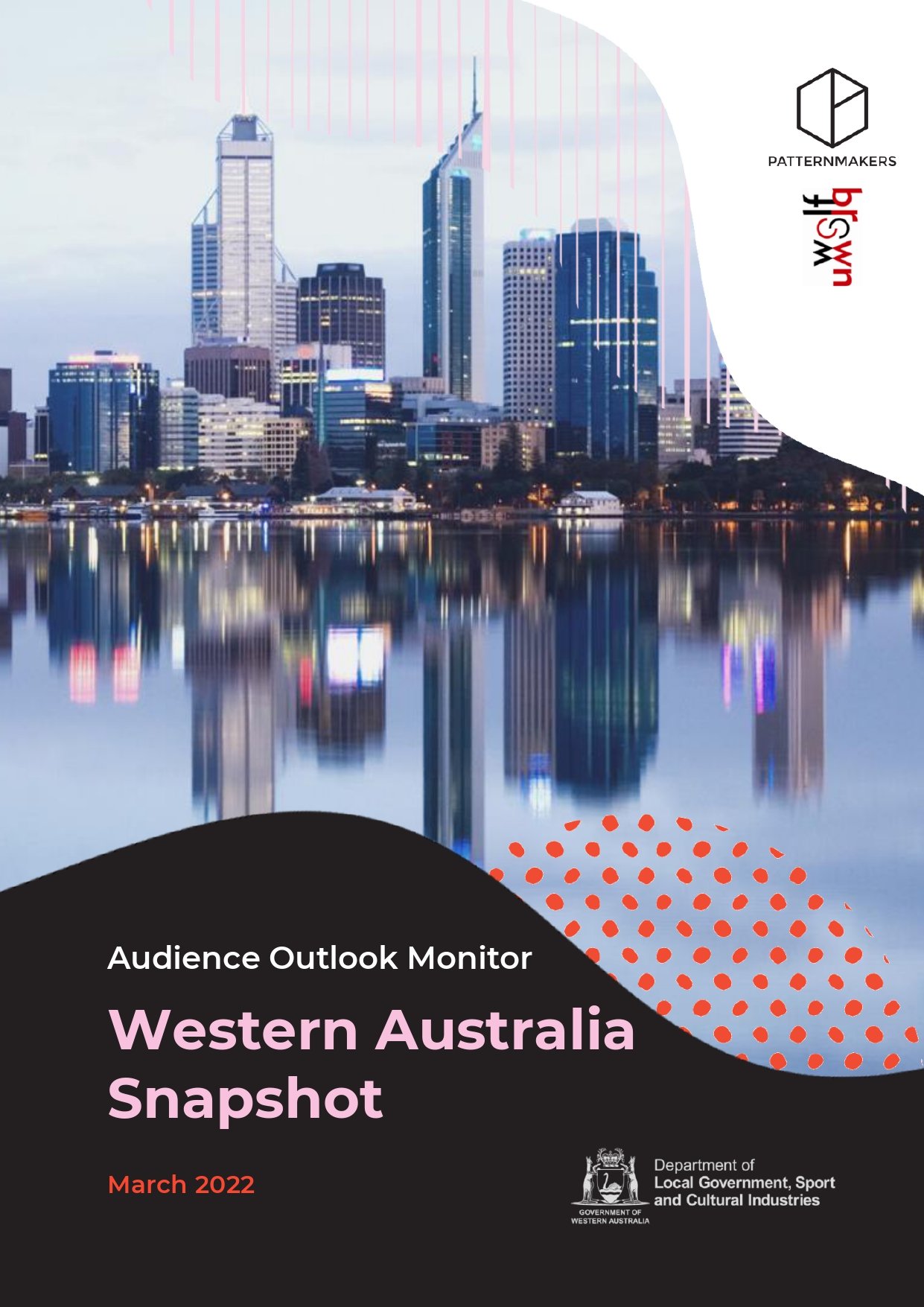
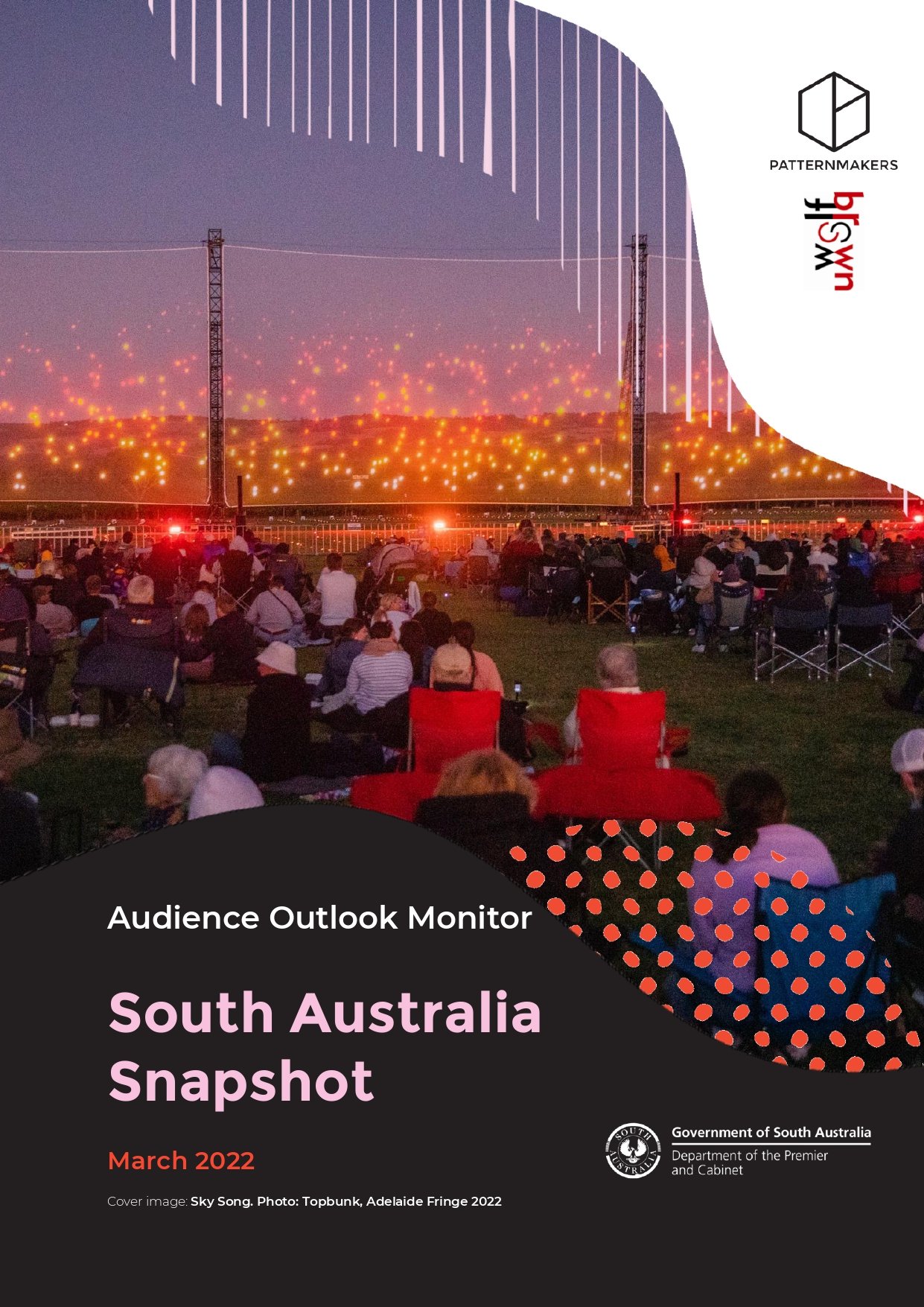
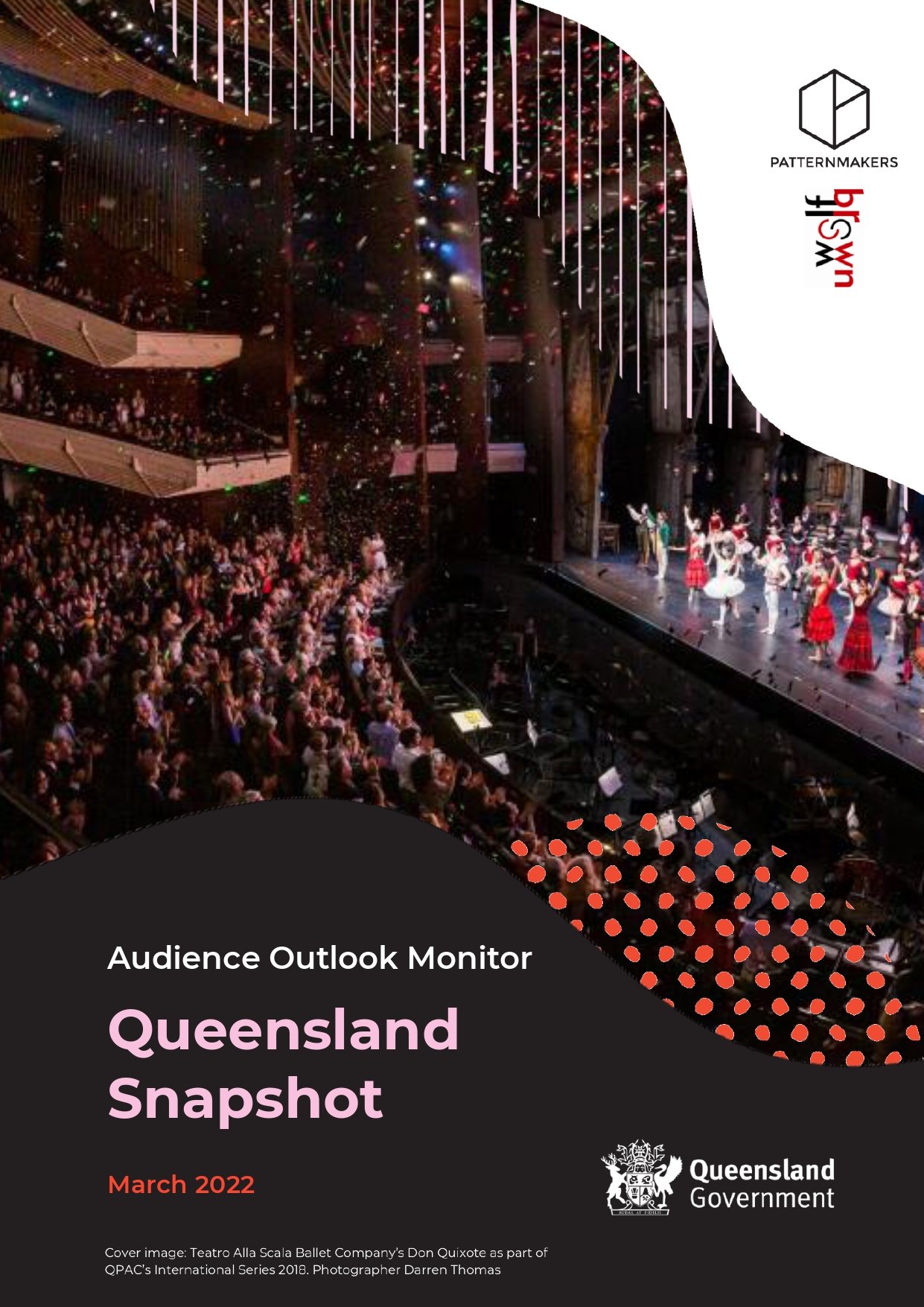
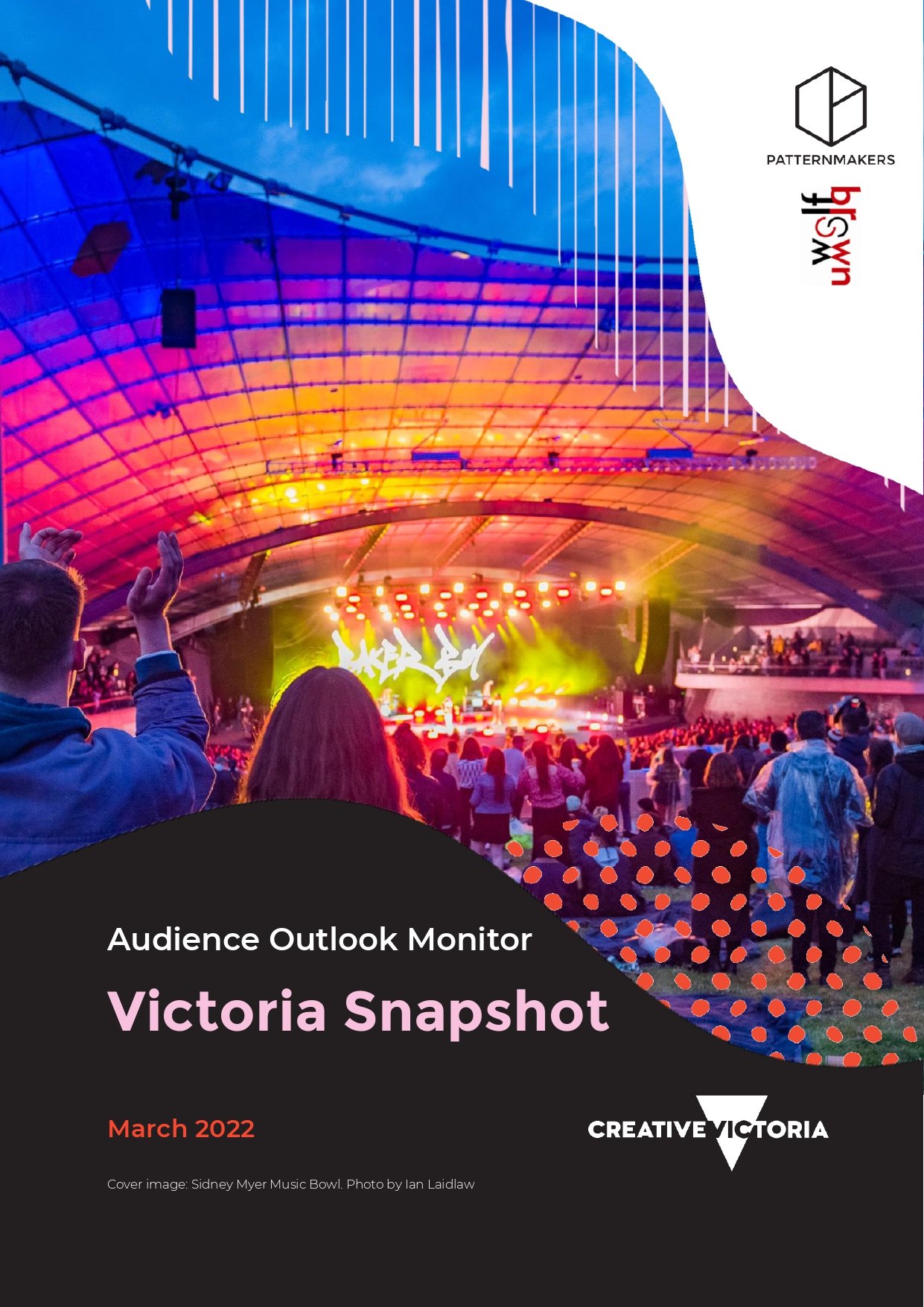
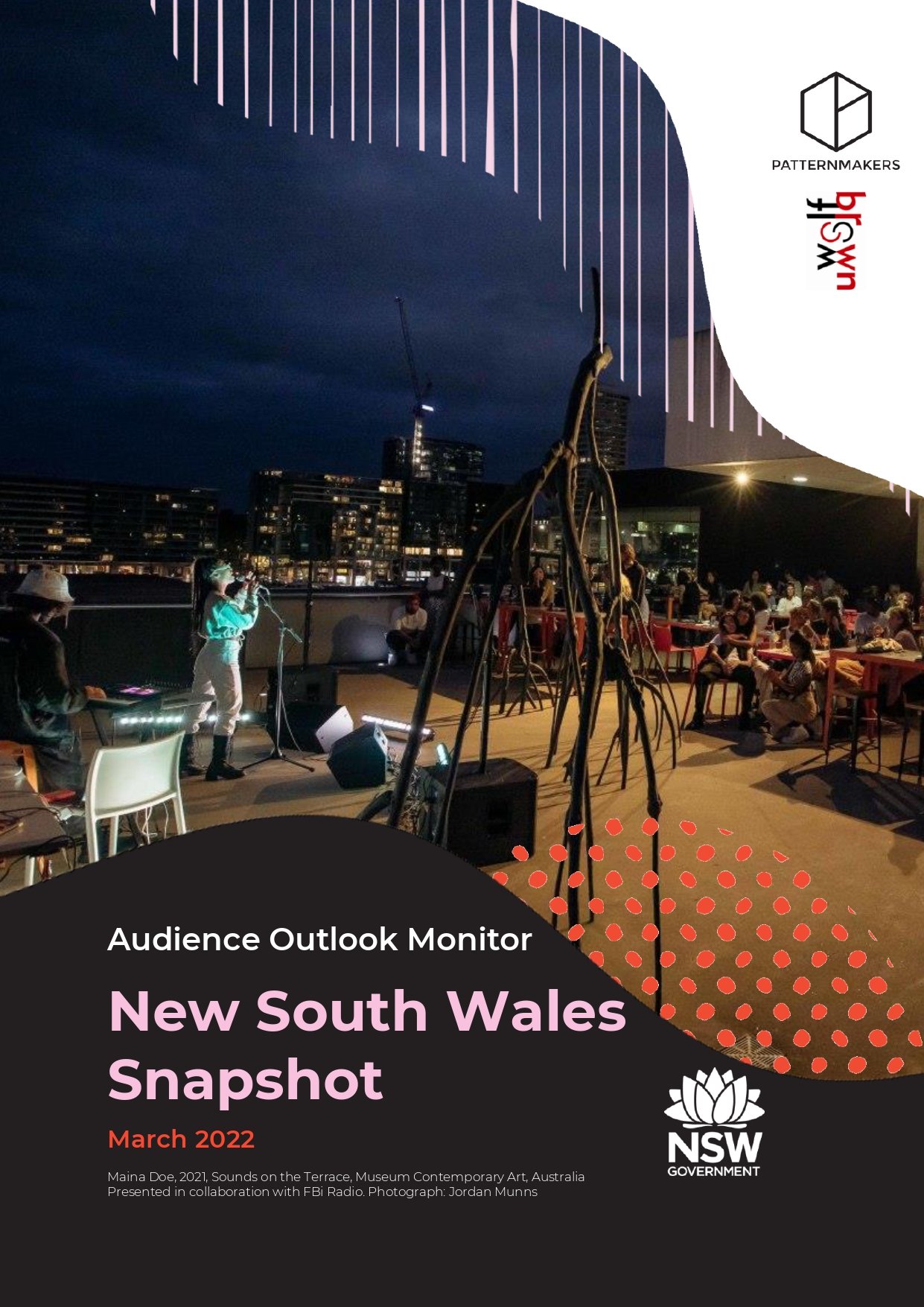
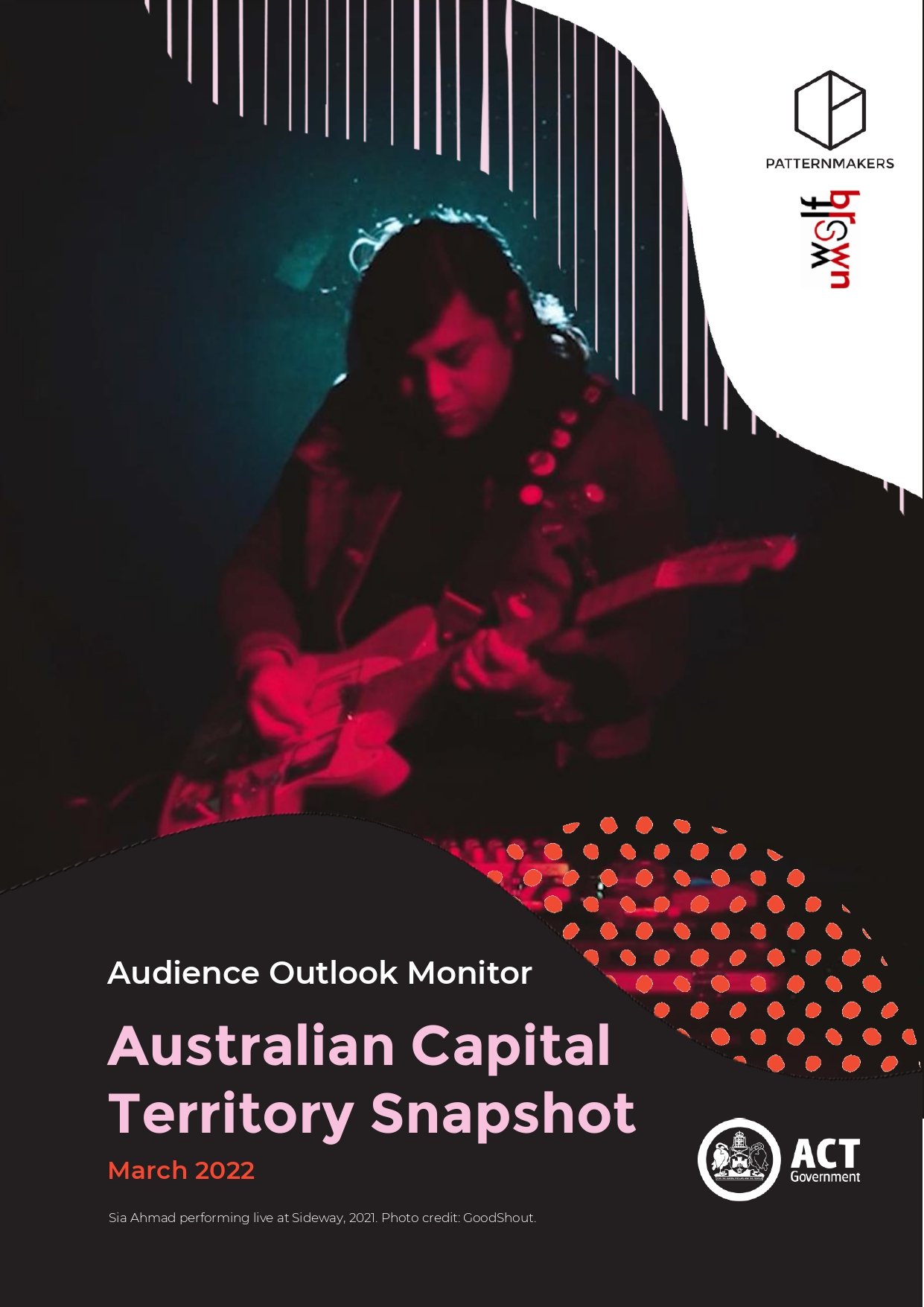
Use the dashboard to get results for your artform and region
Survey data from 8,300 respondents has been uploaded to the dashboard, which now contains insights from almost 90,000 Australian participants.
You can use the dashboard to explore the findings by state/territory, artform and audience segment.
It’s freely available to access, just click the image below and use the login details provided on the dashboard page.
About the Audience Outlook Monitor
The Audience Outlook Monitor provides the results of a study that has tracked audience sentiment over the course of the COVID-19 pandemic, including how audiences respond to changing restrictions on cultural events.
Data was collected in six phases throughout 2020 and 2021 and is again being tracked in 2022.
Government agencies across Australia are collaborating with research agencies Patternmakers (Sydney) and WolfBrown (USA) to produce this resource. The dashboard is freely accessible and designed to help artists and cultural organisations of all kinds to make the best possible decisions about re-opening.
How to find out more
To receive new releases directly into your inbox, as soon as they are available, you can opt in to receive Audience Outlook Monitor news below.
Subscribers to our regular Culture Insight & Innovation Updates will need to update their preferences to receive all updates about the Audience Outlook Monitor. Just enter your email below and follow the instructions provided.
If you have a question, or an idea for using this data, please contact Patternmakers at info@thepatternmakers.com.au
Subscribe for updates
About the Author
Tandi Palmer Williams
Managing Director
Tandi is Founder and Managing Director of Patternmakers. She’s an arts research specialist and leader of the agency’s research projects.
Delivery partners
Supporting partners
Past posts on this blog
- 2016 5
- 2017 8
- 2018 12
- 2019 11
- 2020 3
- 2021 7
- 2022 23
- 2023 21
- 2024 1
- About Patternmakers 35
- Accessibility 4
- Arts 73
- Audience development 79
- Beyond the Bio 8
- COVID-19 70
- Capacity building 3
- Career Advice 9
- Case Studies 2
- Coronavirus 2
- Culture 72
- Culture Panel 1
- Dance 3
- Data art 2
- Data culture 69
- Digital art 4
- Education 2
- Evaluation 75
- First Nations 3
- Indigenous 2
- Innovation 78
- Interviews 3
- Manifesto 1
- Opportunities 4
- Our services 4
- Performing Arts 5
- Postcode Analysis 1
- Privacy 6
- Project updates 25
- Publications 1
- Research 99
- Resources 6
- Strategic Planning 5
- Tandi Palmer Williams 7
- Theory of Creativity Podcast 1
- Thought leadership 16
- Tips & Tricks 13
- Toolkit 5
- Top 5 2
- Touring 3
- Trends 3
Key findings: March 2022
March 2022 results from of the Audience Outlook Monitor are now available, covering current attendance and spending levels, the most encouraging COVID safety measures and the outlook for cultural tourism in 2022.
Read about the findings and download the National Snapshot Report.
7 in 10 past attendees are back at cultural events, but half remain concerned about risks
In March 2022, data from 8,383 past attendees of cultural events suggests that attendance levels are increasing again, as we move past the January 2022 peak of the Omicron variant.
6 in 10 (59%) audience members say they are ready to attend cultural events ‘whenever permitted’ (similar to 60% in November 2021) while 4 in 10 have some level of risk-aversion.
Confidence levels are becoming more similar across the country as COVID-19 policies nationalise – rising in states like NSW, ACT and VIC and declining in states with newly-opened borders, like WA.
7 in 10 (70%) audience members say they attended an in-person event recently, the highest level seen since March 2021 (71%), before outbreaks of the Delta variant in the eastern states.
While the majority of audiences have received three shots of a COVID-19 vaccine (87%), attendance continues to be inhibited for many by the risks of transmission (52%) or being a close contact (43%).
Commentary from audience members suggests that concerns remain around transmitting the virus to those at-risk in their community – and 49% identify as being vulnerable to COVID-19 themselves or having someone in their household or network who is.
Some audience segments remain especially cautious, particularly those at risk of a serious health outcome (39% ready to attend) and those with a disability (43% ready to attend).
Download the National Snapshot Report or read on for more of the findings.
If you would like to request the report in an accessible format, please email info@thepatternmakers.com.au.
Vaccine passports remain the preferred COVID-safety measure, while masks still have a role
As the country moves into the next chapter of the pandemic, the data shows that some key COVID-safety measures will continue to play an important role in building confidence.
Most of those attending are satisfied overall with COVID-safety measures applied at recent cultural events they attended (79% satisfied), confirming the view of arts venues as relatively safe spaces.
But with 1 in 10 attendees dissatisfied, and more yet to return, there is a need for care as restrictions ease.
Audiences continue to be most encouraged to attend cultural venues by requiring proof of vaccination at entry (71% encouraged) – while only 46% are encouraged by Rapid Antigen Testing (RAT).
Nationally, around 65% find mask wearing encouraging for audiences aged 12 and over, but they appear to be more encouraging in states/territories where cases are higher than past phases, such as for WA audiences (72% encouraged, up from 38% in November 2021) and SA (70% encouraged, up from 59%).
As national guidelines allow for relaxing of restrictions, and Australians have the opportunity for greater freedom of movement, some audiences will be relying more upon the COVID-safety policies of individual venues to mitigate the risks of transmission.
In terms of the recovery process, some audiences feel strongly that cultural organisations can promote inclusivity and build trust among stakeholders by prioritising safety, and showing understanding and respect for those who are more vulnerable.
Attendances and spending levels are rising, but 70% of those making plans are still staying local
The data shows that audiences are optimistic about attending in 2022, with 4 in 5 (79%) making firm plans to attend an in-person cultural event (up from 74% in November 2021).
In a positive sign for economic recovery, arts audiences are reporting the highest spending levels since the pandemic started, with 63% spending more than $50 in the fortnight prior and 38% spending more than $100.
Shorter booking timeframes are still common across the country and 7 in 10 of those making plans are opting for local events, which are perceived to be less risky, and are seen as a way to support their communities.
Cultural tourism may take more time to recover, and while travel is increasing, audiences are currently four-times more likely to be travelling regionally or within their state to attend events (52%) compared to interstate (13%).
Lifestyle changes are also evident and 12% say their preference for attendance times has changed. There may be a case to review the days and times of events, as more are working from home and some want to avoid transport challenges or busy venues.
The arts continue to be perceived as vital to community recovery, providing an avenue for healing, joy and social connection during challenging times. While some audiences are yet to return, they are firm in wanting to support artists and help cultural activity to flourish in new ways.
Stay tuned for a Digital Engagement Outlook covering audience participation online and the key digital trends to watch in 2022.
Use the dashboard to get results for your artform and region
Survey data from over 8,300 respondents has been uploaded to the dashboard, which now contains insights from over 80,000 Australian participants.
You can use the dashboard to explore the findings by state/territory, artform and audience segment.
It’s freely available to access, just click the image below and use the login details provided on the dashboard page.
About the Audience Outlook Monitor
The Audience Outlook Monitor provides the results of a study that has tracked audience sentiment over the course of the COVID-19 pandemic, including how audiences respond to changing restrictions on cultural events.
Data was collected in six phases throughout 2020-2021 and is again being tracked in 2022.
Government agencies across Australia are collaborating with research agencies Patternmakers (Sydney) and WolfBrown (USA) to produce this resource. The dashboard is freely accessible and designed to help artists and cultural organisations of all kinds to make the best possible decisions about re-opening.
How to find out more
To receive new releases directly into your inbox, as soon as they are available, you can opt in to receive Audience Outlook Monitor news below.
Subscribers to our regular Culture Insight & Innovation Updates will need to update their preferences to receive all updates about the Audience Outlook Monitor. Just enter your email below and follow the instructions provided.
If you have a question, or an idea for using this data, please contact Patternmakers at info@thepatternmakers.com.au
Subscribe for updates
About the Author
Tandi Palmer Williams
Managing Director
Tandi is Founder and Managing Director of Patternmakers. She’s an arts research specialist and leader of the agency’s research projects.
Delivery partners
Supporting partners
Past posts on this blog
- 2016 5
- 2017 8
- 2018 12
- 2019 11
- 2020 3
- 2021 7
- 2022 23
- 2023 21
- 2024 1
- About Patternmakers 35
- Accessibility 4
- Arts 73
- Audience development 79
- Beyond the Bio 8
- COVID-19 70
- Capacity building 3
- Career Advice 9
- Case Studies 2
- Coronavirus 2
- Culture 72
- Culture Panel 1
- Dance 3
- Data art 2
- Data culture 69
- Digital art 4
- Education 2
- Evaluation 75
- First Nations 3
- Indigenous 2
- Innovation 78
- Interviews 3
- Manifesto 1
- Opportunities 4
- Our services 4
- Performing Arts 5
- Postcode Analysis 1
- Privacy 6
- Project updates 25
- Publications 1
- Research 99
- Resources 6
- Strategic Planning 5
- Tandi Palmer Williams 7
- Theory of Creativity Podcast 1
- Thought leadership 16
- Tips & Tricks 13
- Toolkit 5
- Top 5 2
- Touring 3
- Trends 3






















































